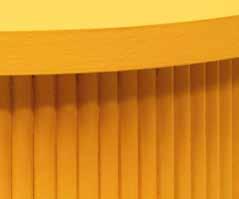MANUFACTURING GROWTH

www.industryupdate.com.au
projects – particularly in New Wales, and when you view this against a of robust global economic growth, opportunities are there for manufacturing to Bizarrely, the threat of a global trade war have worked in favour of Australian the short term at least – by softening the Aussie dollar.
“More Australian manufacturers are exporting under the Coalition Government. For every $1 of revenue the sector generates, 28 cents comes from abroad. That’s up from 23 cents a decade ago,” says Senator Cash.
PRODUCTIVITY PLUS FOR SAFE MOBILE PLATFORM
NSW to rebuild manufacturing industry
Nonetheless, the nation’s reliance on export increased in recent years. According for Jobs and Innovation Senator Cash: “Australia’s access to global markets will be fundamental to continued health and success of our local manufacturing industry.
export more than $20 billion a year than we did a decade ago. Australian have, in fact, sold $2.7 trillion to the economy over the last decade.

Besa Deda from St.George also sees positives in the manufacturing employment statistics. “Although manufacturing employment as a proportion of the economy as a whole is in a long-term decline, the recent gains are encouraging,” she says, pointing to nearly 10,000 new manufacturing jobs and increasing capital expenditure plans in the sector.
fewer jobs, billions of government procurement dollars sent overseas and a poor skills base.

At a recent roundtable with manufacturers, one participant described NSW as the least hospitable state for manufacturers.
One word of warning, though, comes from financial analyst illion, which noted in its most recent Australian Business Expectations Survey that one in three manufacturers had reported customers or suppliers become insolvent or unable to pay them in the preceding 12 months, highlighting cashflow as the second-biggest barrier to growth in the year ahead, after utilities and operating costs
The NSW Labor government will
Now available at a one-off price of $400 and with significant discount for quantity orders, the DarDeck safe step platform can pay for itself in efficiency gains. And the improved safety it brings to any warehousing, retail or maintenance environment could save a fortune in workers compensation and public liability payouts.
By Courtney Houssos, the Minister for Finance, Minister for Domestic Manufacturing and Government Procurement and Minister for Natural ResourcesIn February, the NSW government announced $275 million for our Net Zero Manufacturing Initiative. The clean energy future will be built on the manufacturing of solar panels, storage and fuels.
The move to Net Zero will transform our economy and these grants ensure NSW
600 Machine Tools rebrands to Colchester

Designed as a simple and more productive alternative to unstable stepladders and unguarded low work platforms, the Australian designed and manufactured DarDeck combines a solid working platform with safety rails to prevent

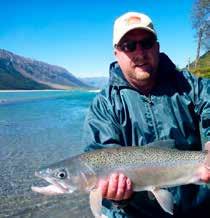




NSW is home to a range of highly innovative, sustainable, competitive and world leading manufacturers and technology providers in industries such as fabrication and component production, health and life sciences, food and beverages, defence and space.

The NSW Government is committed to advancing our manufacturing sectors through programs to support workforce skills and development, exports, sustainability, innovation, research and development and much more.
Visit investment.nsw.gov.au/priority-sectors/advanced-manufacturing to learn more about how the NSW Government supports our manufacturing sectors to grow and embrace advanced manufacturing.
Visit the NSW Government stand RA350 to see great examples of the broad range of advanced technologies and products NSW businesses are using and making.
The NSW Government stand at Australian Manufacturing Week features organisations dedicated to supporting NSW manufacturers. Connect with industry experts and advisors from:
Facilitates economic development and attracts investment, reinforcing NSW as the most desirable place in the world to visit, study, invest and do business.
The WPCA’s Advanced Manufacturing Research Facility (AMRF) is the first of its kind in Australia, providing a unique offering that will bring industry, research, and education to the heart of the Western Sydney Aerotropolis.
Plays a crucial role in facilitating the planning, implementation and delivery of talent attraction and training initiatives. Its primary objective is to develop a skilled, work-ready pipeline of workers to meet the needs of NSW industry.
The workplace health and safety regulator in NSW.
Serves as a catalyst for business expansion, connecting local manufacturers with companies eager to enhance their supply chains, drive innovation, and explore new collaborations.
A not-for-profit innovation network funded by the NSW Government through the Office of the NSW Chief Scientist & Engineer. It brings together universities, industry, and government to translate world-class research into innovative smart sensing solutions that create value for the economy, environment, and society of NSW and beyond.
LAST CHANCE TO ATTEND OUR FUTURE VISION NEED LOW-COST AUTOMATION? DON’T
MISS THIS EVENT!
Far too big for any booth, a specially assigned 1,000 sqm area WITHIN OUR SYDNEY STORE, has been set aside to demonstrate how technical advancements in modern machinery and automation will increase your business efficiency and profit.
More than ten brand-new cutting-edge machines sourced from around the world will be on display and used over the three days, at our Sydney store. Unit 1, 2 Windsor Road, Northmead, NSW.
This is a strictly RSVP event, so please confirm your attendance quickly to avoid disappointment



RSVP NOW & ATTEND TO WIN $1,000!
Simply RSVP and attend Future Vision 2024, to win one of 5 x $1,000 Gift Cards
Meet Danny Sims, Head CNC Machinist from Brad Jones Racing, as well as representatives from UNIMIG Welders, Brobo Machinery, Bramley Manufacturing Equipment, Sutton Cutting Tools & Pilot Air Compressors.
Robotic Automation Systems
5-Axis Machining Centres
3 & 4
Axis Machining Centres
Multi Axis CNC Turning Centres
CNC Plasma Cutting Machines
Synchro CNC Pressbrakes RSVP HERE SYDNEY 2024 APRIL 17-18-19













MAKING IT IN MANUFACTURING IN NSW NSW to rebuild manufacturing industry
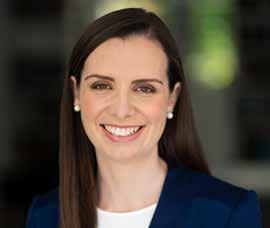
manufacturing is part of the revolution. The state’s leading critical minerals and high-tech metals deposits combined with the central role we play in Australia’s financial sector, makes NSW the perfect place to begin manufacturing these critical products.
We’re also investigating the best ways to invest government procurement dollars to stimulate growth in the state’s domestic manufacturing industry because every new job in manufacturing creates three-and-a-half more in the supply chain.
Last year, the government initiated a parliamentary inquiry into procurement to ensure the prioritisation of local content.
When we went to the election last year, we committed to creating a Jobs First Commission. It will oversee the implementation and growth of local industries, supporting and advocating for local firms bidding for government tenders.
We further committed to increasing local
“Every new job in manufacturing creates three-and-a-half more in the supply chain.”
content for tenders, including a target of 50% minimum local content for future rolling stock transport contracts.
Soon, we will start the procurement process for the next set of trains to replace the ageing Tangara train fleet. This will create at least 1,000 long-term jobs, including 200 apprentices.
Having a pipeline of skilled workers is crucial, and our new TAFE Manufacturing Centres of Excellence in the Illawarra, Hunter and Western Sydney will help create the workforce we need. This is a whole-of-government effort, being undertaken in collaboration with industry.
To boost opportunities, we are employing an additional 1,000 apprentices and trainees across the public sector.
We are delighted to be the main sponsor for Australian Manufacturing Week 2024 and to host the NSW government stand. It will highlight exciting new opportunities and connections with NSW government organisations to help businesses grow, including:
• Investment NSW, which develops and delivers the NSW government’s trade, industry development and investment programs. It focuses on business growth activities in emerging and established industry sectors
• The NSW Smart Sensing Network, which is helping companies gain an enduring competitive advantage by accessing expertise and technology from NSW’s leading universities. It’s exploring new frontiers in additive manufacturing, predictive maintenance in machines and infrastructure and optimisation of supply chains with new logistics models
• Training Services NSW is working with Investment NSW to provide skills training and award-winning workforce programs to help manufacturers meet their environmental sustainability obligations, the challenges of evolving digital skills and reimagining business models to align profitability with sustainability in the transformative move towards Net Zero
• SafeWork NSW, the workplace health and safety regulator in NSW is dedicated to working with businesses to ensure safe working environments. SafeWork Inspectors will be on hand to answer your questions
Over the next decade, Australia’s manufacturing sectors will undergo significant transformation. Driven by global technological and geopolitical trends, components of the
THIS IS
Continued from front cover
manufacturing value chain will evolve to be more automated, connected, repeatable and sustainable.
“A pipeline of skilled workers is crucial and our new TAFE Manufacturing Centres of Excellence…will help create the workforce we need.”
Unprecedented investment in NSW and in the manufacturing powerhouse that is emerging in Western Sydney, is already being leveraged to build a world class innovation ecosystem and drive domestic manufacturing.
In regional NSW manufacturing is diverse, shaped by the unique geographical strengths of each area and the close associations between innovators and primary producers in agriculture, mining and forestry.
The NSW government is committed to attracting further investment and to helping our existing manufacturers find new markets, embrace advanced manufacturing and grow their operations.

Welcome to the latest issue of Industry Update magazine, which is a special one. In co-operation with the NSW Government and Investment NSW, Industry Update is proud to present the largest feature that we have ever published at 62 pages and all on manufacturing in NSW.
In this edition we are highlighting the government initiatives and companies that have worked to make NSW the largest manufacturing state in Australia.
April is a big month for the industry, with Australian Manufacturing Week being held in Sydney April 17-19. More than 6,764 square metres of exhibition space will be dedicated to over 270 organisations showcasing the latest manufacturing technologies, processes and support services.
Not only is the must-visit event the nation’s premiere manufacturing solutions expo, it is also a celebration of all aspects of manufacturing.
The NSW Government’s decision to sponsor the event is a sign of its investment in the industry.
Minister for Domestic

Manufacturing and Government Procurement, Courtney Houssos recognises that every job in manufacturing creates three-and-a-half more in the supply chain, which is why she is committed to making NSW Australia’s leading manufacturing state.
Recent investments include $275 million for the Net Zero Manufacturing Initiative to build the state’s future on clean energy, including solar panels, storage and fuels. This was backed up by the federal government’s recent announcement of $1billion to manufacture solar panels in the Hunter Valley, a region previously known for coal mining.
Over the next decade, as Australia moves to become a key global player in the manufacturing of solar panels, its manufacturing sector will undergo a dramatic transformation.
Investment by government at all levels, which includes support and training as well as funding, means the future is looking bright when it comes to building a renewable future that’s made in Australia.
See you at AMW 24!!
NSW wind farm to power 700,000 homes
A1500 megawatt wind farm known as Yanco Delta is set to generate enough energy to power 700,000 homes in New South Wales.
Minister for Environment and Water Tanya Plibersek announced the farm today, saying it is one of the country’s biggest clean energy projects.
Yanco Delta will include the construction of 208 wind turbines, an 800 megawatt battery and grid connection infrastructure. Its site is ten kilometres north-west of Jerilderie on a 33,000-hectare site in the Murrumbidgee and Edward River Local Government Areas.
The project will save up to nearly 5 million tonnes of greenhouse gas emissions every year — equivalent to taking 1.5 million cars off the road — a big step in the government’s plan to make Australia a renewable energy superpower.
Minister Plibersek said years of political fights over climate change have cost Australia “big time” by keeping emissions higher for longer and postponing renewable energy projects for years.
“We want to unlock Australia’s potential to be a world leader in

renewable energy. It’s a huge task –we’re remaking our entire energy system.
“Our government has shown just how bright Australia’s future can be when there’s less political fighting and more action on climate change.”
The government says this project, while great for energy and the environment, will also support up to 300 jobs in construction and 30 ongoing jobs.
Minister Plibersek said the project has been approved under Australia’s environment law after careful assessment of the environmental impacts. It is able to proceed with strict conditions to protect nationally protected threatened species including the superb parrot and the plains-wanderer.
Element14 transforms product life cycle support

The new Design, Build, Maintain HUB from element14 will be a game changer for electronic components and solutions. It streamlines product development, saves time, and ensures operational efficiency for customers across industries.
This innovative platform was created to support how developers, OEMs
and industrial customers navigate every stage of the product life cycle, from conception to maintenance.
Element14 is a distributor of products and technology for electronic and industrial system design, maintenance and repair. Its Global Head of Technical Marketing Cliff Ortmeyer believes the HUB will set a new industry standard.
“Element14 distinguishes itself with our distinctive in-stock offerings, covering every aspect of OEM and EMS requirements. Our goal is to be the one-stop-shop for all electronic components and solutions required throughout a product’s lifecycle,” he said.
“This HUB will serve as a valuable resource to all customers, particularly OEMs and industrial clients, providing access to a diverse range of products and technical resources.”
The design phase is crucial for successful product development, so developers will be pleased that element14’s HUB provides them with
access to a vast array of in-stock components essential for design and prototyping, streamlining the development process and accelerating time to market.
It boasts over 13,000 development kits and evaluation boards, allowing customers to explore the latest technologies from leading suppliers across the globe. element14 consistently adds over 5,000 new products monthly on average, ensuring access to cutting-edge solutions.
To support the build phase, element14 offers a comprehensive selection of electronic components, including semiconductors, electromechanical parts, wires and connectors, hardware, and product build accessories. With products sourced from over 2000 leading manufacturers, customers can find everything they need in one place, saving time and resources.
Element14’s maintenance and repair solutions encompass a wide range of automation and control
solutions, production supplies, and industrial tests and tools to help ensure operational efficiency and safety. These essential products help customers keep their facilities running smoothly, ensuring employee safety and minimising downtime.
The HUB will also showcase new manufacturers, technical resources, and key industrial initiatives such as element14’s energy-saving solutions and Industrial minilog that features over 300 product highlights from suppliers, new technology and technical articles. The minilog includes categories like industrial automation and control, fans, power, relays and fuses, sensors, switches, test and measurement, tools and production supplies, SBCs, cables and connectors.
Training Services NSW supports transition to advanced manufacturing practices
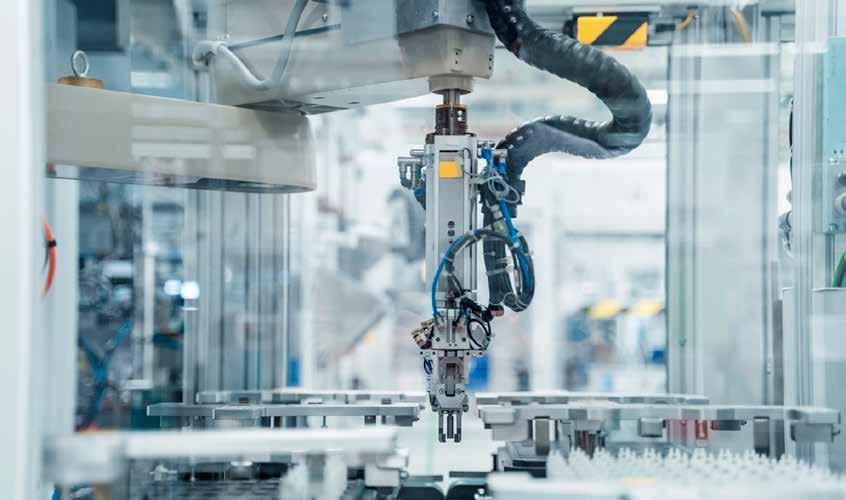
The Workforce Development team at Training Services
NSW (TSNSW), a division of the NSW Department of Education, plays a vital role in facilitating the coordination and support of talent attraction and training initiatives. Its main goal is to foster the development of a skilled workforce that meets the needs of various industries in NSW. It achieves this by supporting apprenticeships and traineeships, providing subsidised training through programs like Smart and Skilled and offering adult and community education opportunities.
Navigating the Vocational Education & Training (VET) system can be challenging due to its complexity, including diverse training programs and funding options. To address this complexity, TSNSW collaborates with employers, industry stakeholders, training providers and government bodies to identify barriers and develop tailored solutions based on individual needs.
Driving digital skills
The Driving Digital Skills program, a collaborative effort between Investment NSW, TSNSW Workforce Development, and industry partners, aims to support NSW manufacturers in transitioning to advanced manufacturing practices.
This initiative is driven by the recognition of the industry-wide demand for digital skills, particularly in light of the transition to Industry 4.0. This program aims to help businesses understand the opportunities and benefits associated with Industry 4.0 and the adoption of digitalised operations.
Since its inception in early 2022, the program has undergone several pilot stages, incorporating continuous improvements based on industry feedback and consultation.
FutureMap and tailored training
The program starts with business leaders using a diagnostic tool called futureMap™ to assess their progress toward Industry 4.0. This tool provides insights and recommendations for improvement, helping businesses identify areas for growth.
Following this assessment, businesses can access a range of training options tailored to their specific needs in digital upskilling. These training opportunities are currently fully subsidised by the NSW Government through Smart and Skilled.
Climate impact reporting and ESG Building on the success of the
Driving Digital Skills program, a similar approach was adopted in response to the emerging need for climate impact reporting, particularly with impending mandatory carbon emissions reporting for large businesses across Australia from July 1, 2024.
Recognising the urgency, the Workforce Development team collaborated with Investment NSW and industry partners to develop the Driving Sustainable Advanced Manufacturing program.
Commencing in February 2024, this program offers training across three key operational areas within the manufacturing sector including:
• Business leadership
• Team management
• Shop floor operations
The training focuses on areas such as Environmental, Social, and Governance (ESG), carbon emissions tracking, sustainability, and energy audits. Businesses can utilise the futureMap™ sustainability tool to identify their training needs and access government-subsidised training in accredited units, including an introductory ESG course – a first of its kind in Australia.
For more information on the Driving Digital Skills Program or the Driving Sustainable Advanced Manufacturing Program, please contact tsnsw.workforce.development@det.nsw.edu.au
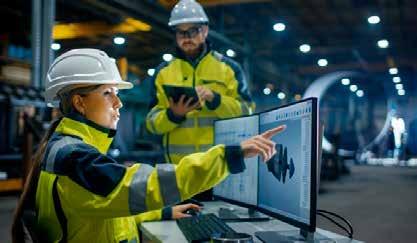
ANUFACTURING IN NSW
Manufacturing excellence the heart of our newest city, Bradfield City Centre
by Ben Kitcher, Executive Director of the Advanced Manufacturing Research Facility

New cities rarely happen. In Australia, the last major city to be built was Canberra100 years ago.
A new city built around advanced manufacturing technology is rarer still - a potential global first, in fact.
With this extraordinary foundation, we have the chance to make Bradfield City Centre, and Western Sydney more broadly, the place – globally – for manufacturing excellence.
The opportunity to participate in the development of a new advanced manufacturing centre at the heart of a new city is significant.
Across the Western Sydney Aerotropolis, unprecedented investment in world-class infrastructure will facilitate the growth of factories and related services, seamlessly linking them to local and global markets.
Bradfield City Centre sits at the epicentre, providing a great place to live,
work and innovate. The Advanced Manufacturing Research Facility (AMRF) will be the first organisation to open its doors in the new city, setting the tone for what is to come.
So, what can we expect from the AMRF?
The AMRF will activate the manufacturing ecosystem in Bradfield City Centre and across the wider Western Sydney region, targeting focus industries such as advanced manufacturing, space, defence, medtech, logistics, research and development, new energy, and the circular economy.
Connecting businesses with each other and further opportunities, the AMRF will provide services to manufacturers which want to implement next-generation manufacturing technologies, helping define, develop, and implement solutions which unlock greater productivity and new markets.
From its first facility, the AMRF will offer businesses the opportunity to develop capability and staff skills in advanced machining methods, additive manufacturing, composites production, process digitisation, and automation. AMRF machinery, systems, and facilities will all be of industrial scale, quality, and relevance, providing the perfect platform to develop methods which can be transferred easily into existing factories.
Providing front and back-end support with projects, the AMRF will ensure designs are optimised
projects, is what will set us apart.
The AMRF will also provide a platform to mentor a new generation of technology leaders that will proliferate people within businesses across the NSW manufacturing industry, helping to drive growth.
What’s next?
We are gearing up to launch the AMRF, with doors set to open later this year. All the essential parts are nearing readiness.
We have taken input and feedback from across industry to shape the capabilities to be offered. We have engaged suppliers across Australia and the world to work with us in the delivery of capabilities.
We have engaged universities across NSW to draw upon the immense expertise embedded within laboratories.
We are building the facility. And we have launched the Invitations for First Projects, with nearly thirty businesses expressing interest in collaborating with the AMRF.
for modern manufacturing methods and processes developed are qualified for their intended purpose.
The principles of collaborative manufacturing development centres which underpin the AMRF are not foreign to Australian institutions and businesses. However, until now limited investment has meant we could not create anything comparable to international centres of excellence.
To address broad industrial requirements and deliver meaningful impact, scale and commitment are key.
Building on the broad industrial shoulders of the Western Sydney manufacturing industry, the NSW government has invested more than $300 million in the AMRF, a significant investment that will provide the scale needed to achieve outcomes.
It will unify a wide range of advanced manufacturing capabilities under one roof, providing the seamless delivery of capabilities not yet seen in Australia.
The key to unleashing these capabilities, and to make them accessible and easy for businesses to adopt in a profitable and timely fashion, is the staff of the AMRF.
NSW government investment in the AMRF will build a team of manufacturing engineers who will be available to support a wide range of technical projects simultaneously, and with ongoing availability.
AMRF’s expert staff, with their industrial knowledge, experience of the latest technology, and readiness to guide businesses through their
Respondents have approached the AMRF with a huge range of concepts for projects, from modelling new factories to optimising investments through to the development of new and improved processes for additive, composite, and machined parts.
Areas of applications include space, medical devices, and sports goods.
One theme stood out strongly: our manufacturing industry recognises the value of technology and the AMRF’s potential to lower barriers and increase success in its implementation.
The AMRF’s objective for these businesses and others in future, is to provide the tools and methods necessary to generate industry growth, increase productivity, and ultimately, to re-establish Australia’s position as a leading manufacturing economy and trading partner for high-value manufactured goods. However, without manufacturing industry participation, the AMRF cannot achieve its objective.
The AMRF needs industrial partners to collaborate in the delivery of services to manufacturers, to support the strategic direction and growth of the AMRF, and most importantly to take up the capabilities and skills generated.
We cannot wait to unveil what we have to offer.
The unlimited opportunities to engage with the AMRF and use its network to engage with other industrial partners for supply, sourcing, or collaborative ventures is vast … get involved!
ICN NSW champions the manufacturing revival
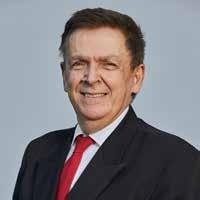
At the heart of Australian Manufacturing Week lies Industry Capability Network (ICN), a pivotal force in driving manufacturing excellence across the state. ICN is a catalyst for industry growth, connecting local manufacturers with companies eager to enhance their supply chains, drive innovation and explore new collaborations.
Companies like Brumby Aircraft relied on overseas manufacturing in China for cost-effective production. Disruptions of the pandemic led to
soaring costs and delays, prompting a shift in strategy. Brumby Aircraft pivoted to local manufacturing in Cowra, leveraging ICN NSW’s support to streamline operations. Similarly, ICN assisted Ares Group in optimising its multi-million dollar projects by facilitating the movement of oversized cargo across Australia.
Small and medium enterprises are the backbone of Australian manufacturing, and at Australian Manufacturing Week, ICN showcases its range of tailored services and initiatives to support the sector. From its vast network of local manufacturers to its strategic specialists positioned in Western Sydney, regional NSW and North Sydney, ICN provides unparalleled expertise and support to businesses navigating the complexities of the manufacturing ecosystem.
ICN’s flagship offering, the ICN Gateway platform, streamlines supplier sourcing and facilitates connections between buyers and suppliers. Whether companies are
reshoring operations or exploring innovative solutions, ICN Gateway offers curated sets of suppliers and expert guidance to drive success.
Moreover, ICN’s collaboration with the NSW Government underscores its commitment to fostering economic growth and local manufacturing capabilities. As Australian Manufacturing Week unites industry leaders, innovators, and stakeholders, ICN stands poised to help shape the future of manufacturing.
Whether seeking to reshore operations or optimise supply chains, businesses can rely on ICN’s extensive connections, expertise and support to unlock the full potential of local manufacturing, driving success and prosperity across New South Wales.
Modern Manufacturing Manager, Marcus Batten said ICN aims to help bring together and build engagement between local suppliers and manufacturers.
“Our goal is to support local manufacturers in increasing their scale, justifying capital investments
for processes, expansion, or innovation. We aim to emphasise the value of ICN’s (alongside the NSW Government’s) contribution, helping manufacturers perceive ICN as an asset that facilitates supply chain matching services,” he said.
“We strive to foster a local and in-country manufacturing community that is interconnected, empowered and actively engaged in delivering advanced manufacturing as an Australian standard, led by NSW.
“Central to this endeavor is aiding manufacturers in discovering and nurturing local trade talent, while reassessing approaches to industrial automation and total quality management to align with business growth opportunities. The priority is to assist them in staying current with sustained, ongoing and optimised manufacturing practices, while being mindful of using the most suitable systems to ensure sustained output and profitability as desired outcomes.”
SVSR expands into bespoke manufacturing
When SVSR started in 2005, it was grounded in sewer vent installation solutions. It has since grown to servicing the building industry with steel frames and trusses, becoming an end-to-end manufacturer.
R&D Manager Duncan Reynolds said the company’s experience working with Sydney Water as well as Tier 1 and Tier 2 contractors has given SVSR important design and compliance experience.
“We are bespoke manufacturers,” he said.
“We guide clients through every step of the process from design to manufacture to installation. Our experience and knowledge means we can quickly navigate changes to adapt to clients’ needs.”
Covid was a turning point for the company. The problems with supply chain issues meant SVSR had to diversify the business.
“We had a lot of experience with compliance and certification. Covid meant we really needed to shift our focus from just importing materials, because the lead times were too long,” Reynolds said.
“The company broadened its supplier base and shifted to digitisation
and automation due to the skills shortage, like welding, design and drafting.
“We were getting asked by Tier 1 companies to do many of these jobs, so we took it upon ourselves to upskill. Within all of that we are trying to be more sustainable.
“Rather than focusing just on delivering a part for a process, we’ve used our end to end life experience to get into design, certification and installation. We know how things work onsite and it gives us feedback which informs design changes we can use further on.
“The whole of life approach to manufacturing is critical. We can’t necessarily compete on costs with imports, so our niche has to be our knowledge in these areas.”
Reynolds has worked in the manufacturing industry since he was 15 and said it’s unrecognisable to what it was in the 90s.
“It was all about cost and compliance. Now we are looking at digitalisation and automation,” he said.
“We need to learn all of this as mid-career professionals, which is quite the challenge.
“Manufacturing always amazes me. We are a SME, there are nine of

us, but when I have conversations with defence contractors and manufacturers who build submarines, I’m blown away by how much we have in common, no matter what we make.
“We all have the same issues, upskilling, shortages, compliance and cost. Manufacturing is definitely a way of thinking rather than just a job.”
M AKING IT IN M ANUFACTURING IN NSW

Regional NSW manufacturing: resilience, growth and grit
By Ian Smith, Department of Regional NSW, Executive Director Office of Regional Economic Development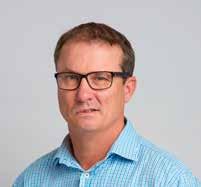
Ian Smith, Department of Regional NSW, Executive Director Office of Regional Economic Development
The vast expanse of NSW, beyond the bustling metropolis of Sydney, is home to a thriving network of regional hubs thanks to a manufacturing renaissance. NSW boasts the largest manufacturing sector in Australia, with 25,000 businesses creating 30% of Australian manufacturing output.
Regional NSW is home to manufacturing powerhouses including Bega Cheese, Nestle, Sanitarium, Thales, Bisalloy, Bluescope Steel and many more.
Diversity defines manufacturing in regional NSW. Each area possesses its own unique strengths, shaped by geographical features, historical legacies and local expertise.
In the Hunter region, known for its coal mining heritage, manufacturing has evolved using the skilled workforce to drive growth industries such as defence, aerospace, clean technology, machinery and equipment manufacturing.
Meanwhile, the Riverina region, renowned for its agricultural abundance, thrives in food processing, packaging and agricultural machinery manufacturing. The Central West, with its rich mineral deposits, has fostered a strong presence in mining equipment, technology and services.
One of the driving forces behind manufacturing’s success in regional NSW is its close ties to the primary industries that dominate these areas. Agriculture, mining and forestry provide a steady stream of raw materials, creating a synergy between sectors.
This integration not only adds value to raw materials but also fosters innovation as manufacturers work closely with primary producers to develop cutting-edge technologies and processes. For instance, agricultural machinery manufacturers in the New England region collaborate with farmers to design equipment tailored
to the area’s specific needs, enhancing productivity and sustainability.
Furthermore, manufacturing in regional NSW thrives on the largest regional workforce in Australia with 58% holding tertiary qualifications. Of these, 22% have science, technology, engineering or mathematics qualifications. To leverage the strength of this mighty workforce, the team at the Department of Regional NSW has a range of workforce development programs to ensure the capabilities of local employees are aligned to the demands of rapid industry growth and business success across sectors with a focus on manufacturing.
Regional NSW is home to over 100 Technical and Further Education facilities and over 150 higher education science and research facilities.
The NSW government is committed to reducing red tape and planning timeframes for businesses

investing in regional NSW. At the forefront of this mission is the ongoing commitment to Special Activation Precincts. These worldclass business hubs in Wagga Wagga, Parkes, Moree and Snowy Mountains along with three regional job precincts in Albury, South Jerrabomberra and the Richmond Valley, offer streamlined planning approvals to enable infrastructure and are ideal locations for businesses looking to grow.
With well-established air, rail and road infrastructure, plus connectivity to deep-water ports at Port Kembla and Newcastle, regional NSW is strategically positioned to service some of the largest consumer markets in the world.
For example, the Wagga Wagga Special Activation Precinct located on the inland rail, houses the Riverina Intermodal Freight and Logistics (RiFL) hub, with overnight access to international ports along with 75% of Australia’s population.
‘With’ is confusing …. Can we instead say ‘The RiFL has overnight access to international ports along with 75% of Australia’s population.’
“Manufacturing in regional NSW is …. about building communities, fostering innovation and driving economic growth.”
The government continues to support manufacturers in regional NSW through its robust policy and funding initiatives, having just announced the $275 Net Zero Manufacturing Fund which complements the unprecedented $3 billion commitment to world-leading hydrogen strategy.
Manufacturing in regional NSW is not just about making products—it’s about building communities, fostering innovation and driving economic growth.
From the fertile plains to the rugged hinterlands, regional manufacturers embody the resilience and ingenuity that defines the Australian spirit. As they navigate the challenges of a rapidly changing world, they stand poised to seize new opportunities and continue shaping the future of manufacturing in regional NSW.
Smart sensors increase advanced manufacturing efficiency and productivity

NSW Smart Sensing Network’s Sam Ashby outlines how the agency helps companies unlock outstanding research capabilities for a competitive advantage.
Smart sensing is changing the way we manufacture, communicate, work, move and live.
For advanced manufacturers who want to count, sort, weigh, measure or monitor anything, smart sensing can provide increased efficiency and productivity.
To understand the technology, you first need to recognise that sensors detect, diagnose, monitor and respond to the world around them, allowing pre-emptive and predictive responses in a vast range of settings.
This technology is already part of our daily lives, found in even the most basic technology in our homes, offices and cars. But it is the next generation of sensors, known as smart sensors, where the exciting discoveries lie, which will shape our future economy and society.
Such sensors can be wireless, distributed, and networked to power the Internet of Things, Industry 4.0 and ‘smart’ cities.
The rapid progression of chip manufacturing has led to a surge in accessibility to compact computers that can perform complex calculations — in a single device that fits in
the palm of our hands.
The surge of AI also feeds into this. Certain tasks are best done autonomously on the device, rather than sending massive loads of information across the network.
Connecting this so called ‘edge-computing’ capability with traditional sensors, for example measuring temperature or air quality, provides deeper insights about how our environment is changing.
technology from across NSW’s leading universities and gain an enduring competitive advantage.
The NSSN is a not-for-profit Innovation Network funded by the NSW Government through the Office of the NSW Chief Scientist & Engineer.
“Smart sensors… will shape our future economy and society.”
Only the key important features need to be transmitted for decision making.
Some examples are classifying audio sensor data to look for endangered wildlife or analysing the movement of crowds without storing raw CCTV footage.
These applications drive the automation, AI and robotics that will revolutionise the way we grow food, generate energy and make things.
The additional data gathered has already allowed major advantages in tracking the supply chain of manufactured goods – and there is more to be done here.
Through partnering with the NSW Smart Sensing Network (NSSN), companies can access expertise and
cells, glucose biosensors, and energy conversion using renewable resources.
The manufacturing facility can develop materials and manufacture the printed solar cells using a new form of advanced manufacturing known as Functional Printing.
PEGRAS and the Key Centre for Colloids and Polymers (KCPC) at The University of Sydney are collaborating on an elegant multi-stage process to remove microplastics from laundry water.
In harsh settings where clothes are being repeatedly washed, like hospitals, a significant amount of microplastics end up in our waterways. They are a pollutant, potentially toxic, block and damage urban and natural spaces, and end up in the food chain. Taking cues from tried and tested techniques in other processing industries, they have developed a unique coagulant procedure to draw out the microfibres, leaving behind only pure water.
Sensing is an essential aspect. The project uses FT-IR spectroscopy and imaging techniques such as optical microscopy, transmission electron microscopy and scanning electron microscopy.
The KCPC laboratory can effectively characterise the presence of microplastics, and by doing this at various stages of the process, they have identified the performance of the operations.
It brings together universities, industry and government to translate worldclass research into innovative smart sensing solutions that create value for the economy, environment and society of NSW and beyond.
With an emphasis on collaboration between our member universities and industry, the NSSN facilitates the creation of projects implementing smart sensing, to bring innovative solutions to a broad range of industries.
There are many exciting R&D projects already taking place throughout the network.
Researchers at the University of Newcastle, in partnership with the Australian National Fabrication Facility and Newcastle Institute for Energy and Resources, are developing novel materials that are robust, flexible, recyclable, and low cost for innovative applications including solar
This NSW government funded project is now complete, and the innovation is in the process of commercialisation.
NSW universities are at the forefront of smart sensing research, exploring new frontiers in additive manufacturing, predictive maintenance in machines and infrastructure, data security in large sensor networks and optimisation of supply chains with new logistics models.
Artificial intelligence is unlocking next-generation smart sensing platforms for even greater optimisation.
Come and talk to us about how the NSSN can help give your company the competitive edge by unlocking the outstanding research capabilities in NSW.
The NSSN will be at The Investment NSW stand at AMW 17-19 April, Sydney International Convention Centre. To find out how the NSSN can help solve your challenges, contact Dr Sam Ashby at sam.ashby@nssn.org.au
NSW Smart Sensing Network
nssn.org.au
M AKING IT IN M ANUFACTURING IN NSW
$1 billion for local solar manufacturing supply chain
The Solar Sunshot program will supercharge Australia’s ambition to become a renewable energy superpower and capture more of the global solar manufacturing supply chain.
At the end of March, the Albanese government announced the $1 billion commitment in industry support such as production subsidies and grants, to help regions and industries deliver a renewable future made in Australia.
“We should be making solar panels here and that’s what we’ll do”
The news follows legislation establishing the Net Zero Economy Authority to catalyse investment in a clean energy future made in Australia’s regions.
Prime Minister Anthony Albanese made the announcement at the site of the former coal-fired Liddell Power Station.
“Australia should not be the last link in a global supply chain built on an Australian invention,” he said.
“I want a future made in Australia. And I want a future made in our regions. Places like the Hunter that have powered our nation for more than a century will power our future.
“We have every metal and critical mineral necessary to be a central player in the net zero transformation and a proven track record as a reliable energy producer and exporter.
“We can also invest in strategic manufacturing capability, particularly in components critical to the energy and economic transition, like solar panels.
“Historically, Australia has been good at going from the mining pit to port, and long may this continue. But the Australian government will also invest in the path from pit to panels and capture more value for our economy and workforce.”
Last week’s Climate Council report, which provides a roadmap to cut 75% of emissions by 2030, included recommendations to invest in clean technologies to stimulate economic growth in regions previously dependent on coal, oil and gas.
The Climate Council believes Australia can seize the decade by capitalising on its resources in renewable energy, and deep
industry and manufacturing know-how.
NSW to supercharge solar panels
While one in three Australian households have solar panels — the highest uptake in the world — only 1% of those have been made in Australia.
Parallel to Solar Sunshot, the NSW Labor Government is delivering the NSW Net Zero Manufacturing Initiative, with the $275 million first round now open to support workers, small businesses, manufacturers and innovators to take advantage of the transformation of the energy grid.
NSW Minister for Climate Change and Energy Penny Sharpe wants local homes to use local products to deliver long-term energy bill savings and a strong domestic renewable manufacturing sector.
“It’s great to align NSW and Commonwealth funding to support clean energy manufacturing, with this fund bolstering our $275 million investment in Net Zero Manufacturing.
“We know the world’s climate emergency is Australia’s jobs opportunity”
In the second round, the NSW Labor Government will work with industry to leverage government procurement to offer offtake agreements to local manufacturers of renewable products and low carbon materials.
Initiatives like Solar SunShot and the NSW Net Zero Manufacturing Initiative mean the regions that have long powered Australia will continue to prosper in the net zero economy by deepening the industrial base, largely in the regions.
NSW Minister for Domestic Manufacturing and Government Procurement Courtney Houssos wants to see government money spent locally.
“We will leverage our government procurement spend to build in offtake agreements with local solar manufacturers and foster the industry’s growth,” she said.
“For every job created in manufacturing there are a further threeand-a-half jobs sustained in the supply chain.”
Minister for Industry and Science Ed Husic said solar panels were our idea.
“We should be making solar

panels here and that’s what we’ll do. Aussie know-how is creating Aussie jobs, that’s what a future made in Australia is all about,” he said.
Independent think tank Beyond Zero Emissions has been calling for government investment in Australian manufacturing capability. CEO Heidi Lee believes Australia has an enormous opportunity to be a big part of the solar panel supply chain.
“The energy shift is a once-in-a-generation opportunity to build high-paid careers in regional Australia,” she said.
“Let’s not sit on the sidelines while other countries cash in on the energy shift…We’re not starting from zero in terms of manufacturing, we already have Australian companies doing bits and pieces, and we can scale this up and coordinate so we’re making the most of our natural advantages.”
Long-term commitment
The $1 billion federal investment in the Solar Sunshot program builds on more than $40 billion of investment committed by the Australian Government. Minister for Climate Change and Energy Chris Bowen believes Australia could become a renewable energy superpower.
“Australian research helped invent the modern solar panel –today’s announcement is about creating Australian jobs to help manufacture them,” he said.
“We know the world’s climate emergency is Australia’s jobs opportunity. The $1 billion to support Australian manufacturing in solar technology will help seize that opportunity.”
The Australian Renewable Energy Agency (ARENA) will now work with industry to design and deliver this initiative, along with the Australian Government. ARENA will look at the entire supply chain from ingots and wafers to cells, module assembly, and related components, including solar glass, inverters, advanced deployment
technology and solar innovation. This industry consultation complements other processes underway such as the Hydrogen Headstart program also administered by ARENA.
CEO Darren Miller said ARENA has been at the forefront of building Australia’s solar PV industry through its support for research, innovation and large-scale deployment and has helped make solar our cheapest form of energy.
“To date, ARENA has invested more than $830 million towards 233 solar PV projects. We are ready to take on the next step alongside others in the solar industry to create a domestic solar manufacturing industry.”
ARENA funded the Australian Photovoltaic Institute’s (APVI) Silicon to Solar Report to investigate solar manufacturing capability and potential in Australia. The report outlined a credible pathway for a domestic supply chain that could result in benefits such as securing access to solar PV components as Australia significantly scales up deployment of solar PV, creating local jobs, attracting significant private investment and unlocking potential export opportunities.
ARENA and the Department of Climate Change, Energy, the Environment and Water will publish a consultation paper outlining proposed specifications for the program, including objectives, funding mechanisms, timings and draft eligibility and merit criteria.
“Australia has the opportunity to build high quality products across the solar PV supply chain,” Miller said.
“Although we have a very small production capability today, we have the skills and the partnerships to establish a strong base that can be built on over the next decade.”



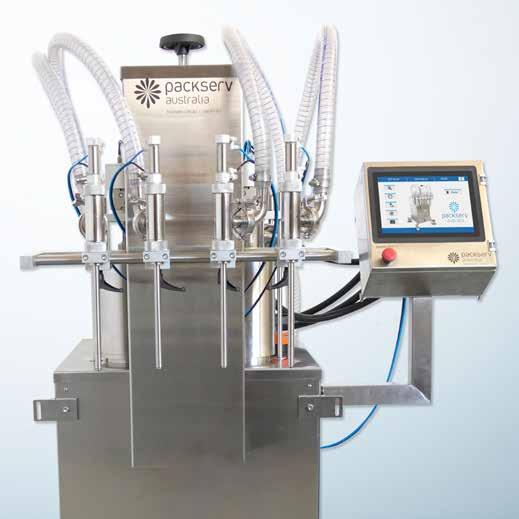
M AKING IT IN M ANUFACTURING IN NSW

Tente offers more mobility solutions
Tente Castors & Wheels has been manufacturing quality European castors, wheels and mobility solutions since 1923. Its smart mobility solutions noticeably improve people’s lives and working environments. They increase productivity, ensure greater safety and open up new horizons in matters of design, durability and environmental friendliness.
Whether it’s for industrial, commercial, medical technology, heavy goods transport, mechanical engineering, intralogistics, factory equipment or the furniture sector, Tente’s castors and wheels set new standards and put influential changes in motion.
Tente also manufactures and distributes quality trolleys for all types of applications, including removalist trolleys, warehouse trolleys, linen trolleys, platform trolleys and powered trolleys. It also does custom trolleys, which can be designed and built in any material fitted with suitable castors.
Tente’s E-Drive can be retrofitted to most trolleys and takes the pain of pushing heavy loads. It works like a fifth wheel and offers perfect
directional stability, especially when using four castors. The system is activated via the hand control unit, once the drive is lowered, it is ready for use. The stepless speed regulation (forward and backwards) enables optimal
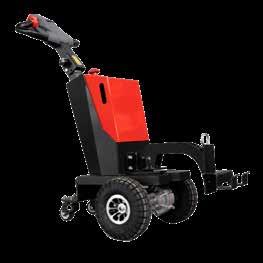
use. The required energy is supplied by a powerful, rechargeable battery. There are three models available; E-Drive Flex for standard applications, E-Drive Optima for higher safety demand and E-Drive Ultimate for higher customisation demand.
Electric tugs are battery powered pedestrian operated machines designed to move heavy loads on wheels. They can be used in retail, healthcare, hospitality, supermarkets, airports, waste management and strata applications. The new range of Xsto Battery Electric Stairclimbers will make light work of moving heavy objects up and down stairs. There is an Xsto available for most items that need to be moved, ranging from 170kg-420kgs. These stairclimbers include folding handle models with tracked drive, track drive models with support wheel feature for heavy cargo, stairclimbing forklift which is capable of lifting itself and cargo into a van or ute, detachable drive units which function as a powered stairclimber or as a standard handtruck.
Tente also distributes a range of quality brands. Prestar trolleys from Japan are suited to offices, retail, stock
deliveries and schools. Prestar’s quality is superior and offers a fiveyear warranty.
The Tawi range of battery electric lifters offer efficient handling of goods with ergonomic lifting, full mobility and flexibility. The Tawi range includes Easy Squeeze which can squeeze, lift and rotate; Core Gripper which lifts and rotates; V Block which is a rotating turntable and lifter; Fold Up Platform which is a combined platform and forklift attachment. These units are available in zinc plated and stainless steel, which are ideal for pharmaceutical and food environments.
Nally plastic bins are food grade bins made to stack, nest or stack and nest. Nally products can be used in warehouses, restaurants, stock control, food processing and anywhere a quality, robust storage container is required. Tente can manufacture dollys to suit most Nally bins, these can be made from galvanised or stainless steel, all fitted with quality Tente castors.

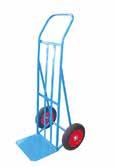
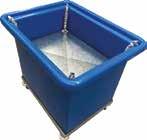
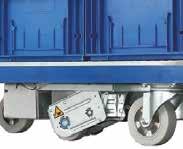



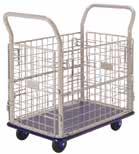
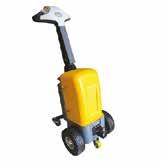
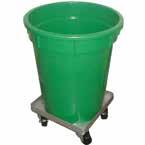

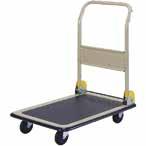
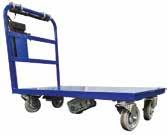
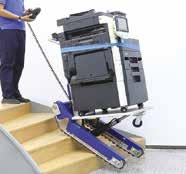
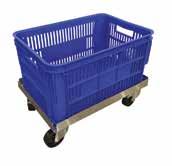
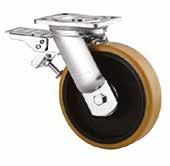

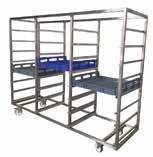
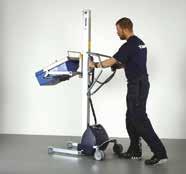
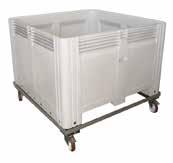

IPermanent-Electro lifting magnet technology
t’s taken a while to come to fruition, but the science has finally caught up with the goal. Lifting magnets that employ the immense gripping power of permanent magnets, which can be activated or deactivated at will, are now a reality.
The heart of the idea is that particularly designed permanent magnet elements can be magnetised and de-magnetised an infinite number of times without deterioration in effectiveness. Advances in rare earth and other permanent magnet manufacture have also contributed to the compactness and viability of the technology.
By using cleverly designed coils to ‘charge’, or activate these permanent magnet elements, steel of all types and shapes may be readily lifted. Similarly, a reverse pulse can de-activate the permanent magnets.
One of the pioneers in this specialised field was Italy’s Tecnomagete, now known as MagAutoblok Tecnomagnete. From the early 1970’s the company began to research and implement innovative magnetic solutions, among them the development of both permanent and permanent-electro lifting magnet apparatus with patents as early as 1975.
Today, thousands of installations around the world, lifting heavy steel loads of many sizes and shapes, demonstrate the telling advantages
of Permanent-Electro (also known as Electro-Permanent) Lifting Magnet design.
Once upon a time, electromagnets were considered the only real option for lifting steel plate, slab and billets, but this method has made lighter, stronger and more versatile magnetic lifting possible. Here’s why.
Conventional electromagnets consist of a relatively large steel or soft iron core and housing filled with a heavy copper or aluminium coil. A relatively large current is used in the coil to induce a magnetic field in
is here
the magnet core—usually the centre core is one pole (say North) of the magnet and the outer case forms the other pole (South).
“This method has made lighter, stronger and more versatile magnetic lifting possible.”
As the current flows in that coil, the whole core and housing

warms—and, as it warms there is a subsequent loss in magnet strength. This means the magnet must be sized to compensate for loss of magnetic strength that occurs over the period of a long lift, or series of lifts. That’s why lifting electromagnets are usually rated with a duty-cycle, for example maximum 30 minute ‘on’ time, followed by a cooling period.
Permanent-Electro lifting magnet technology offers various advantages. These include:
• There is no magnet efficiency loss due to temperature rise. The permanent magnets remain at ambient temperature for as long as a lift or series of lifts may take. They are activated or de-activated by a short, sharp current pulse only
• There is no need to duty-cycle the magnet/s
• The self-weight of permanent-electro magnetic lifters is usually considerably less than that of conventional electromagnets, so overhead crane or lifting equipment capacity requirements are reduced
• Whilst conventional electromagnets require back-up with batteries or other emergency systems to cover the eventuality of power-outages, there is no such requirement with permanent-electro systems, as the magnets continue to retain the load even during power outages. In addition, a load cannot be released inadvertently, because a fail-safe system, known as ‘Dautanac’ prevents release before the load is at rest
• Power is required only momentarily for the activate and de-activate operations, which means Mag-Autoblok Tecnomagnete
Permanent-Electro Lifters are far less energy-hungry—an important consideration in today’s green-conscious world
• Due to its relative lightness of weight, it can lift steel plates typically up to 16 metres in length and blocks up to 50 tonnes. Systems are also available to lift steel coils The technology not only applies to lifting, but is also used extensively in clamping operations such as chucks for machining operations as well as mould clamping in injection moulding operations.
Mag-Autoblok Tecnomagnete is represented in Australia by Serpent & Dove—Applied Magnetics Pty Ltd.
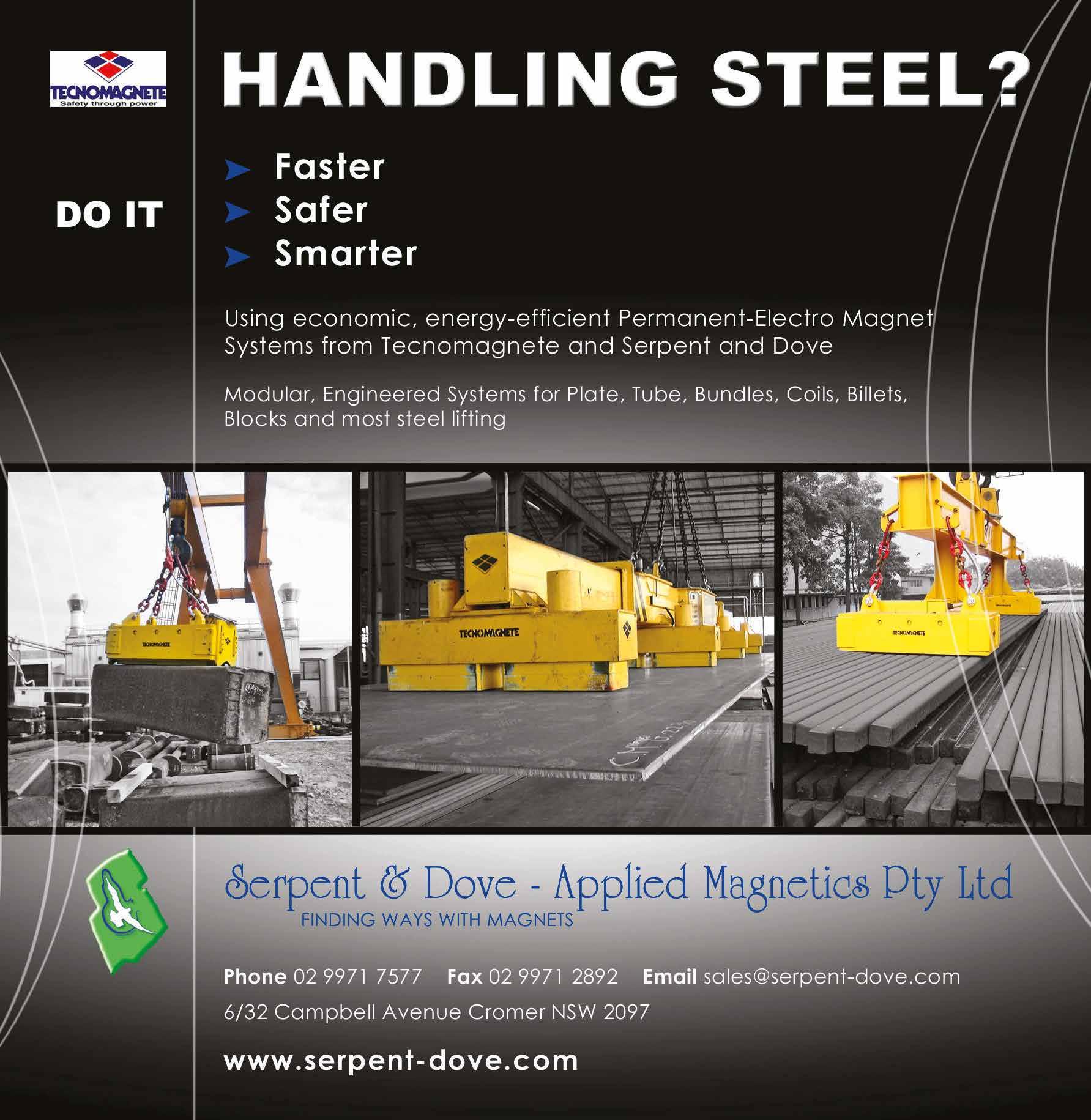
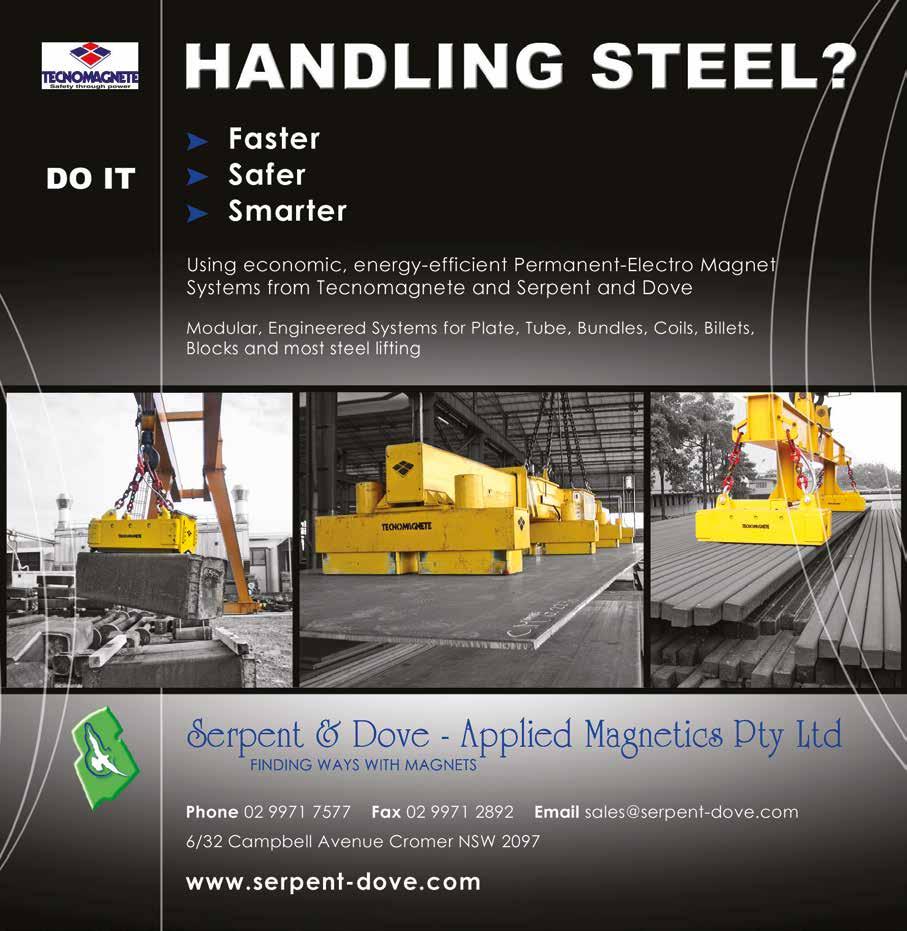
Intralogistics: Future signposts are clearly visible
By Simon Pullinger, LAPP Australia Managing DirectorAs long as the traffic is flowing and the shelves are full, the intralogistics sector is rarely in the spotlight. However, by flying under the radar, the significance of the industry can easily be overlooked.
The Australian intralogistics market was valued at AUD $780 million in 2022 and is expected to grow to AUD $2,319 million by 2030. By global comparison, Asia-Pacific is the fastest growing region for the freight and intralogistics market.
Intralogistics is essential to ensuring our day-to-day lives, all industries and many services can operate in the first place. Without a functioning flow of raw materials, goods or information, nothing can be produced, communicated or sold.
That’s why it’s unsurprising intralogistics is noticed precisely when something goes wrong, such as when a giant freight ship blocks the Suez Canal, work in warehouses is slowed down or even suspended by social distancing or traffic is paralysed by a strike over the consequences of Brexit.
Unfortunately, the intralogistics sector has a growing shortage of skilled workers. This will have significant consequences, because without personnel there are limitations to materials or goods flows.
Smart automated solutions
These global trends have also affected LAPP, the leading provider of integrated solutions and branded products in the field of cable and
connection technology. It has implemented smart solutions, such as using autonomous forklift trolleys to relieve employees of repetitive manual tasks, in factories across the globe.
Anyone thinking about the future of large logistics hubs and highrack warehouses will encounter the topic of automation: self-driving lift trucks, automated conveyor technology, robots that pick appropriate goods or artificial intelligence that handles all planning processes. The signposts for successful logistics in the future are clearly visible. Demographic change and the accompanying shortage of skilled workers are just two of the drivers of this development.
As a major global leader, LAPP recognised the trends in the sector at an early stage. It ranked itself among the most important companies in the sector for the first time in 2023 at LogiMAT, the largest intralogistics trade fair in Europe.
This shows how LAPP solutions enable comprehensive networking of data and processes and increase efficiency and transparency in intralogistics. The industrial-grade, robust and high-quality components for networking transfer data and power reliably. For cross-level communication between the various network participants, LAPP has smart solutions for the leading protocol standard PROFINET and all other standards.
There is a particular demand for solutions for the increasing number of high-rack warehouses, which are
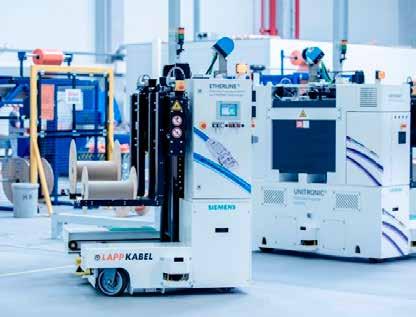
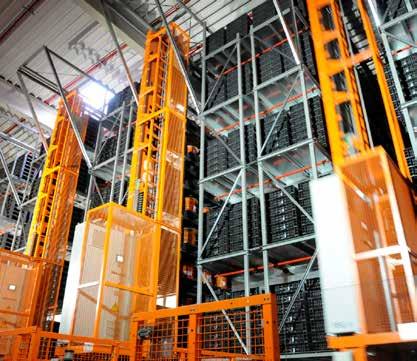
growing in height due to an increasing lack of space. With the ÖLFLEX® CONNECT CHAIN, LAPP offers fully assembled cable chain systems that can be tailored precisely to the needs of customers. This applies both to applications requiring torsion and movement.
Data cables for logistics processes
For industrial data communication, LAPP has high-quality industrial cables in its portfolio with its HITRONIC® fibre optic cables and ETHERLINE® data cables, which enable reliable data communication in automated logistics systems.
LAPP also supports the integration of robotics and cobots into logistics processes. With special cables and connectors, these machines can be seamlessly integrated into the logistics environment. It means repetitive tasks can be automated, which eases the burden on human labour.
Future technologies also deployed at LAPP
At LAPP, these questions play a major role in all future projects. The Stuttgart-based company will be expanding its own logistics centre in Ludwigsburg over the coming months and bringing it up to date with the latest technology.
Rather than replace employees with machines, LAPP believes collaboration between people and robots and the use of other future technologies will increasingly become a matter of course. By optimising processes, LAPP uses its own products and solutions to ensure the current shortage of
professionals does not affect its own delivery capacity.
The conversion and expansion will allow LAPP to achieve significantly more warehouse capacity and increase its availability and throughput speed on site. This means that we will be able to rapidly supply all our customers. A modern IT system also reduces the error rate and, in the best case scenario, ensures that less waste is generated in the logistics centre.
This is just the beginning. In the future, intelligent technologies will make it possible to support what we call ‘best agers’ with age-appropriate work concepts. For example, the use of intelligent robots will reduce physical stress during standard activities including lifting, stacking and commissioning. Machines can relieve the arms and shoulders of logistics workers.
Working in logistics is becoming more demanding and less physical, but that doesn’t mean it can work without our employees and, in particular, without skilled personnel. That is precisely where we need well-trained professionals, of which there is an increasing shortage. We are focussing on training and retaining our own employees internally, according to their abilities and needs.
Human beings are not replaceable in intralogistics. Automation solutions from LAPP are available for the everyday work processes.
We keep your industry alive
We are your trusted partner for cable and connectivity solutions in the field of intralogistics.



AKING IT IN M ANUFACTURING IN NSW
Adept enters a new era
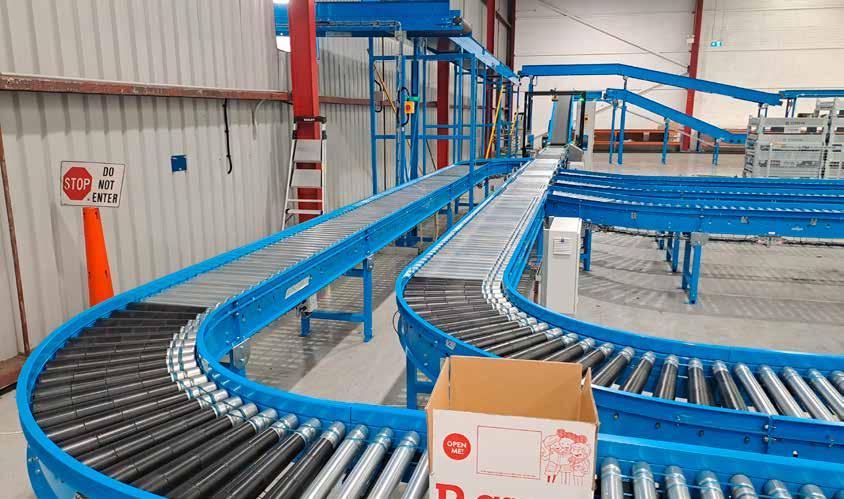
New owners have taken over Adept Conveyor Technologies and MRT Australia, creating Adept Conveyors Pty Ltd, a new business that’s set for growth and expansion in the Australian materials handling and logistics markets.
The new company will be steered by the Larsen family of Cowra, NSW, and the family’s long-time accountant, Stephen Henderson.
The Larsen family has a long history in Australian manufacturing,
particularly in the agricultural industry. They also bring extensive experience in marketing and finance. They look forward to building on the excellent work of the previous owners, Paul Johnson and Ross Simpson.
Adept Conveyor Technologies is a recognised leader in the materials handling industry, known for its expertise in the design and installation of conveyor systems throughout Australia. It also has distribution rights to a range of conveyor

componentry under the MRT brand.
Central to the decision to purchase the assets of these companies was the unique offerings of Adept Conveyor Technologies and the capabilities of its staff. Stephen and the Larsen family feel these benefits set up the company for growth and expansion in the Australian materials handling and logistics markets.
The history
In the early 1990s, Richard Larsen and his three sons decided to start manufacturing the farming implements they needed on the family farm. This soon grew into a profitable business manufacturing a variety of implements and was purchased by a multinational corporation in 2019.
Richard’s sons, James, Bill and David, were joined by their brotherin-law, David Trim, and their sons, Roly and Kurtis, when they started their next business. It was also based around Australian manufacturing, providing quality products and great customer service.
When they discovered Adept Conveyor Technologies, they realised it was an opportunity too good to pass up. Along with Stephen, who had worked with them since they first went into business, they made an offer. The assets of
Adept Conveyor Technologies and MRT Australia are now officially owned by their new business, Adept Conveyors Pty Ltd.
The future
Even before the sale was complete, it was decided that James and Kurtis would work with the previous owners to consolidate their knowledge of the company and the wider industry, so that they would be ready to take over immediately after the sale.
The other owners and Larsen family members are working part time for the company in various roles.
Paul Johnson continues at Adept Conveyors in an advisory role throughout the handover, to ensure the business continues running smoothly and provides the best possible value to all customers.
The new owners have great hopes for Adept Conveyors. They aim to build on the existing capabilities of the company to create a brand that is a renowned leader in the industry for quality products, outstanding customer service and comprehensive industry knowledge.
HELPING YOU DO WHAT YOU DO BEST
Warehouse order processing and fulfillment systems
Sanitary food production and processing conveyors
Freight and courier handling systems
Custom unique conveyor-based designs
HOW WE CAN HELP
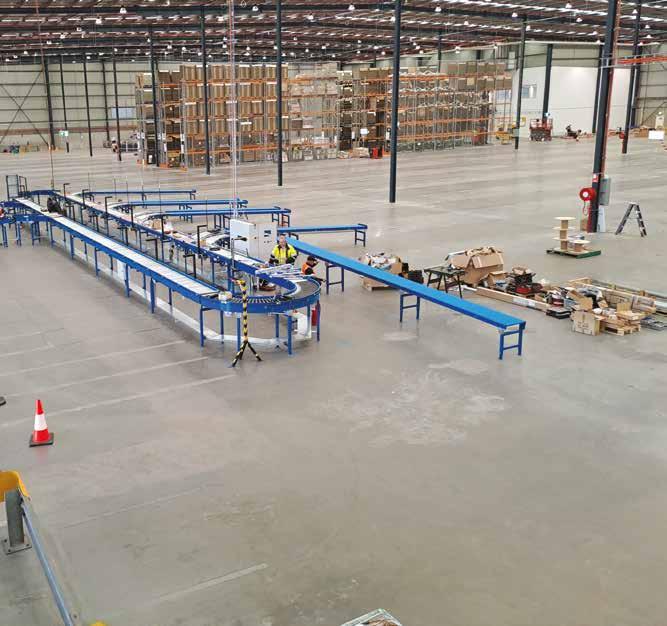
The most favourable and exclusive pricing for all quality hardware

A flexible approach to conveyor design and manufacturing
The largest local stock holder of any conveyor supplier
Components sourced solely out of Europe
M AKING IT IN M ANUFACTURING IN NSW
Bespoke cranes rely on energy chains

Eilbeck Cranes has posted growth each year since the mid-1980s when current CEO Tom Eilbeck bought the 117-year-old company from his father.
In the last 30 years, turnover has jumped from $5 million in the mid1990s to $150 million today. Much of the success of the past decade has been due to igus energy chains which are key to Eilbeck’s standard German cranes and the bespoke cranes Eilbeck designs and builds here.
“Eilbeck had already delivered the first cranes … to South Australia to help build the French subs”
The company was based in Western Australia since being founded by Eilbeck’s grandfather in 1907 when it not only made cranes but also saws, winches, pulleys, tables, trolleys, wheels and rails for the local logging industry.
In 1994 Eilbeck expanded to Ingleburn, Sydney, where it now has four factories, plus two in WA, one in Truganina,Victoria, and one in MacKay, Queensland. Eilbeck’s ninth and biggest facility at 4,500 sqm in Moss Vale, NSW, was commissioned
last July. The tenth and by far largest facility at 9,000sqm is being designed now for Moss Vale.
The core business is cranes for construction and major infrastructure projects but Eilbeck also supplies to mining, aerospace, oil and gas, green energy, nuclear and medical. One of its four Ingleburn sites manufactures for defence: helicopter parts, tank components, among other defence and mining equipment. The massive new Moss Vale facility will also make for defence.
Operations Manager Peter Heinrichson says the Ingleburn facility winning defence work is the most state-of-the-art machine shop in the Southern Hemisphere. The French were not the only ones bitterly disappointed when the Australian government reneged on theFrench subs prior to AUKUS. Eilbeck had already delivered the first cranes it was to supply to South Australia to help build the French subs.
“All the big infrastructure project tunnels in Australia have had Eilbeck cranes on them, whether for rail or road.”
“Since the Airport link was built 1995-2000, an Eilbeck crane has been plant removing spoil from every major Sydney infrastructure project. Right now, we’ve got about 40 cranes out there around Sydney.” Eilbeck does the mechanics to specs of customers who do the civil work. A vital part of the success of
the festoon system to power cranes,” says Heinrichson. “They don’t ask for festoons any more.”
Festoons need much more space which is at a premium in tunnels, mining sites and other confined construction spaces. Yet energy chains offer many other benefits.
Being highly mobile, festoons can’t be mechanically housed. So they can get tangled or have problems with their pulling mechanisms.
“You get more than 10 years, maintenance-free, out of an energy chain”
Whereas an e-chain is fully housed, cannot tangle and unfolds only a small amount within the same space. Less movement by energy chains means fewer problems and far less maintenance.
Eilbeck’s customised cranes is the igus energy chain from Treotham, also known as an e-chain or dragchain, which Eilbeck uses in its locally custom-designed and built cranes.
Treotham, a supplier of electrical and mechanical components including cables, customises the cables and energy chain for Eilbeck to integrate into its bespoke cranes.
“A vital part of the success of Eilbeck’s customised cranes is the igus energy chain from Treotham”
Eilbeck is also an agent for ABUS Crane Systems’ standard cranes which use serial igus energy chains and sells up to 1,000 standard cranes each year. By value, Eilbeck’s business is split evenly between the far more expensive customised cranes using Treotham’s e-chains compared with the less expensive standard ABUS cranes it resells. Customers of bespoke cranes have found the initial outlay worth the price in the long term.
Twenty years ago, it was rare to use anything else but festoons but customers are now convinced.
“For a hundred years, people used
“Cranes with e-chains are a much more cost-effective solution,” says Heinrichson, “Because they reduce maintenance and downtime.
“The igus energy chain is maintenance-free and reliable. Our contracts, especially in construction, spell out performance guarantees we have to meet or be penalised. So we need reliable, proven equipment.”
“Maintenance is the biggest saving: festoons fail because trolleys pulling them fail within two to five years. That means downtime. You get more than 10 years, maintenance-free, out of an energy chain.”
Another cost benefit is that a much broader range of readily available cables can be used in an energy chain, and Treotham can supply and assemble them in the right configuration. This means Eilbeck has many more options for customers whose specs are always changing and demanding different performance levels for each project.
The latest is a 550-tonne crane with 50-metre lift height and 50-metre span for Victoria’s North-East Link.
“With an energy chain, we can make a crane as big as you want, say a hundred metres but you can’t do that with festoons; they’re very limited in length.”
“That’s why we’re successful — because we’re not bound by any limits.
The leading supplier of the BIGGEST names in Automation
Energy Chain

Flexible Cables
Secure supply of energy and data to moving industrial equipment.
• Large size range
• Vertical travels
• Energy tubes
• Hygienic chains
• Solutions for long travel
• Guide troughs
• Readychain
• Robotic, 3D
• Circular movement

Flexible Conduits
HUGE range of high quality flexible cables
• Control cables
• Single cores
• Data cables
• Sensor/Actuator
• Intrinsically Safe
• VSD/EMC cables
• Halogen Free cables
• High temperature
• Harsh Conditions
• Crane cables
• Profibus cables
• Bus/DeviceNet
• Solar cables
• Instrumentation
• Flat cables
• Curly cords

Connectors
Largest range of flexible conduits for cable protection
• Conduits
• Conduit fittings
• Divisible systems
• Jumbo systems
• Conduit Accessories
• Braided cable protection
• Fire barrier solutions
• Food and beverage
• EMC systems
• Ex, ATEX, IEC EX

Industrial connectors for many industries
• Rectangular multipole connectors from ILME
• Single pole Powerline connectors from TEN47
• EPIC connectors from Lapp Group
• M23 circular connectors from Hummel
• Circular connectors specifically for the entertainment/stage lighting industry from Socapex
Safety Sensors
Safety engineering solutions from EUCHNER

• Multifunctional Gate Box MGB
• Transponder-coded safety switches
• Electromechanical safety switches
• Magnetically coded safety switches

Sensor technologies for automation
• High-Precision Laser Distance Sensors
• Ultrasonic Sensors
• Inductive Sensors
• Fluid Sensors
East West Engineering

Ron King’s entrepreneurial journey began when he sold his beloved Ducati motor bike to buy tools and a van to start a residential fencing business in 1974.
By the end of the ‘70s, Kings focus changed to industrial fencing. Jobs installing temporary fencing at building sites gave King a toehold in the metalworking sector with requests for additional onsite metalwork such as handrails.
By the mid-1980s, Allmesh Engineering was being contracted on largescale metalwork projects for Darling Harbour’s public works including the Powerhouse and Maritime museums.
On these public works contracts, King saw an opportunity in the market for well-engineered and certified lifting equipment. With this he designed and manufactured a lifting jib he badly needed at the time, kicking off a habit of customising items which were to become bestsellers in East West Engineering’s range.
After Darling Harbour opened in 1988, recession hit the construction
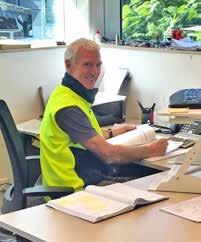
industry. With 40 employees, King saw the business needed to pivot. Allmesh began designing and manufacturing forklift and crane attachments, such as jibs, and metal waste bins to meet Australian standards, and offered them with safety certification and documentation.
“In those days you couldn’t easily buy equipment with certification off the shelf, so it was a vital competitive edge for our initial products,” says King.
King attended equipment trade shows in Germany and returned brimming with ideas.
“The key to success was to get them onto the market quickly,” says King.
“We photographed the prototypes, made flyers which were sent out to 200 distributors of lifting equipment and advertised in trade publications” says King.
Established in 1993 as a specialised design division of Allmesh, East West Engineering was turning lifting and materials handling equipment ideas into prototypes.
A successful launch at a materials handling show in the mid 1990’s garnered many business leads. In 1998 the company’s catalogue boasted 100 products and, by 2000, East West stopped building work to focus solely on design, manufacture, and marketing its own products.
“In the early days we had to guess what the customer needed; now with an extensive range of over 300 standard products and more than 9,000 custom designs, customer demand helps guides our growing product range.”
Recent demand has led East West Engineering to the agricultural sector. Ag items now include a range of adaptors and attachments that increase the flexibility of a tractor to
handle different loads. This includes a cotton bale clamp, hay bale grab, hay bale spinners, log grabs, pole setters, bulk bag lifters and fork positioners that enables a tractor to do double duty as a forklift. A floor-mount bin tipper was designed to be customised to suit any bin and has been sold to grain
Lift-n-Tip wheelie bin tipper can require up to three prototypes, and might involve three months of testing.”
Before prototyping, there’s extensive research into market needs, competitive advantages, possible applications, then business case analysis. Design sketches are followed by detailed cad designs that must pass finite element analysis testing in accordance with the relevant Australian standards before moving forward.
While ongoing R&D is a substantial investment, the company’s 10,000 sqm of manufacturing equipment and facilities have substantial capital costs too. Finances have been kept under control by a company strategy to not expand too fast.
As King says, you can come up with new ideas but some may not work and that’s ok. Staying ahead of the competition requires more than great, practical ideas.
Copy-cats have been a problem for East West Engineering which often redesign old products because they have been copied. Our engineers design new features to compete with the copies.
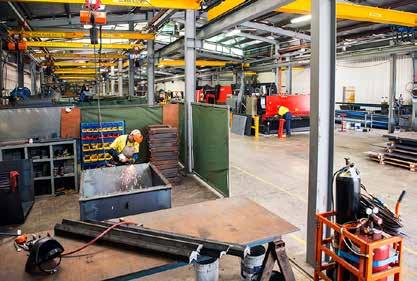
companies, metal recyclers, and food producers. One customer wanted a bespoke stainless steel chute and removable safety barriers for its food production line; this new design is now part of their standard range.
Inspiration for this product designer is everywhere. King recently spotted a car being lifted into a shopping centre as a competition prize and decided to design a car carrier platform. Although time to market can vary depending on the product.
“Simple lifting platforms might take three to four weeks to prototype then another two weeks to build. More complex products, like our electric over hydraulic
Fifty years on from starting a fencing business, Ron King is not only owner of a successful materials handling manufacturing and engineering firm, with product designers, engineers, fabricators, assemblers, painters and customer support team all working from its premises in Sydney’s Northern Beaches. He is once again the proud owner of a vintage Ducati, the bike he sold to start the fencing business back where it all started.
East West Engineering
eastwesteng.com.au
Compress storage footprint with drawers
When space is at a premium, the right storage solutions are essential. And drawers are an easy way to make the most of your space.
The BAC Drawer Storage range, manufactured by BAC Systems, can be used to keep inventory in order while integrating with any storage/ inventory management system - but most importantly, it compresses your inventory.
When compared to shelves, drawers win out for volumetric and functional reasons. BAC Drawers waste little volume and setting up shelves to be high-density often sacrifices easy access to the parts that drawers afford.
When shelves are fitted with boxes or tubs, rarely do these containers take up the space between shelves or are the correct size for the part being stored, seeing as these are generally set up using limited generic sizes.
On the other hand, BAC Drawers allow you to select the drawer height
and the location size that suits the inventory you have, rather than waste space on oversized tubs. You can fill the drawer location to the brim, it won’t spill out and you have easy access from the top. Simply open a drawer to instantly view its full contents, plus the labels for each location. Even in the act of compressing your stock, you never lose access to or visibility of your parts.
In comparison, having boxes on shelves means wasting time pulling each one out individually and checking the contents.
On average, converting to drawers with properly sized and labelled locations uses only a third of the footprint compared to storing the same inventory of small to medium items on shelves.
Of course, this depends on what you are storing, how it was being stored and how much of it you have, but you can count on a drawer storage module to improve your situation.
Reducing your storage footprint
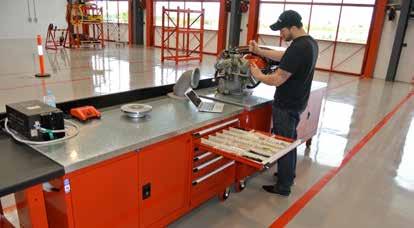
saves space and labour, two of the greatest expenses for most businesses. It can extend the life of your parts store, as it takes longer for you to fill it when you are growing. Drawer storage has restored many an overflowing parts store and returned it to profitability. It’s also a cost-effective alternative to expansion, renovation or relocation.
From a labour point of view, when your inventory is compressed, staff spend less time searching for parts. The right drawer storage saves you a significant percentage of your picking times, allowing an individual to
pick more parts in a day. It can also result in fewer staff needed to pick the same number of parts.
BAC Drawer Storage Cabinets is an Australian made product that epitomises high-density storage: simple, strong, with no ongoing costs or power requirements, negligible maintenance and easily adjustable to adapt to changes in your inventory. And they last for decades.
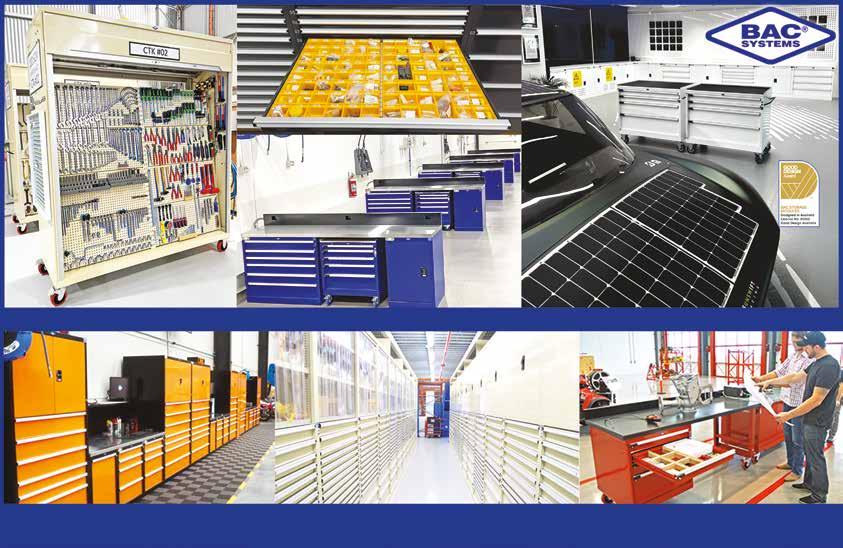

M AKING IT IN M ANUFACTURING IN NSW
Aerator brings efficiency and sustainability

AJ Bush & Sons
(Manufacturers) is among the biggest protein recovery operators on Australia’s east coast, with rendering and manufacturing plants processing animal by-products for the meat/butchery in NSW and QLD.
The Riverstone, NSW, plant’s collection area, in addition to Sydney metro, ranges from Nowra in the south to Canberra, Dubbo and Bathurst inland and up to Newcastle and Tamworth in the north. The material collected is recycled into products used for livestock, pet food, aquaculture, fertiliser and biofuels.
Sustainability
AJ Bush’s Riverstone plant has undergone numerous upgrades over the years, aligning with company goals of minimising waste, reducing the risk of pollution (odour), and continuous improvement in providing a safe work environment for employees. As part of this sustainability program, Plant Engineer Nick Lawrance contacted Hydro Innovations for advice and assistance in replacing ageing floating surface aerators on their wastewater treatment system. Lawrence wanted an aeration system that could be monitored and maintained from the lagoon banks and provide a safe environment where operators could attend to maintenance and keep the aeration system at peak efficiency.
Aeration solution
Hydro Innovations proposed an Echo-Storm aeration system from Gorman-Rupp as an alternative to traditional surface-floating aerators which have always been considered difficult and potentially hazardous to service or maintain. These surface aerators can only be accessed by crane or row boat, or need to be tethered to lagoon banks by a system of cables. Because of these impediments to access, maintenance is often neglected or postponed for prolonged periods.
The Echo-Storm is a ‘bankmounted’ venturi aerator used to mix and aerate tanks, ponds and lagoons; it uses Bernoulli’s principle, whereby a low-pressure area is created by an accelerated fluid. It is used in conjunction with a Gorman-Rupp self-priming pump. The pump draws water from the source and pumps it into the aerator under pressure.
With-in the Echo-Storm aerator, there is an acceleration zone where the pumped fluid is accelerated, creating a low-pressure area within the aspirating zone. Here it draws in atmospheric air at the rate of 2.2 times the rate of the fluid being pumped. The air and water then pass into the mixing and oxidation zone where the waste water and air are mixed under pressure. The turbulent mixing facilitates the removal of substances with weak Henry’s constants such as CO2 and VOCs.
Sustainability features
• WHS risks are minimised because operators don’t need cranes or row boats to access equipment
• Maintenance and operating costs are reduced compared with surface aerators
• Bank-mounted aerator and equipment is easy to access
• Longer lifespan because equipment is more likely to be monitored and maintained
Echo-Storm aerators can produce the desired level of mixing and dissolved oxygen transfer because they are easily scalable and can ‘inject’ discharged oxygenated water at multiple points around the lagoon [basin, tank or lake]. Importantly, thanks to the use of self-priming pumps, water can be drawn from any spot or spots within the water body to ensure complete mixing.
The rendering plant had been operating five floating surface aerators and when one of these failed it was decided to install an Echo-Storm aeration system to trial the effectiveness and operation of the system.
Results
After just a month of operation, significant results had been achieved especially in the reduction of surface scum, maintaining required dissolved oxygen levels, improved operating efficiencies and contributing to lower odour levels.
The other obvious benefit of the
newly installed bank-mounted EchoStorm aeration system is the ability to quickly, safely and easily inspect the system or make any adjustments to the operation of the equipment if required, ensuring a completely safe working environment for operators.
Lawrence is pleased with the results and is considering replacing the rest of the old system to bankmounted aerators.
Sizes
The Echo-Storm is available in four sizes, from 2’ [50mm] through to 6’ [150mm], providing dissolved oxygen transfer rates up to 30kg per hour with a single unit, but capable of meeting any demand by using multiple units. Efficiencies can also be gained by using larger, more efficient pumps to drive multiple Echo-Storm units.
The Echo-Storm not only transfers dissolved oxygen at efficient rates, it also conditions the wastewater by breaking down organic matter as it is accelerated through the unit, making more surface area available for biological treatment. It also oxidises sulphur containing molecules such as hydrogen sulphide and mercaptans for effective odour and corrosion control.
RUGGED
WASTEWATER PUMPS
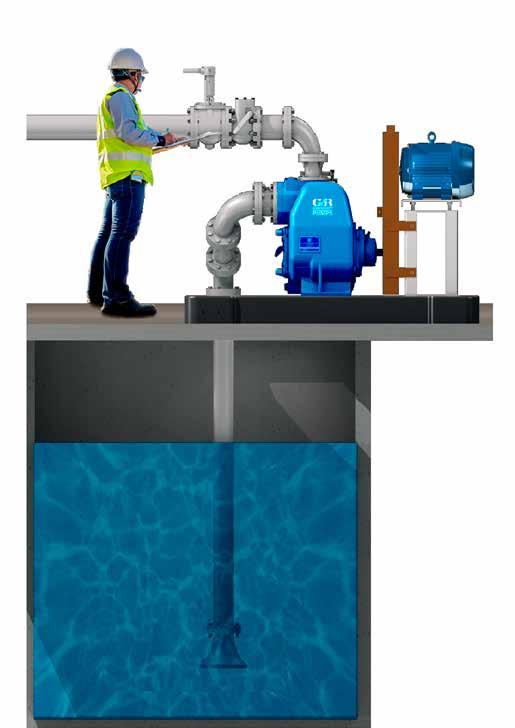
“Don’t be fooled by cheap imitations. Insist on genuine, rugged, dependable Gorman-Rupp brand”

• Self-priming pumps are mounted above ground for easy access and maintenance
• Designed to minimise blockages
• Pumps rags and stringy materials with ‘eradicator’ technology
• Does not require multiple personnel to maintain.
Designed, cast, machined, assembled & tested in the USA
sales@HydroInnovations.com.au
www.HydroInnovations.com.au
ANUFACTURING
Ready to celebrate 20 years of Hunter manufacturing excellence
The Hunter Manufacturing Awards (HMA) is commemorating its landmark 20th anniversary this year.
The awards encourage excellence in, highlight and reward the Hunter region’s integral role in Australian manufacturing. Nominations for this year’s awards need to be made by August 21 this year.
The recent winners from last year’s awards, Hi-Vis Group and Senquip, demonstrate the competitive edge and innovative spirit that characterise manufacturing in the region.
Carrington-based Hi-Vis won three awards: 2023 Manufacturer of the Year – 50 Employees or More Award, along with the Excellence in Sustainable Operations Award and the Excellence in Manufacturing Capability Award.
As a market leader in highly intelligent visual information
systems (HIVIS), its products have been keeping Australians safe for 40 years. Hi-Vis has invested significantly in manufacturing technology and works closely with the University of Newcastle.
The other major award winner, for Manufacturer of the Year – Less than 50 Employees, was telemetry products maker Senquip. The Port Stephens-based business manufactures telemetry equipment that monitors and controls remote machinery in harsh industrial environments and replace the need for bespoke solutions. Senquip also picked up the Excellence in Product Design Award. Highlighting diversity in the region, reusable menstrual disc maker Hey Zomi, took out the 2023 Excellence in Marketing Award. Co-founder Zoe Fehlberg said she loved that the awards celebrate manufacturers across all industries.
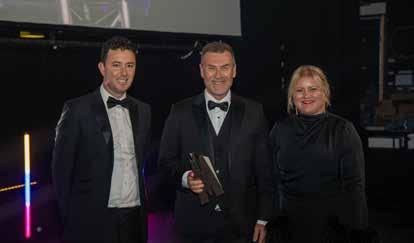
“It’s so exciting at this stage of our business to be recognised as manufacturing leaders in our region,” Ms Fehlberg said.
“To us, this award validates our vision – to create strong innovation with the highest-quality Australian manufacturing that empowers menstruators everywhere.”
Jacqui Daley, Chair of the HMA board, said the 20th anniversary reflected not just longevity but also the progressive vision of the Hunter’s manufacturing community.
“We have consistently witnessed
our local manufacturers adapt, innovate, and excel, setting standards for the industry nationwide.”
For more information on the HMA, to submit a nomination, or to learn about sponsorship opportunities, please visit www.hma. org.au or email info@hma.org.au Nominations for the 2024 awards close on 21 August.
Hunter Manufacturing Awards hma.org.au


Ant61 has built a satellite-saver
The problem with satellites is that if something goes wrong in space, you can’t do anything about it. They become space debris.
Ant61 is providing a solution. The Beacon is a first-of-its-kind product that sits somewhere between a black box and the space version of a jumper lead.
CEO and Founder Mikhail Asavkin said the Beacon can stop satellites dying in orbit.
“We originally built it as a black box, as a flight recorder, then we found out that actually, we can restore operational stuff,” he said.
“It can work as a backup communication device. It also has the ability to restart a satellite.”
The Beacon is attached to the satellite on the ground before it’s launched.
“If something happens to the satellite, the Beacon can allow the satellite operator to restore that satellite backup operation. It’s like a defibrillator for the satellite,” Askavin said.
“At the very least, if the satellite didn’t turn on, the Beacon would definitely turn on because it’s completely
independent. It will talk to all the systems on a satellite and ask what happened. At the very least, we will know what went wrong so the next time they can build a better satellite.”
The first Beacon was launched on February 27. Ant61 is working on 20 to be launched next year and Askavin hopes it will be “hundreds” following that.
“The more Beacons we have in orbit, the more trust we will get from the community and it will become a de facto standard. Maybe not necessarily the Beacon but a Beacon-like device,” he said.
Ant61’s goal is to create robots that will be able to repair broken satellites in space, like the space version of the NRMA, but that is several years away.
Askavin said the motto on the Beacon is ‘Space is for everyone’ and he encourages more people to get into the field.
“We want to show that, yes, it’s actually possible to do a space business in Australia,” he said.
“But more broadly, we are trying
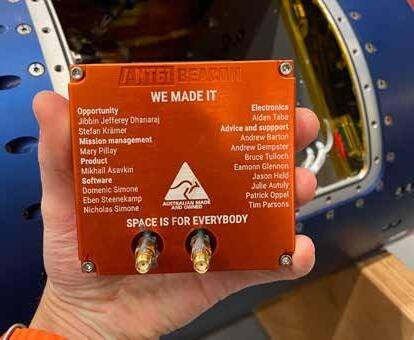
to fight against this kind of elitism of the space industry and showing that everyone can work in it. We had a few students from university that worked on the Beacon that we launched.
CONVEYOR ROLLERS AND COMPONENTS



“Creating these opportunities is really important for us. We would like more and more people to consider joining the space industry in Australia so we can build it together.”

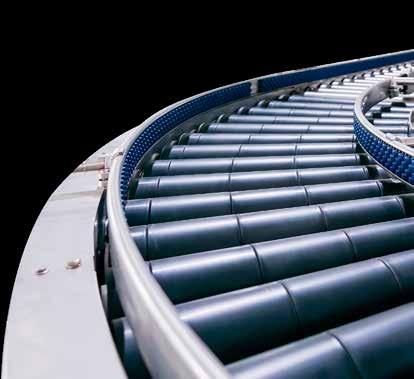
ARBS 2024: Promoting manufacturing excellence in HVAC&R and building services
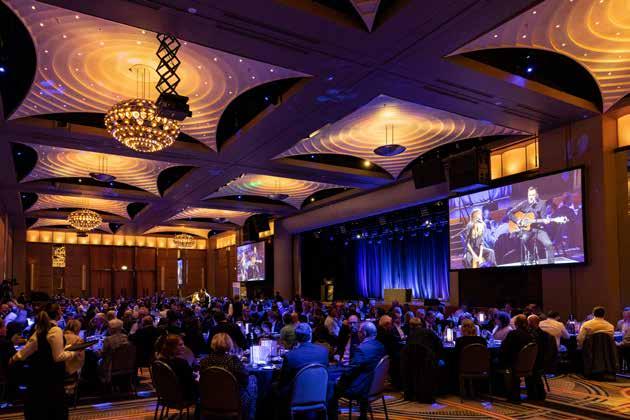
ARBS 2024, Australia’s largest HVAC&R and building services exhibition, will be held at the Sydney ICC from May 28-30, 2024. It continues to highlight the significant role of HVAC and building services within the manufacturing industry—a sector marked by innovation and robust growth in Australia. In a world where technology and sustainability intersect, this event is set to showcase the latest products, services and solutions that are critical to the sector.
With a record-breaking investment in research and development, reaching A$4,763 million in 2019-20, the manufacturing industry continues to be a stronghold of innovation in Australia. This investment signifies a commitment to progress and is reflected in the 4% increase from the previous period, showcasing the industry’s relentless pursuit of excellence.
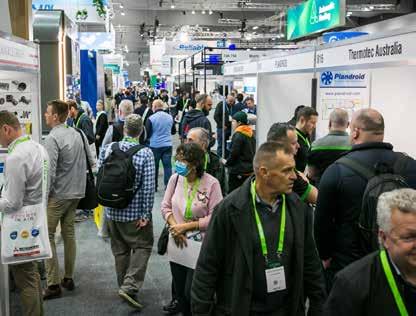
Chairman Professor Tony Arnel highlights this urgency.
“The quest for net zero is reshaping our industry, demanding innovation at every level from system design to installation and operation,” he said.
The seminar program will see discussions led by international keynote speakers including CIBSE President Adrian Catchpole and ASHRAE President Ginger Scoggins. The program promises to offer a comprehensive understanding of how HVAC&R advancements can contribute to a more sustainable manufacturing sector, aligning with the broader national goal of reducing emissions and establishing more sustainable industrial practices. The full program is now available to book at: www.arbs.com.au/seminars.
The ARBS Industry Awards are
“It is the ideal platform for industry stakeholders to explore cuttingedge technologies and strategic innovations that are reshaping the future of built environment services.”
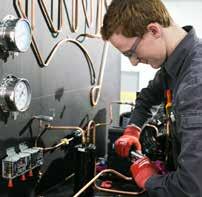
The manufacturing sector, employing approximately 905,000 individuals as of March 2023 , has become a substantial part of the Australian workforce. It stands as a testament to the industry’s expansive growth and its vital contribution to the nation’s economy. In the current economic climate, ARBS 2024 emerges as a must-attend event for manufacturing professionals specialising in HVAC and building services. HVAC&R is more than a complementary aspect of manufacturing—it’s a driving force for energy efficiency and sustainability. With an anticipated 9,000 visitors and 300 exhibitors, it is the ideal platform for industry stakeholders to explore cutting-edge technologies and strategic innovations that are reshaping the future of built environment services.
The significance of ARBS 2024 is underscored by the Australian manufacturing sector’s impressive performance, with a 15.2% increase in industry value added (IVA), amounting to an additional A$16.1 billion in 2021-22. Moreover, the sector’s gross value added (GVA) grew by 2.4% in the quarter ending March 2023, outstripping all other sectors and signalling the critical importance of this industry to Australia’s economic fabric.
Amidst this backdrop of growth, ARBS 2024 serves as a forum for discourse on the transition to decarbonisation and the achievement of net zero objectives at the comprehensive seminar program. ARBS
also a major highlight of the event and serve to celebrate achievements in innovation and excellence, spotlighting companies and individuals leading the way in building services. This recognition is critical as it fosters a culture of excellence and sets new benchmarks for the industry. The winners will be announced at a gala dinner to be hosted on May 29 at the ICC Grand Ballroom. Tickets for this event can be purchased now at: www.arbs.com.au/awards.
By reinvesting profits through the ARBS Foundation to support trade scholarships and research initiatives, ARBS 2024 reflects a commitment to nurturing future talent and fostering industry growth.
For professionals in HVAC&R, building services, and the manufacturing industry, ARBS 2024 is an essential event to source, share and connect.
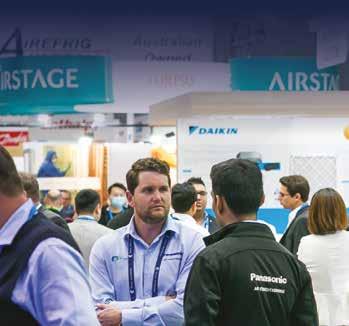

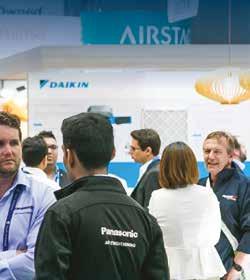













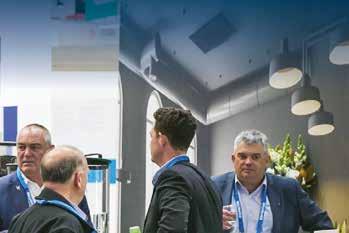
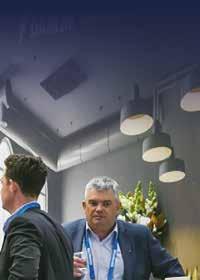

SOURCE PRODUCTS SHARE SOLUTIONS CONNECT AT ARBS
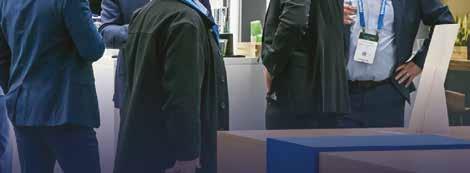





ARBS 2024 will be a bustling hub of over 300 national and international exhibitors, presenting the largest range of HVAC+R and building services suppliers, products and solutions. Featuring the highly regarded Seminar Series and the celebrated ARBS Industry Awards, ARBS 2024 should not be missed.
MAKING IT IN MANUFACTURING IN NSW
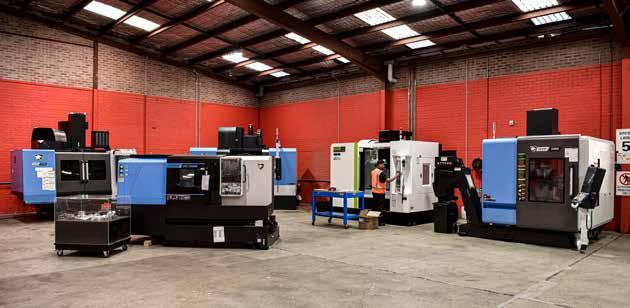
Future Vision gives a glimpse of what’s to come
Hare & Forbes Machinery House will display over 1,000 square meters of cutting-edge automated machinery at its 2024 open house, Future Vision.
The showcase will highlight the future direction of the business. Which includes the very first machine-tending robots.
Hare & Forbes General Manager Rick Foster said the timing, April 17-19, is no coincidence.
“We wanted interstate customers to be able to visit our showroom while attending Australian Manufacturing Week, hence the date,” he said.
“Normally we attend the show, but we’ve just got too much to display now.”
It’s a good position to be in. Hare & Forbes will display almost 100 machines as part of Future Vision — in addition to the several hundred already on display in the 3,000sqm Northmead store.
Hero products sourced globally
are set up and will be used across the three days. These include five DN Solutions and Hartford CNC machines, five Metalmaster and Baykal Synchro press brakes, two SwiftCut water cutters and two brand new to Australia CubeBOX automated robots, which will be loading the CNC machines during the open house.
CNC National Manager Craig Murray is looking forward to putting the robots to work.
“We are really excited to show off our latest innovative technologies,” he said.
“In particular, our new CubeBOX CNC Machine Tending Robot, which will deliver businesses infinite cost benefits for years to come, it’s a real game changer.”
Across the three days, technical staff will be available to answer any machinery questions and demonstrate how automating workflow can make businesses more profitable.
DN Solutions is supporting the
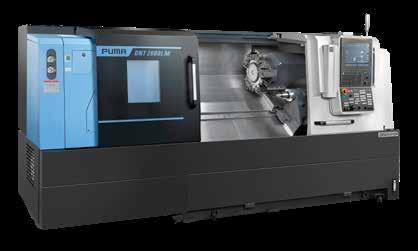
over the three days, perfect for space-limited workshops.
“Future Vision is the perfect name for our in-house show,” says Foster.
“It’s a peek into the future of our business, as well as a brilliant way of showing how our machinery is becoming more automated. If you want to stay at the forefront of your industry, you need to come and check it out. Our more traditional hydraulic punch and shears, section and pipe rollers, guillotines, pan brakes, saws, mills, drills and presses are all here, with only the latest and greatest being showcased in the Future Vision Section.”
Hare & Forbes Machinery House has stores in Sydney, Brisbane, Perth, Melbourne, Christchurch and Auckland. It will soon open another in Adelaide.
event by flying one of its Koreanbased 5 Axis applications engineers to the event. As well as being available to chat, they will run daily seminars at 2pm.
Making the trek up from Albury is the Danny Sims, the Head CNC Machinist and Production Manager at Brad Jones Racing. He will run machines to create Supercar components over the three days and field any CNC questions.
Local suppliers are also supporting the event.
UNIMIG will display its new Pulse Mig welding machines alongside its existing range of Plasma cutters, Mig, Stick and Tig machines while also trailing the new Metalmaster welding tables and fume extraction units. Pilot Air compressors will show off its latest 415V silent reciprocating compressors. Garrick Herbert, Suttons Cutting Tools and Brobo are also bringing machinery to help businesses look to the future.
“The Adelaide store is massive and it looks fantastic. We’ve been fortunate to hire some great staff to help us get going and stock is already arriving. Things are looking good for a June opening,” Foster said.
For those travelling to Sydney for Australian Manufacturing Week, make the half hour trip to Northmead to be impressed by what’s on offer.
Check out the future of automated machinery at Hare & Forbes’s Sydney store on April 17, 18, and 19.
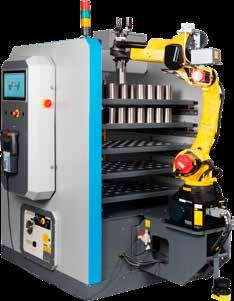
The education and TAFE sectors are also catered for, with a raft of wood and metal working products on show, specifically designed with safety and longevity in mind.
Both the Arcdroid portable CNC plasma cutter and Wazer desktop CNC Water Jet are operational
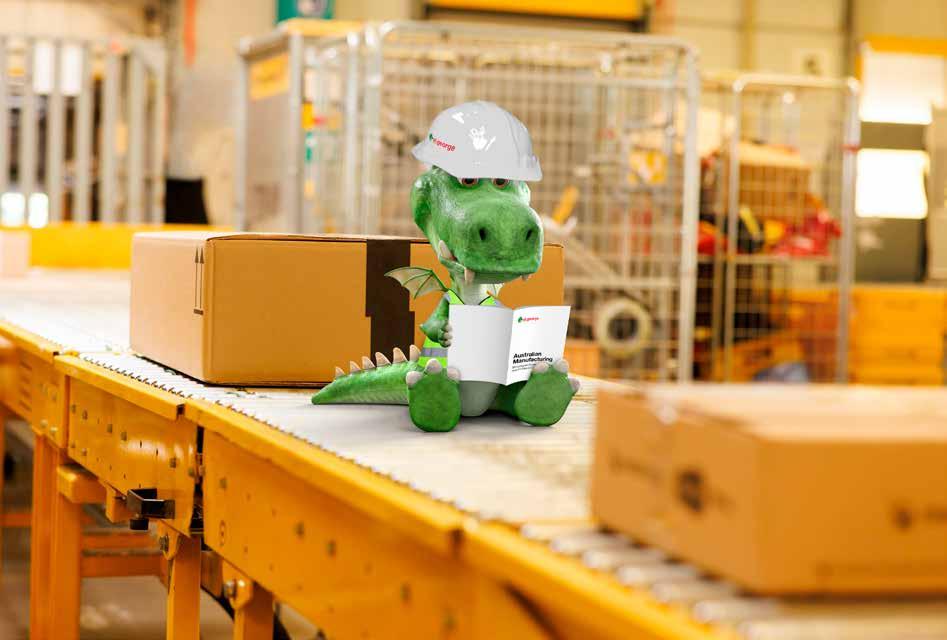
The Report Made for Australian Manufacturing
At St.George we are committed to helping Australian manufacturers future proof their businesses. That’s why we have created a report that dives into the upcoming opportunities, trends and challenges impacting the manufacturing industry.
In our latest report: Australian Manufacturing: Bringing on Productivity and Profits in 2024 you’ll learn more about
• how AUKUS opens a world of opportunity
• the shifting labour market
• riding the high-tech revolution
• growing cyber threats; and
• how climate transition is creating the perfect storm
Scan the QR code to download the latest report
MAKING IT IN MANUFACTURING IN NSW
The report made for Australian manufacturing
By Matthew Kelly, Head of Manufacturing and Wholesale, St.George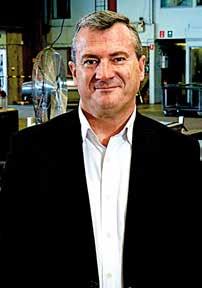
At St.George we are committed to helping Australian manufacturers future-proof their businesses. That’s why we have created a report that dives into the upcoming opportunities, trends and challenges impacting the manufacturing industry.
Australian manufacturers have faced a steady round of challenges in recent years, from the doldrums of the pandemic to a tough economic environment and ongoing geopolitical disruptions. But major opportunities and potential for businesses are on the horizon in 2024.
Many manufacturers have entered the new year with strong cash flow, after a series of Reserve Bank rate rises in 2023. A lot of St.George manufacturing clients are
gearing up for significant investments in machinery and property or seeking growth through business acquisitions.
Digital technologies also present huge growth opportunities for Australian manufacturers, but accessing the relevant tech talent is just one of the industry’s workforce hurdles.
market, the ongoing quest for digitisation and the need to stay ahead of cyber security risks, as well as the potential – and pain points – of the energy transition and how manufacturers can navigate the road ahead.
“Digital technologies present huge growth opportunities for Australian manufacturers”
Our latest manufacturing report outlines five vital themes impacting manufacturers for the year ahead. These include the vast opportunities of the AUKUS alliance, the different dynamics impacting the labour
In our extended report, St.George Senior Economist Jarek Kowcza also delivers insight and foresight on the outlook for the manufacturing sector. Cyber security firm Eftsure, a St.George partner, offers a fresh take on rising cyber threats and the ongoing importance of vigilance for manufacturing businesses, while Sloanebuilt Trailers opens up
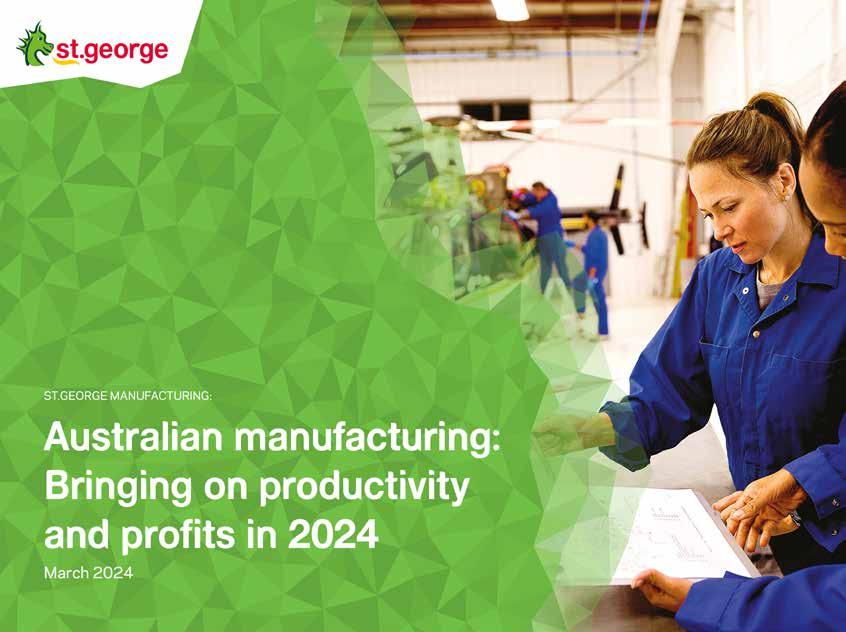

MAKING IT IN MANUFACTURING IN NSW
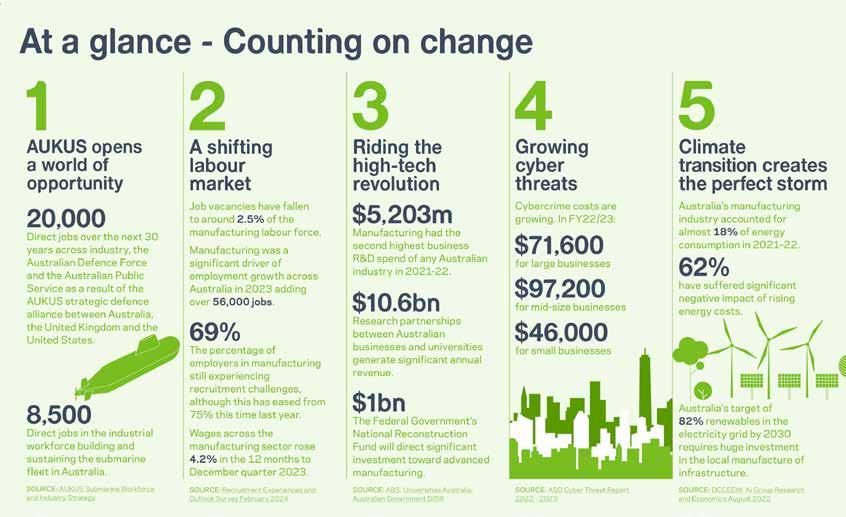
“How smart manufacturers are seizing opportunities in the current economic climate”
on how smart manufacturers are seizing opportunities in the current economic climate.
Scan the QR code to download our latest report.
Report highlights:
• The AUKUS alliance offers substantial job opportunities, with projections of 20,000 jobs over 30 years across various sectors
• Job vacancies in manufacturing have decreased to around 2.5% of the labour force
• The Federal Government’s National Reconstruction Fund will significantly invest in advanced manufacturing, amounting to $1 billion
• Manufacturing is among the top three industries reporting ransomware incidents, with 118 recorded in Australia during 2022–23
• Meeting Australia’s target of 82% renewables in the electricity grid by 2030 requires substantial
investment in local infrastructure manufacturing
The manufacturing industry has experienced a tough time in recent years, but the future brings promising prospects. St.George Bank’s latest report highlights five themes shaping the industry.
1. AUKUS alliance
The AUKUS strategic defence alliance between Australia, the United Kingdom and the United States opens a world of opportunity, with significant job creation and market expansion expected in the defence sector. Manufacturers could benefit from increased collaboration with defence organisations and exploring existing technologies to address the needs of the defence industry.
2. Australian workforce
The workforce remains a challenge as manufacturers continue to
experience difficulties in recruitment and rising wages. With government measures aimed at improving skills across the economy, these could make hiring and training easier for manufacturers.
3. Digital transformation
The high-tech revolution is another area which creates opportunities as the federal government invests $1 billion in the manufacturing industry. Collaboration with universities is also helping manufacturers drive innovation and generate revenue.
4. Cybersecurity
Cybersecurity is an increasing concern as cybercriminals become more sophisticated in the way they attack organisations. With manufacturing among the top targeted industries, manufacturers need to include control procedures such as creating a security-aware culture
among their employees to reduce the risk of cyber threats.
5. Clean energy transition
Energy transitions present both challenges and opportunities. Rising energy costs are a concern, but the shift towards renewables offers new avenues for growth. Manufacturers are encouraged to diversify energy sources and explore the potential of critical minerals for renewable energy production as well as the manufacture of infrastructure such as wind turbines.
Find out how we could help your business, including through our relationships with industry partners and government agencies, today.
St.George
MAKING IT IN MANUFACTURING IN NSW RBA off the field and on the bench, for now
By Besa Deda, St.George Bank Chief EconomistThe Reserve Bank (RBA) left the cash rate on hold at 4.35% last month. This surprised no one. Markets and economists alike expected this on-hold decision. The threshold for another rate hike is high and the need to start cutting rates is not yet pressing.
At its February meeting, the first for this year, the RBA inserted words in the final and most pertinent paragraph of its media statement that suggested it was not ruling out further rate rises. That is, it maintained the bias to raise rates. However, at its most recent meeting in March, the central bank replaced those words, instead saying it is neither ruling anything in or out. This suggests it has now pivoted towards a more neutral stance.
Indeed, the RBA has effectively come off the playing pitch and is now sitting on the bench watching the game (i.e. the data) and assessing when it returns to the pitch with a rate-cutting psyche instead. This position is evidenced by the statement saying, “the path of interest rates that will best ensure
that inflation returns to target in a reasonable timeframe remains uncertain and the Board is not ruling anything in or out”. The RBA Governor, Michele Bullock, in last month’s press conference also said there are “risks on both sides” and the risks are “finely balanced”.
The RBA is likely to continue to watch services inflation closely. The latest inflation report shows some early signs it is rolling over, but the RBA reiterated “services inflation remains elevated, and is moderating at a more gradual pace”. Bullock referred to services inflation being high overseas, likely a reference to the US where persistent price pressures remain a risk in the services sector. Indeed, in the US interest-rate markets have continued to lengthen the odds of a near term rate cut, as data on inflation and jobs continues to suggest some risk of persistent price pressures.
During the press conference, the Governor was also asked about the Fair Work Commission’s latest decision to grant aged care workers a further pay increase of up to 14%
and the impact this might have on wage and services inflation. The Governor characterised the wage increases as being a worthy increase for a historically underpaid sector that is experiencing labour shortages. The Board will be watching for any potential spillovers to other industries and sectors.
Financial markets are fully priced for rate cuts to start in September this year. The Group view matches this market view. The RBA is still waiting for more evidence of inflation returning to its target band of 2-3% per annum before it comes off the bench to play in the rate-cutting field. The Board will need to be convinced that inflation will hit the target and stay there.
The RBA Governor continues to stress a cautious wait-and-see approach, suggesting rate cuts in the near term are not likely and there is still some way to go before it is confident of inflation coming back into the band.
Bullock also took a leaf from the book of her predecessor, Philip Lowe, saying she was a firm believer that the Australian economy is “still
NSW government to rebuild domestic manufacturing capability
The manufacturing industry will be a priority for the NSW Labor government, with politicians committing to rebuilding the sector.
Minister for Domestic Manufacturing and Government Procurement Courtney Houssos met with 10 manufacturers at a roundtable hosted by the Advanced Manufacturing Growth Centre (AMGC) in Sydney.
The forum included representatives from a diverse range of businesses including manufacturers of electronics, defence componentry, unmanned aircraft, sustainable proteins, road tankers, water infrastructure, staging, and medical devices.
The wide-ranging discussion covered challenges including accessing capital, leveraging government procurement spend to promote domestic manufacturing and the government’s commitment to establishing local content requirements.
The NSW government also committed to creating the Jobs
First Commission to oversee the implementation and growth of local industries, supporting and advocating for local firms in bidding for government tenders.
The Minister underlined the importance of having a sovereign manufacturing component.
“We know that for every one job in manufacturing, a further threeand-a-half are created in the supply chain, and we want those jobs in NSW,” she says.
“The government plays a unique role supporting NSW manufacturers by encouraging workforce growth, supporting more skilled labour, and committing to buying locally made content.
“We want to see our precious government procurement dollars put to good use. Spending procurement dollars on locally manufactured goods means the NSW economy can enjoy the multiplier effects of those investments.
“The NSW government is
committed to transforming the state’s procurement framework and practices, but it will take time. Doing so can promote local industries, accelerate economic growth, promote regional development, and ensure jobs remain onshore.
“We are committed to leveraging the power of government procurement to promote local jobs and foster our local manufacturing industry.
After speaking with industry leaders, Minister Houssos has a new insight on the problems facing the industry.
“We’re keen to find ways the government can turn around the last lost decade of manufacturing in NSW, after the neglect of the previous Liberal-National government,” she says.
“I am committed to meeting regularly with the industry to better understand where we can assist with growth and implement action.
“We want workers, business and investors to know we’re backing NSW.”
AMGC managing director Jens
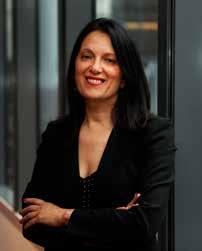
on a narrow path”, suggesting engineering a soft landing for economic activity whilst bringing inflation back to the band remains in reach.
Complicating the economic outlook and potentially keeping the RBA on the bench will be the Federal Budget in May and the impact of Stage 3 tax cuts from 1 July this year. Both of these have the potential to underpin firmer economic activity. The RBA will be watching closely.
St.George Bank stgeorge.com.au
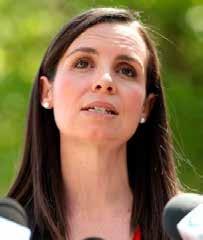
Goennemann believes that unlocking government buying power to support local industry growth is a smart strategy.
“By engaging with industry through AMGC, Minister Houssos and her team are able to identify quick wins as well as long-term policy reform to unlock the power of manufacturing,” he says.
“In turn, these activities will scale businesses, creating higher paying, more resilient jobs for the people of NSW, while generating greater prosperity for the state.”
MAKING IT IN MANUFACTURING IN NSW
Bonfiglioli solutions aid recycling and waste management sectors
Recycling is no longer just a buzzword, it’s a measurable goal that businesses and governments are committed to. The 2019 National Waste Policy set 2030 targets and actions for waste and recycling, including an 80% average resource recovery rate and a significant increase in the use of recycled content.
The 2022 National Waste Report found that Australia’s resource recovery rate for 2020-21 was 63%, while the recycling rate was 60%.
Bonfiglioli Australia and New Zealand Managing Director Martin Broglia believes the right machinery is one of the factors that can help achieve the 2030 targets.
“The best way to get this right is to ensure that our waste management plants have access to efficient, safe and reliable machinery. Bonfiglioli, active in the recycling sector for several years, is committed to the
development of products and solutions that help waste management and recycling plants work to their full potential,” he said.
Meeting application-specific requirements
Bonfiglioli’s custom solutions for recycling include inverters, motors, gearboxes and geared motors.
“From the initial consultation, our engineering specialists and design teams collaborate closely with customers to understand their needs, calculate and simulate their machine or system capabilities and optimise the associated transmission performance,” Broglia said.
“We ensure that the end product meets their application-driven performance specifications, their installation limitations and their maintenance requirements and will deliver great results.”
Heavy duty solutions for recycling systems and standalone machines
Recycling systems usually include shredding machines, compactors and conveying systems.
“Our R3 Series, for example, is ideal for use in primary shredders, as it can handle shock loads and impacts. These compact and powerful gearmotors also offer flexibility, with various mounting options. If extra torque is required, we can add a hydraulic motor adapter,” Broglia said.
The company’s 300M Series offers the high peak load capacity and mechanical performance for the 2.0 kNm of torque characteristic of secondary shredding.
For conveying systems, the parallel shaft F-Series and the helical bevel A-Series, offer high dynamic response and energy efficiency.
The compact C Series of geared motors accommodates a broad range of compactor requirements. Featuring a wide output torque range and gear ratios, it can be coupled with electric motors for additional torque and output speed.
Bonfiglioli also designs and produces custom solutions for compact
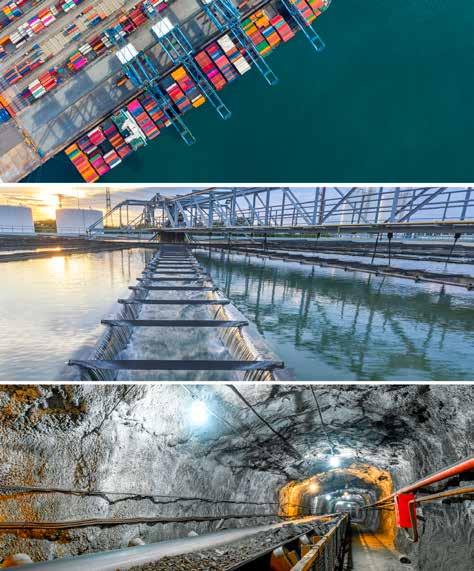
stand-alone machines, such as reverse vending machines that process individual items.
“Whether it’s recycling of paper and plastic or rubber tyres, or even general waste handling applications, our solutions have proven effective, particularly because we focus on application-driven customisation,” Broglia said.
“We are well-positioned to help Australia’s waste management and recycling sector achieve the goals set out by the National Waste Policy Action Plan.”
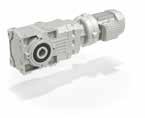

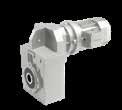
Creating tomorrow’s solutions, today
For over 60 years, Bonfiglioli has been developing tailored transmission and drive solutions for industrial automation and wind energy.
With a network of 21 branches and 14 production plants in 80 countries around the globe, we bring you tried and tested world class solutions. Let’s build the next 60 years, together.
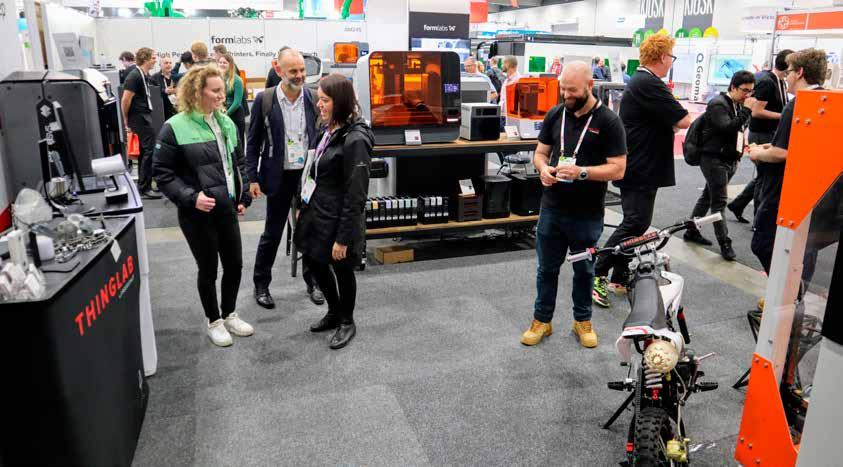
AMW2024 is just around the corner
Australian Manufacturing Week (AMW2024) is an unmissable event for anyone working in the advanced manufacturing sector.
It showcases the latest industry innovations, technologies and equipment - all under one roof. And it provides colleagues with the opportunity to meet and network with leading experts.
It’s not too late to get involved, registrations are still open for
AMW2024, which will be held at the ICC in Darling Harbour, Sydney, April 17-19.
Organised and run by the Australian Manufacturing Technology Institute Limited (AMTIL), AMW2024 will occupy more than 6,764 square metres of exhibition space.
Over 270 organisations will showcase the latest manufacturing technologies, processes and support services.
To make the most of the key
exhibitors, stands, people and attractions, schedule your days with the My Show Planner, https:// amw2024.mapyourshow.com/8_0/ login/login.cfm
The My Show Planner online tool has everything you need to make the most of your time at AMW2024, it is the visitors-side view of Map Your Show.
Use it to connect with exhibitors online, set up appointments and plan your day so you don’t miss a
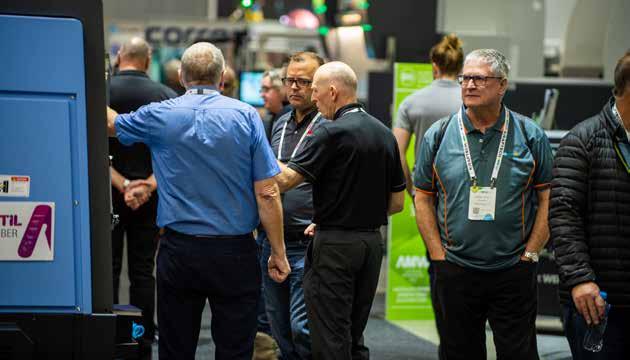
thing. It also contains exclusive content, revealing details about exhibitors and their products.
Listings include featured exhibitors, details and bios of speakers at the Future Solutions Speaker Sessions, product and exhibitor category listings as well as exclusive exhibitor collateral.
Next up, download the AMW Expo mobile app and log in using the same details you used to create your My Show Planner profile. The app will help users navigate the show floor, highlighting selected companies, stands, locations and products. AMW2024 is just around the corner and attendees can now log in and set up their day with the app. Use it to;
• Search products that are of specific interest
• View the entire exhibitor list
• Research relevant product zones
• Navigate the show floor plan to find the key exhibitors
• Set up meetings with company representatives
• Receive important notifications so you don’t miss out on events and activities during the show
If you haven’t done so already, register now for AMW2024.
WHS duties for manufacturing industry
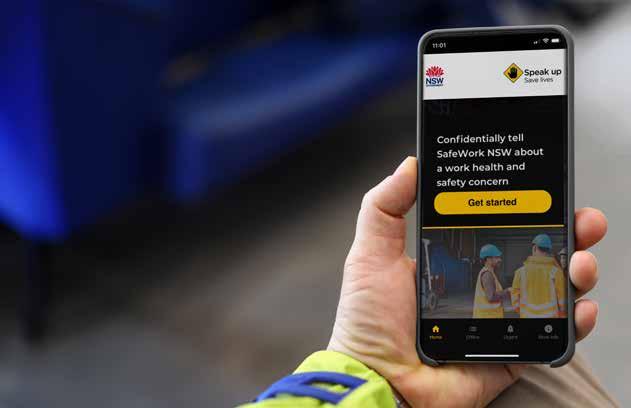

SafeWork NSW, the workplace health and safety regulator in NSW, acknowledges manufacturing as a cornerstone of a strong Australian economy. The regulator has an ongoing commitment to manufacturing which ensures a safe work environment for all workers — achieved by working with NSW businesses to reduce work-related fatalities, serious injuries and illnesses.
As part of its education outreach, the regulator will be attending Australian Manufacturing Week, given that the expo attracts diverse manufacturing industries.
“It also attracts a large variety of WHS duty holders,” says Natalie Martin, Director of Investigations, Engineering and Enforcement at Safework NSW.
“We want to connect and engage with the various WHS duty holders across manufacturing.”
Regulatory priorities
SafeWork NSW’s Manufacturing
Sector Plan was developed to influence safety improvements in NSW manufacturing. In 2023, SafeWork identified specific regulatory priorities across risk types and sectors which includes ‘safety around moving plant’.
Martin says, “Our regulatory priorities were designed to ensure employers and workers understand their WHS duties so all workers have healthy, safe and productive working lives.”
SafeWork has been notified of multiple workplace incidents involving collisions between mobile plant, inadequate guarding, bypassing of safety devices and ineffective energy isolation.
“We find there is usually more than one factor contributing to an incident,” says Martin.
At the moment, the regulator has a strong focus on people and plant, with forklifts in the spotlight.
Duties and obligations
All duty holders must be aware of their work health and safety duties, which are not transferable. One person may have more than one duty and more than one person can have the same duty.
A strong culture of safety is integral for business. This is underpinned by strong leadership and a genuine commitment in promoting a safety culture in workplaces.
“When Safework is making enquiries, we consider every duty holder, this includes designers, manufactures, importers, suppliers, installers and the end user”, says Martin.
Consultation and hierarchy of controls
Consultation is essential in managing WHS risks and is a legal requirement under the WHS Act. All duty holders need to collaborate to develop ways to manage risks. Designers, manufacturers, importers, suppliers, installers,officers and persons with management or control roles all have responsibilities to provide information to help other stakeholders manage plant risks.
When it is not reasonably practicable to completely eliminate risks, a ‘hierarchy of controls’ must be used by duty holders to minimise risks.
Eliminating the hazard and risk is the highest level of control, followed by reducing the risk through substitution, isolation and engineering controls. Reducing the risk through administrative controls and protective personal equipment is the lowest level of control as these controls’ effectiveness relies on human behaviour and supervision. Administrative controls are not enough on their own and should only be used to supplement higher level controls.
“Some incidents indicate a lack of awareness of the hierarchy of control, often a control that’s too low level has been implemented, such as providing instruction, training and supervision only”, says Martin.
Energy isolation
Unexpected startup of plant is a common cause of incidents that can
cause injury or death. Often, inadequate isolation of energy sources during maintenance, fault-recovery or repair work, is the cause.
Duty holders need to be aware of various energy sources and their respective isolation requirements. Authorised workers must be given relevant information and training to perform effective energy isolation.
It is also critical that workplaces have a process to ensure energy to plant and equipment is fully isolated before any maintenance or repair work is done.
Maintenance
Regular plant and equipment maintenance and inspection are necessary for safe operation.
Clause 213 ‘Maintenance and inspection of plant’ of the WHS Regulations 2017 requires that the maintenance, inspection and testing (if necessary) of plant is done by a competent person. Maintenance records can be kept to demonstrate compliance with legislation.
Documentation
Lack of documentation with the supply of plant could result in inadequate maintenance possibly leading to incidents.
It is mandatory under WHS legislation that information be provided from plant designers to manufacturers, manufacturers to importers and suppliers, and from importers and suppliers to end-users. The information should outline the plant’s purpose, safe operation, maintenance, installation, commissioning,handling, storage and plant decommissioning.
Chapter 5 ‘Plant and structures’ of the WHS Regulations 2017 also covers duties of designers, manufacturers, importers, suppliers, installers and persons with management or control of plant.
Reporting
Raising a safety concern at a workplace can save lives. SafeWork NSW responds to incident notifications
24/7. Call SafeWork NSW 13 10 50 for advice, resources or to report unsafe work activities anonymously via the ‘Speak Up’ app downloadable from the App Store or Play Store. SafeWork’s team will be ready to discuss any facets of workplace safety at AMW 2024, 17-19 April, at the NSW Govt RA350 booth.
Safework safework.nsw.gov.au
AUSTRALIAN M ANUFACTURING WEEK
From railways to air compressors, Atlas Copco has a rich history
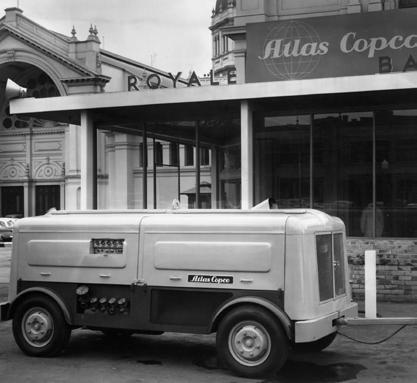
Most people would know Atlas Copco for its compressed air and gas products. But that’s not what the business provided in 1873 when it was founded in Stockholm, Sweden.
It was originally a manufacturer of products for railways, supplying products for the railway expansion in the late 1800s. From there it expanded into compressors, tools and rock drills needed to industrialise the world.
Today, Atlas is recognised for its world-class air compressors, low pressure blowers, nitrogen and oxygen generators, air dryers, filters, air receivers, piping and other energy efficient compressed air products. Its commitment to innovation, excellence, sustainability and customer-centric solutions has established a reliable name in the compressed air industry.
As the company has grown and developed, its purpose has remained the same — to shape a better tomorrow by empowering customers to grow and drive society forward. It has also kept the same values: innovation, sustainability and doing business in an ethical way.
Over the last 151 years, its commitment to hiring passionate employees whose drive and ideas help find new and better ways to shape the future has made it an industry leader when it comes to compressors, tools, vacuum pumps and construction equipment.
Atlas Copco first got into the compressor game in 1904 when it started making piston compressors in-house. Since then, it has played a major role in advancing compressor
Copco became the first company in the world to present a transportable piston compressor supplying oil-free compressed air. A parallel breakthrough was the launch of a stationary oil-free compressor, the Z series. It was named Z because it felt like a development ‘at the end of the alphabet’ as far as you could imagine innovation. The Z series made compressed air viable for new markets, including the textile, food and medicine industries.
“Today, we are proud to be a leading force in the global energy transition, supporting emerging market trends in the shift away from fossil fuels,” Mareels said.
“For instance, the electric car and battery industries rely heavily on large amounts of compressed air. Another emerging market is the maritime industry, where our low-pressure turbo and screw blowers can be used for hull lubrication to increase ship fuel efficiency.
“At the Atlas Copco Group, energy efficiency has always been a strong focus and now we’re prioritizing it like never before to do our part to help our customers meet unprecedented sustainability and energy challenges.”
Reimagining the way engineers work with digital twin technology
During its 150+ years, the Atlas Copco Group has reinvented itself many times, at both the Group and product levels. It went from rail to compressed air and diesel motors at the turn of the 1900s and then transformed again from Atlas Diesel to Atlas Copco in the 1950s. More recent examples are the creation of the Vacuum Technique business area in 2017 following strategic acquisitions and the spin-off of the Group’s long-time mining equipment operations into Epiroc in 2018.
technology to meet new industry needs — a role that the Atlas Copco Group is intent on maintaining.
Today, compressor technology at the company is being reimagined, once again, by the Antwerp-based team led by Guy Mareels, Vice President Engineering at the OilFree Air Division. He is an example of the passionate people Atlas hired — he joined the company 17 years ago, starting out as a calculation engineer running simulations.
“Atlas Copco has repeatedly made breakthroughs in oil-free air ever since the first oil-free series in the 1960s,” Mareels said.
“We are now making another quantum leap in energy efficiency with a new generation of oil-free screw compressors.”
Opening up potential for new markets
Reinventing existing products is core to the Group’s operations. In the 1950s, Atlas Copco made two key moves that transformed its compressor business to meet new demands.
The first was purchasing the rights to Swedish inventor Alf Lysholm’s screw compressor in 1954, a technology that greatly increased compressor capacity. The second was the acquisition of Arpic, a highly efficient Belgian compressor factory in 1956.
After designing the company’s first air-cooled portable compressor in 1952 in collaboration with engineer Karl-Erik Hilfing, Iwan Åkerman relocated to Antwerp in 1956 to head up R&D at Atlas Copco’s new base for compressor operations.
A decade later, in the 1960s, Atlas
“We also have a new generation of compressors rolling out to empower low-carbon utilities and are working on higher-pressure solutions for compressing hydrogen and CO2, which are poised to be a big wave of the energy transition.”
From VSD to VSD+ – a journey of energy-efficiency leadership
In the 1970s, a company team set out to bring about the next phase in compressor technology. Its work initially led to making several compressor parts more energy efficient, especially motors. This laid the foundation for taking the promising variable speed drive (VSD) technology to new levels, making it even more efficient and also better adapted to customer needs.
The company’s VSD prototype was completed in the late 1980s and was launched on the market in 1994, rapidly becoming a bestseller and driving enormous energy savings. In 2000, the team working on VSD won the John Munck Award.
“VSD was a game changer and now we’ve recently leveled it up to VSD+ with two-stage compression,” Mareels said.
“By powering each element with a separate motor, this further improves energy efficiency, performance, and uptime. Just as the original VSD was combined with motor efficiency improvements, we are now also introducing more efficient motor technology to go hand in hand with VSD+. The two types of new and improved VSD+ motors are the permanent magnet synchronous motor and the synchronous reluctance motor.
Building on that legacy, the company is now completely reimagining the way engineers work with compressor technology. With connected, advanced telemetry from compressors and digital twin technology, Compressor Technique engineers can now see exactly how machinery is being used by customers out in the real world.
“I’m excited about all the gains we’re seeing from our digital twin deployment,” Mareels said.
“For instance, we can leverage the data to discover issues before the customer even notices them – something that was unthinkable five years ago. The digital twin data is also a highly valuable tool for identifying sales and service needs. Young engineers joining us now will probably wonder how it was ever possible to design products without all this data.
“This is only the beginning, too. Imagine the possibilities in the future when customers can connect their ecosystems to our digital twin and open a whole new world of data-driven compressed utility room operations.”
In the current landscape of technology advancements, Atlas Copco continues to stand as a beacon of innovation. It is committed to progressing towards a carbon-neutral society. From pioneering smart, connected technologies that propel us towards Industry 4.0, to revolutionising compressed air solutions for diverse applications. As we navigate towards a green economy, its innovations empower us to build a more sustainable and efficient world.
Atlas Copco Compressors
Shaping the future





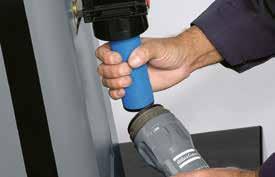

Atlas Copco Compressors are focused on driving customer development with our energy efficient and innovative portfolio of:
Experience the Atlas Copco difference. Partner with a brand with over 150 years of innovation!
*our latest compressor range provides up to 60% energy savings!
Page 2. Discover 10 easy steps towards energy efficiency for your compressed air needs

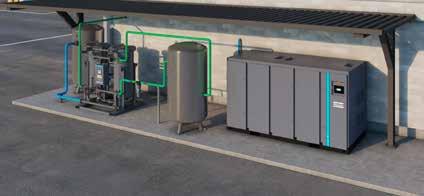

AUSTRALIAN M ANUFACTURING WEEK
600 Machine Tools rebrands to Colchester Machine Tool Solutions
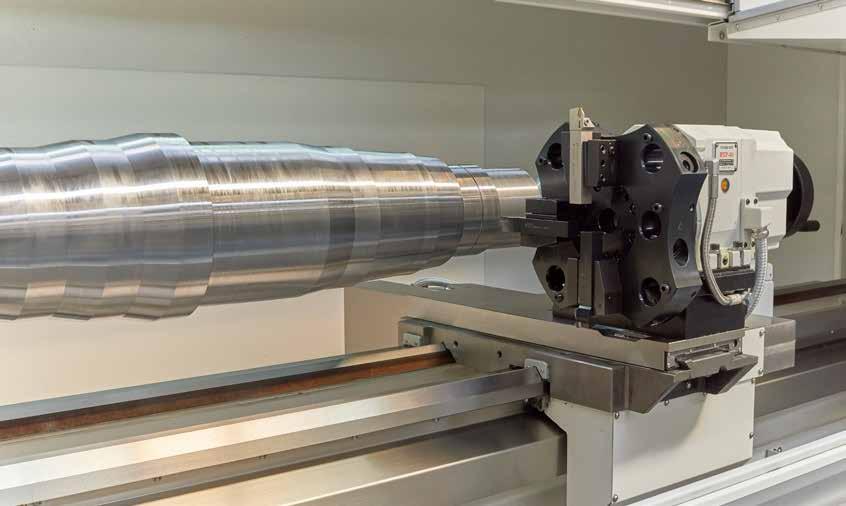
Sometimes, things run their course and it’s time to evolve.
That was one of the reasons behind 600 Machine Tools’ name change.
It made the move in December 2022, to align itself at a global level with its new parent organisation, Incompass Group. It’s now part of a diversified engineering group with a world-class reputation in the manufacture and distribution of machine tools and precision-engineered components. The group sells into over 100 countries and operates three areas of business from locations in Europe, North America and Australia.
While the name is new, the experience is well established. Colchester Machine Tool Solutions (CMTS) is a leading supplier of high-quality machine tools, with a rich history that spans over a century. The new brand builds on the strong foundation that 600 Machine Tools earned over the years. It will continue to provide reliable products designed to endure the demands of dynamic manufacturing environments.
CMTS will introduce a new line of cutting-edge machinery, including the Colchester Storm VMC,
Colchester Tornado turning Centre, the Colchester CV400 CNC Turret Mill and the CNC Student Lathe. These new machines are designed to cater to the needs of a wide range of industries, from mining, oil and gas, aerospace to automotive and beyond. It will also continue to sell its most popular machines like Alpha CNC lathes, Triumphs, both with and without constant surface speeds, students lathes, bandsaws, milling machines and drills.
The Harrison Alpha XC CNC lathe, another product in the Harrison Alpha range, boasts an intuitive control system, an advanced spindle design and a rigid, robust build. It is ideal for high-speed, high-precision turning, making it a valuable addition to any machining environment.
It is also an excellent investment for industries seeking to boost productivity and efficiency. The XC machine comes with full C-Axis and can be supplied with an 8 station VDI 20 indexing turret or Capto toolpost. Built to toolroom accuracy, the Harrison Alpha XC range incorporates turning with milling, drilling and tapping functionality, reducing
the need for second operation production for one-offs and small to medium batches of components.
Incompass Group recently acquired Bridgeport Machine Tools, which adds another impressive line of machines to CMTS’s portfolio. Bridgeport, a leader in metal machining since 1938, offers exceptional CNC and manual milling solutions. It is also known for its high-quality turret milling machines, which are an essential tool in many machining workshops. The acquisition allows CMTS to offer a wider range of solutions to its customers and to consolidate its position as a leading player in the industry.
CMTS’s success is not solely limited to the remarkable features of its machines and their renowned reliability and precision. It is also a testament to the strong relationships with its partners to pave the way for success, ensuring customers receive the highest quality machinery and unparalleled customer service.
Experience CMTS’s machines in action at Australian Manufacturing Week. It is showcasing the flagship Harrison Alpha XS CNC Lathe alongside the Colchester Triumph VS 2500 Centre lathe with the
impressive CSS (Constant Surface Speed) function and two of the latest additions to its portfolio, the world renowned Colchester Student Lathe with CNC function and the Colchester CV400 CNC Mill.
CMTS’s first trade show, AMW Week in Melbourne last year, was a resounding success. Visitors were impressed with the precision and versatility of the machines and the team received positive feedback for the company rebranding and new products. Many old customers became nostalgic and shared stories about their experience of using our machines.
Do not miss the opportunity to see CMTS’s machines in action and talk to its technical experts for detailed information. Find us Australian Manufacturing Week Expo - Stand MT300 at the International Convention Centre, Sydney between April 17-19, 2024 Colchester colchestermachines.com.au
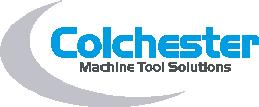
Precision. Power. Performance.

Discover the latest innovations, technologies, and equipment in advanced manufacturing at Australian Manufacturing Week 2024 with Colchester Machine Tool Solutions.
Engage with industry leaders and technology experts in one comprehensive event.
Visit us at stand MT300
17th - 19th April 2024
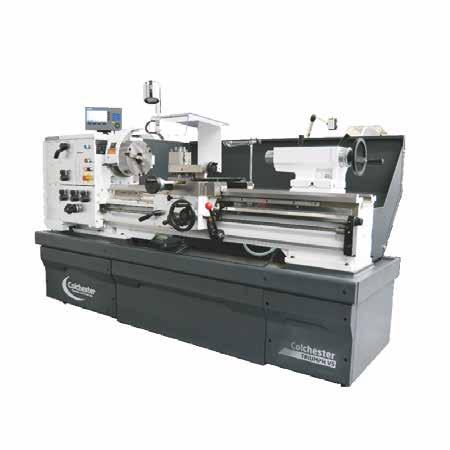

International Convention Centre, Sydney Australia
www.colchestermachines.au
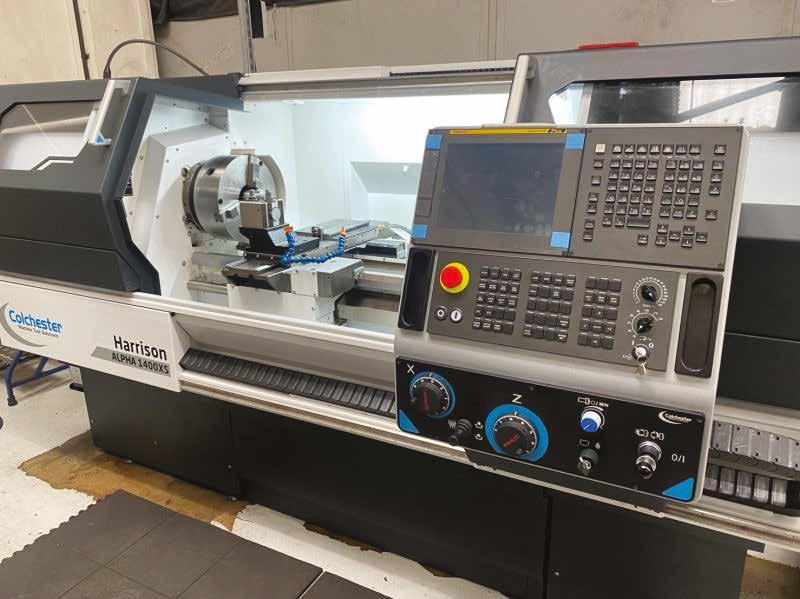
AUSTRALIAN M ANUFACTURING WEEK

How much will you need to retire?
The answer is a complicated one and it often eludes many Australian manufacturing business owners. Immersed in the complexities and demands of running a business in a challenging industry, it’s hard to find time to contemplate personal wealth planning for retirement.
As a business owner, the focus is on the business - how to navigate challenges, grow it and sustain it. But it’s critical that owners look at also building a substantial nest egg for a comfortable retirement. Ideally, it should accumulate in a super fund to benefit from tax efficiencies.
1. Start with a retirement plan
Developing a retirement plan is crucial, yet frequently overlooked by business owners preoccupied with their company’s immediate needs. A robust retirement plan involves:
• Identifying wealth creation strategies that align with their business and personal goals
• Employing effective structures that enhance their financial strategy
• Choosing investment assets wisely, considering their long-term benefits
• Formulating a succession plan to ensure business continuity and personal financial security Planning is essential for understanding when they can retire, the nature of their retirement and the lifestyle they aspire to maintain. Once you can define what constitutes a comfortable retirement, then you can work towards accumulating the necessary funds to support it.
2. How much should I save prior to retirement?
Determining the necessary retirement savings can be challenging, particularly for business owners more versed in corporate finance than personal wealth. A general rule is to gather investments worth roughly 20 times your targeted annual income, assuming you own your home outright and won’t be depleting
your capital. For example, to secure a $50,000 yearly income, you should aim for $1million in savings. Financial advisors often suggest that Australian couples need $65,000 to $85,000 annually for a comfortable retirement, though this amount may increase depending on different lifestyles and unexpected health concerns.
3. Where can I add extra to my savings?
For business owners, determining how to bolster retirement savings is key. Maximising the $27,500 concessional contribution cap to super is a strategic move, offering tax benefits and enhancing superannuation funds. Beyond this, additional non-concessional contributions and potentially downsizing the family home can provide extra funds for retirement.
4. Which super fund should I go with?
Choosing the right super fund is pivotal for business owners, something they often neglect amidst their busy schedules. The ideal fund should foster super growth without incurring excessive risks or fees. Attention should also be given to unnecessary insurance policies within super funds that could diminish the balance. Consolidating super funds can mitigate administration fees and enhance returns, however, may require professional guidance to avoid potential pitfalls. For manufacturing business owners seeking advice on retirement strategies or superannuation, professional guidance is invaluable. Visit us at booth MT120 at the Australian Manufacturing Expo, April 17-19, for personalised consultation and insights.
William Buck williambuck.com
Maximise your wealth potential and secure your retirement future in just one hour.
Struggling with retirement planning while managing your manufacturing business? Access the William Buck Wealth Hour, a free session aimed at helping manufacturers craft effective wealth and retirement strategies.
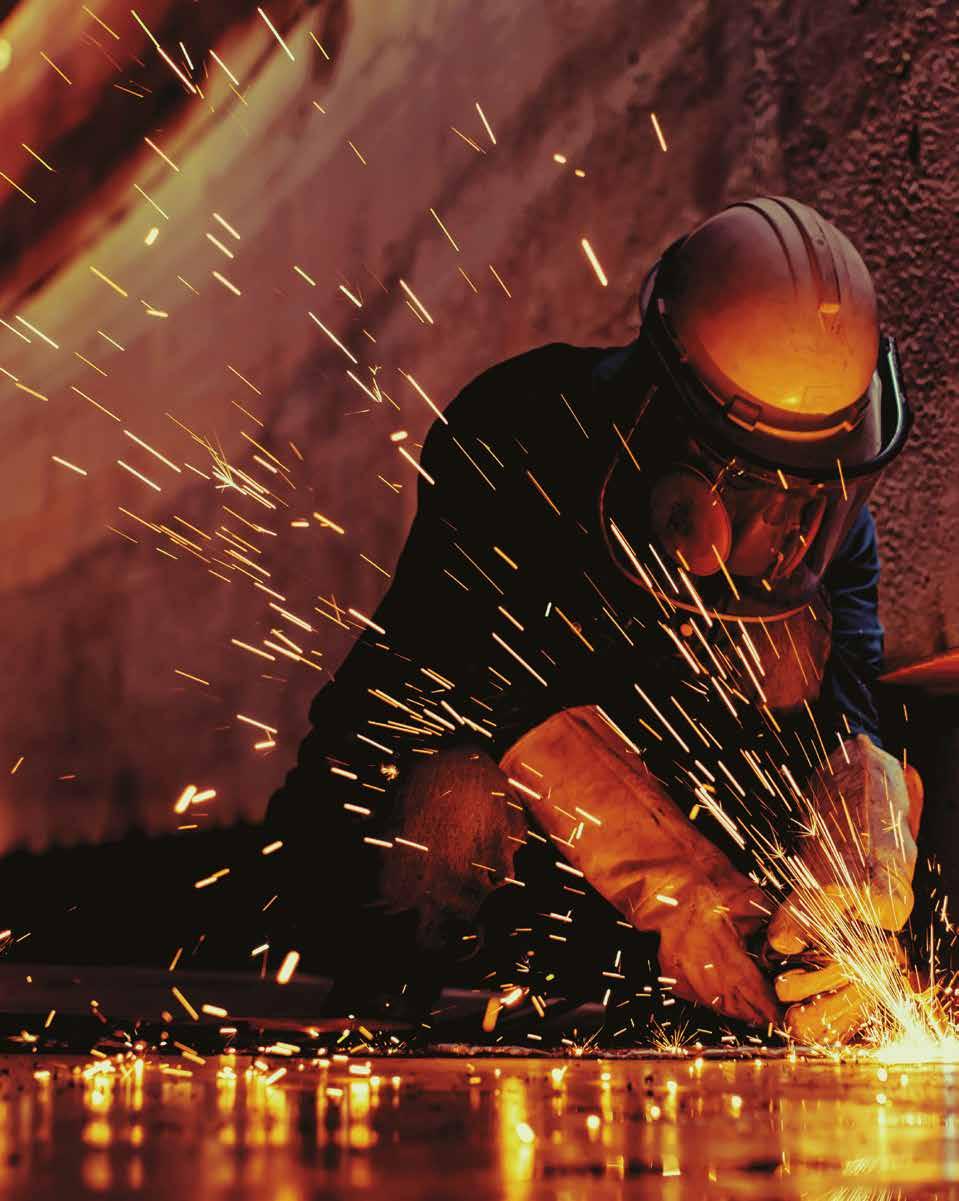
A prioritised wealth and retirement plan
Post-session, our experts analyze your financials, combining industry insights and expertise to devise a comprehensive strategy that meets your retirement aspirations.
Empower your financial future with a plan that ensures your wealth grows alongside your hard work, setting the stage for a prosperous retirement. Let’s talk.

ANUFACTURING WEEK
Omnia brings intuitive mobility to global markets

An omnidirectional wheel has proven a viable alternative to the traditional castor wheel and is taking mobility in new and exciting directions.
The Omnia Wheel™ is designed and produced at the Omnia Wheel (previously Rotacaster) plant in Beresfield, NSW. The company believes in investing and innovating in modern manufacturing in NSW.
Through its investment and innovation, the business is also helping other companies, both locally and worldwide, to differentiate and innovate.
A highly capable mobility wheel
The Omnia Wheel is manufactured entirely from engineering polymer, it has an injection moulded web-like structure, with over-moulded rollers on its outer rim that give it multidirectional movement.
Omnia Wheel Managing Director
Peter McKinnon said its unique structure delivers market-desirable capabilities.
“One of these key capabilities is enhanced directional control,” he said.
“The wheel tracks in the direction it’s pointed and responds directly to the direction of force applied to it, providing a more intuitive experience – even across inclines.
“Another is load stability. Because it has fixed mounting (no swivel offset to work around) it has a fixed relationship to the load platform and the centre of load. It also achieves a wider wheelbase width, adding to stability.
“A third capability is its reduced housing and space height. Because it doesn’t have a swivel mount, the mounted height for the same size wheel is reduced. It also means only minimal space is needed to incorporate it into a product.”
Additional capabilities of the Omnia Wheel include an easy, safe
ARBURG machines are, as you would expect, highly engineered. Alongside other new tooling and equipment, they’re enabling the company to work faster and more precisely, sending quality and capacity skywards.
“For our 90 mm to 180 mm wheel range, we’ve now got the equivalent

pivot, impact resistance, greater ability to load share, no castor flutter and multiple simple mounting options. These capabilities make it ideal for any environment, including tough commercial and industrial mission-critical applications.
Capacity now running at a commercial rate
Over the past year, the company has made substantial investments to meet increasing demand, adding 10 state-of-the-art ARBURG injection moulding machines, bringing the total number of operating machines to 18.
These new, German-made
of three cells,” McKinnon said.
“Each cell can deliver approximately 1,000 wheels per shift, which works out at 3,000 wheels per cell per day. This means we can make somewhere between 9,000 to 10,000 wheels per day when running at full steam.
“On top of this, we have a fourth cell solely dedicated to the 50 mm wheel, allowing us to make another 10,000 50 mm wheels a day, equalling a capacity increase of 800%.”
To help fund the investment in the 50 mm cell, Omnia was a recipient of the government’s Manufacturing Modernisation Fund Round 2 Grant (under Rotacaster Wheel Pty Ltd).
Investment has also increased sustainability
Not only has Omnia’s capacity recently increased, but these machines have enabled it to reduce waste by 80% due to its investment in tooling technology, including hot runner systems.
On top of this, the quality of the product produced ensures the wheels have a long lifecycle, further reducing waste and keeping plastic out of landfill.
It’s also been investing in more solar panels. With a 200-kilowatt system now in place, much of Omnia’s daily energy usage is covered.
Rolling into global markets
Some of the current and potential key application areas of the Omnia Wheel include manufacturing, materials handling, MedTech, transport and logistics and robotics.
Omnia’s own intuitive omnidirectional sortation solutions for logistics and manufacturing are a great example of how the wheel and its enhanced functionality can be used.
As well as offering precise, programmable 360⁰ movement, Omnia’s sortation tables are simple to install and robust, reducing maintenance and downtime. They also provide greater load capacity and distribution than traditional units.
“These conveyors, the wheel and our other products, which include the Rotatruck, have attracted significant global interest. In fact, we now have exciting partnerships with Walgreens in the US, Amazon and Milan Airport, to name a few. This is alongside many homegrown partnerships, including Woolworths,” McKinnon said.
“With our wheel, we’ve opened up new possibilities in multidirectional mobility and our investment means we’ve created a capability far beyond our current demand because we truly believe in our product.
“With 80% of our products this financial year being exported around the world and our 800% increased capacity, we’re really ready to engage with new customers and products to help them differentiate and innovate as we continue to take the Omnia Wheel global.”
If you haven’t heard of an omni wheel, you’re not the only one. But this ingenious piece of engineering has revolutionised 3600 mobility and can be a game changer for your product or solution thanks to its unique capabilities.

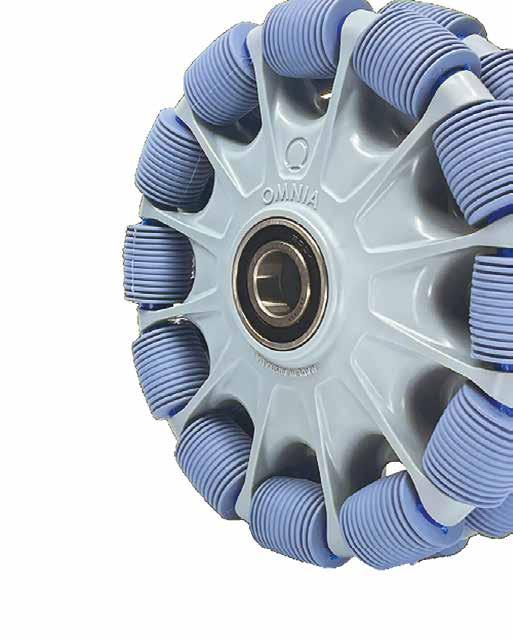
Get ready to improve the safety, functionality and user experience of your product through:
• Precise directional control
• Load stability
• Minimal housing/space height
• Multiple housing options
• Impact resistance
• Greater ability to load share
• No castor flutter
• Easy, safe pivot
sales@omniawheel com
+61 (2) 4907 8100 omniawheel.com
AUSTRALIAN M ANUFACTURING WEEK
Perfect tension for fine screening can be quiet, too
Aproblem sometimes encountered with conventional industrial screening equipment is its inability to provide the many speed variations required for handling diverse fine materials.
Simple metal springs could be too rigid for many tasks demanded by production automation and Industry 4.0 technology, while sophisticated hydraulics may be too complicated for the flexibility and versatility required for very fine material among food and beverage ingredients, processing chemicals, and glass.
Essential ingredients (such as grain-based products and salts in the food and beverage sector) may require further refining, blending, or treatment to enhance their suitability for particular applications.
Engineers, operations staff, and OH&S managers considering isolation options increasingly have to take account of the noise. Loud noise can create physical and psychological stress and reduce productivity and can interfere with communication and concentration. When it’s difficult to hear
warning signals, noise can contribute to workplace accidents and injuries.
One solution in such cases may be Firestone Airmount® isolators from national distributor Air Springs Supply Pty Ltd. These quiet, simple, durable, and friction-free isolators (and closely related Airstroke® actuators) are in essence immensely strong rubber and fabric-reinforced balloons, or bellows.
Because Airmounts use air as the isolation media rather than a solid material, they transmit less high-frequency vibration.
They also enhance fine control. Because they do not exhibit the chatter that conventional coil springs do, they are better suited than coil springs to handling changing loads or overload conditions.
Any given Airmount (and they range in load carrying capacity from 40-40,000 kg) can easily handle a substantial change in load by simply adjusting the air pressure, whereas coil springs are designed for a very narrow operating range. Also, because of their nearly constant
Chewing up springs?
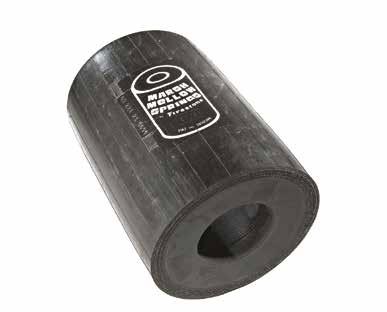

natural frequency, Airmounts react less violently than coil springs during start-up and shut-down, as the input frequency changes.
Applications
The crushing process for fine materials can include a rigorous sifting through screens of various sizes to ensure the material’s uniformity and meet specifications,” says Air Springs Supply General Manager Simon Agar.
A key step in the grinding process is passing ground matter through vibrating screens that sift out large particles. Here, Firestone Airmount isolators can be used on vibrating decks powered by a motor.
Operators can adjust the kPa/ PSI input based on the speed they’re running the motor.
Airmount® isolators can also help take the harmonics out of vibrating bars employed on some screening equipment. Laying a vibrating bar on air takes out any whipping motion and allows the bar to move uniformly.
“Any type of hydraulic device can come with headaches due to their
high PSI, leakage, etc,” says Agar.
“And coil springs – in addition to being sometimes too rigid and not accommodating speed variations required – may be affected by corrosives and grit in ways that the air springs are not.”
In addition to overcoming problems of vibration and noise transmission, Airmounts inflated to different pressures (and occasionally filled with different mediums, such as water) can be used to change the nature of the vibratory effect being produced by the vibrator motor.
Because friction is reduced, and there are no internal moving parts to break or wear, Airmounts (and sister product Airstroke actuators) are most suitable for high-repetition tasks involving either isolation or actuation. The flexible air springs’ ability to arc without a clevis – to bend and to tolerate uneven and fluctuating loads – also means they are suitable for materials handling tasks such as tensioning webs, belt take-up on conveyors, or powering scissors lifts.
Noise, corrosion, cracking, breakage, vibration, shock, abrasion, bottoming out… springs too stiff or mushy under changing loads… high maintenance and lost production...
Do these vibration isolation problems sound familiar? Then meet the cleaner, quiet and hygienic problem solver Marsh Mellow Air Springs Supply.

These unique solid rubber fabric-reinforced isolators quality manufactured by Firestone are used world-wide for quiet isolation of machinery vibration and for shock absorption in applications including food and beverage, metal manufacturing and mining and energy.
Our Vibration Isolation Design Manual for Marsh Mellow springs details how and where to use compact, cylindrical Marsh Mellow springs for machinery such as compressors, vibrating screens, bin hoppers, blowers and motors, cranes, hammers, bumpers and conveyor stops.
Pool giant goes digital
AUSTRALIAN M ANUFACTURING WEEK

Waterco is pioneering the future of aquatic solutions with smart technology.
Established in 1981, Waterco started as a PVC pipe distributor. Its focus on innovation has resulted in the company becoming an ASX-listed powerhouse that owns the popular Swimart franchise and offers products for residential pools and spas, water treatment and aquaculture.
The NSW-based company exports to over 40 countries and is focussed on climate-friendly solutions with 46 patent applications for energy and water-saving products.
Focusing on smart technology
Waterco’s next big innovation lies
in smart products powered by the Internet of Things (IoT).
It is in the process of launching IoT-enabled products like chlorinators and heat pumps.
Chief Commercial Officer Jo Ainsworth said the company is also building one platform to combine data and proactively serve customers. The IoT platform promises to change the experience of pool and spa owners who can spend less time on maintenance.
“We’re creating one place for customers to manage IoT products, servicing and maintenance for their pools and spas,” she said.
“The platform will eventually ping users and let them know when
chemicals are required or a service is due. It’ll be really easy for customers to take care of their pools and spas and access maintenance history at their fingertips.”
Transforming business operations
Alongside customer innovation, Waterco is enhancing business operations. ANZ IT Manager Marco Contreras is leading the charge by overseeing several digitisation projects.
“Over the last few years we’ve been moving into the cloud and focusing on streamlining our processes,” he said.
“We’re integrating shipping portals with customer service platforms and using AI to help answer customer queries.”
Waterco has also transitioned to a cloud-based enterprise resource planning system (ERP), Epicor Kinetic, and integrated it with customer relationship software, SugarCRM. Waterco is the first Australian company to activate an integration between these two products and now, it’s significantly easier for sales teams to manage customer interactions.
Reps can see the status of a customer’s account at-a-glance and talk about new promotions and products like the IoT-enabled pool products. Quotes can also be created on the spot.
“Our sales teams were managing clients with spreadsheets. Now they just log into Sugar and access all the data they need for a productive conversation,” Contreras said.
“Our sales reps are fully prepared before walking through a customer’s door.”
The cloud-based integration is helping Waterco make more databased decisions.
“We have a lot of data touchpoints,” Ainsworth said.
“With Sugar, we are getting a 360-degree view of customers which will help us tailor future interactions and provide even better service.”
The next few years will see Waterco continue to digitise and create smart products, helping the company stay competitive and continue to enter new markets.
SugarCRM sugarcrm.com













M ANUFACTURING WEEK
Water jets are ideal for precision cutting
For detailed projects that require a high level of accuracy and flawless finish, a water jet is the ultimate cutting tool.
It offers power and precision when it comes to cutting materials such as metals, porcelain, glass and rubber.
Water jets work by transporting highly pressurised streams of water and abrasive particles, such as garnet, through a nozzle at high speed to create a cutting tool.
SAME Water Jet Australia was established in 1997. The family business has participated in the formulation of China’s first national standard for waterjet, ‘Ultra-high Pressure Waterjet Cutting Machine GB/T 26136-2010’. Its machines are sold in more than 45 countries around the world.
Director Karen Li said the company’s point of difference is that it has its own factory which produces the water jets.
“We manufacture the machines at my father’s factory in China so that we can control our product quality and we can do customised
products,” she said.
“It also means we can give our customers the best price for the best product. I think this is our advantage in the Australian market.”
Li believes people choose water jets because of their high level of accuracy.
“When it comes to cutting steel, some people may use a laser cutter, which would be more efficient, but a water jet would give you a better finish,” she said.
“It is a cold cutting method, so it won’t damage the cutting edge like the heat from a laser would.
“For materials like glass or porcelain, you have to use a water jet because these materials are very fragile. Other cutting methods would just damage the material.”
One of Same Water Jets’s most popular products is the HJ400 direct-drive waterjet pump.
“It has a five axis cutting head, which allows you to cut 45 degree angles so it can meet a lot of requirements from different industries,” Li said.
“If you’re making a benchtop, you need 45 degree cutting to cut the
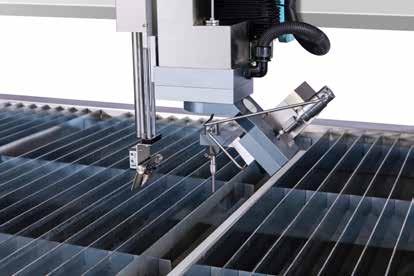
stone to make the 90 degree angle.”
Same Water Jet customers include glass factories, metal fabricators, stonemasons and those working with insulation materials.
As well as selling the machines, it provides local after-sales support and stocks spare parts in its Sydney warehouse for different brands of water jets.
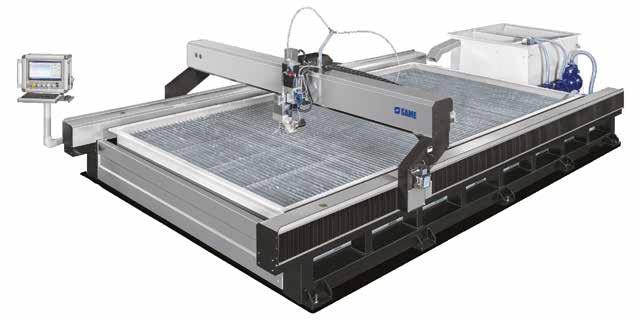


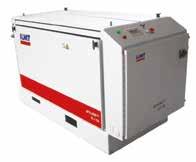
I.M.A’s strategic capability and B2B marketing experience means we can offer you the kind of service you’d expect from both a traditional consultancy and advertising agency combined. Trusted
• Strategy & Growth Consulting
• Brand Strategy
• Customer Research & Experience
• Customer Acquisition
• Media buying
• PR, Content & Social
• Design & Production
• Video Production
• Digital Marketing
• Web Development imab2b.com | info@imab2b.com

AUSTRALIAN M ANUFACTURING WEEK
CSIRO’s next-gen clean energy breakthrough
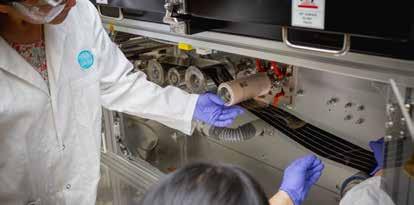
More than a decade’s worth of research and development has come to fruition, with the CSIRO setting a new efficiency record for fully roll-to-roll printed solar cells.
Printed onto thin plastic films, the lightweight and flexible solar technology will help meet demand for renewable energy by expanding the boundaries of where solar cells can be used.
While silicon solar panels are rigid and heavy, printed solar cells are flexible and portable so they can be used in previously unimaginable ways across urban construction, mining operations, emergency management, disaster relief, space, defence and personal electronics.
CSIRO’s Renewable Energy Systems Group Leader Dr Anthony Chesman is proud of the achievement, which represents more than a decade’s work.
“CSIRO’s thin and light-weight solar cells are now on the cusp of emerging from the lab to create clean energy in the real world,” he said.
“We’ve solved several engineering problems to achieve record results across a large surface area of interconnected modules.
“Roll-to-roll printing allows for the solar cells to be manufactured
on very long, continuous rolls of plastic, which can dramatically increase the rate of production.
“As these methods are already widely used in the printing industry, this makes their production more accessible for Australian manufacturers.
“The successful commercialisation of printed flexible solar cells has the potential to create significant economic and environmental benefits for Australia and the world.”
Scientists from Australia’s national science agency led an international team to this clean energy breakthrough. The CSIRO collaborated with researchers from the University of Cambridge, Monash University, the University of Sydney and the University of New South Wales. The results have been published in the leading journal Nature Communications.
CSIRO Principal Research Scientist Dr Doojin Vak said that an automated system produced a comprehensive dataset that will pave the way to use machine learning in future research.
“We developed a system for rapidly producing and testing over ten thousand solar cells a day
Blickle Wheels & Castors.
The best solution for every application.

• Ergonomic and high quality solutions
• Adapted to industrial & institutional environments

• Get the right castor for your application

– something that would have been impossible to do manually,” he said.
“This allowed us to identify the optimal settings for the various parameters in the roll-to-roll process and quickly pinpoint the conditions that deliver the best results.”
Incorporating an advanced material called perovskite, CSIRO’s printed solar is different from the silicon solar panels found on Australian roofs.
“Perovskites are a class of emerging solar cell material. They’re remarkable because they can be formulated into inks and used in industrial printers,” Dr Vak said.
“We’ve also alleviated the need to use expensive metals, such as gold, in their production by using specialised carbon inks, which further reduces production costs.”
Acknowledging that perovskite solar cells currently trail silicon solar panels in efficiency and lifetime when produced at scale, Dr Chesman sees the application of flexible panels to be very different.
“As these perovskite solar cells are printed onto plastic films, they are very lightweight, highly flexible and portable,” he said.
“The rigidity and weight of conventional silicon solar panels can make moving them difficult. Our thin, lightweight solar can be easily transported anywhere there is sun.
“We even sent the solar panels to space last week to test their performance, with a view to further optimise and ultimately provide a reliable energy source for future space endeavours.”
CSIRO is actively seeking industry partners to further develop and commercialise this technology.
This Activity received funding





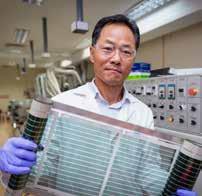
from ARENA as part of ARENA’s Research and Development Program
– Solar PV Research. The results and more technical details:
• Flexible solar cells have been produced using a production method in which all components of the device were fully printed from inks
• The solar cells were printed using roll-to-roll techniques, which can be used to print solar cells on a long, continuous roll of plastic
• The team demonstrated performances for solar cells of 15.5% efficiency on a small scale and 11% for a 50 cm2 module, which is a record for fully printed solar cells
• The solar cells contain perovskite, an emerging class of solar material which can be formulated into inks for printing
• Automatic screening was used to optimise the printing process
• Carbon-based inks have been used to replace gold in the solar cell, dramatically reducing the cost while maintaining high performance
• Technoeconomic modelling has been used to predict the production cost in Australia.




Wiring Systems embraces 3D printing to streamline its manufacturing processes

Wiring Systems is set to harness the potential of Raise3D 3D printers and additive manufacturing.
The contract manufacturer trialled a different model before choosing Raise3D 3D printers from Bilby3D. 3D printing provides Wiring Systems with versatility and speed.
The Raise3D Pro3 Plus allows the company to build its own tooling and fixtures in house, increase its organisation and ease of use of assembly stations and print sub components for its products instead of ordering slow and expensive injection moulded parts.
The Raise3D Pro3 Plus allows the team to set up a print job and walk away, freeing up labour while the machine does the work.
Wiring Systems specialises in diverse industries such as defence, rail and road, medical, recreational vehicles and Solar PV, so it needed a reliable solution that would meet its varied needs and provide
comprehensive support. The previous option wasn’t suitable because of lack of supplier support.
After the initial disappointment, Managing Director Harry Antoguelli was introduced to the Raise3D Pro3 Plus. One of the main considerations was that Bilby3D offers comprehensive support and spare parts are available from Australian stores, which ensures the long-term viability of its investment.
Wiring Systems uses the Raise3D Pro3 Plus for various practical applications, including:
• Hand tool holders - Having a dedicated and foolproof holder for all the hand tools required at a given assembly station means tools don’t find themselves wandering across the workshop. Always having the required tools for a task at arm’s reach is a simple and under-rated system to decrease assembly time and cleanup. It also streamlines process, which aids with new staff on-boarding.
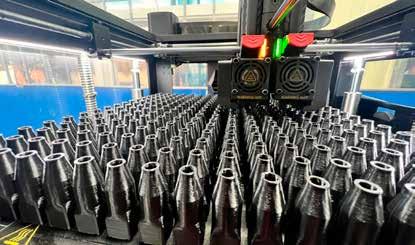
• Assembly fixtures - Some stages of assembling a complex product can be made much easier with purpose built fixtures, which hold a sub-assembly in a given orientation, making it much easier to attach more components, hardware and wiring. Assembly fixtures also help with making a standardised and streamlined process so that all assembly operator are following the exact same steps, ensuring all products are identical rather than having slight differences depending on who assembled them.
• Drilling guides - In the fabrication of some components, precise drilled holes are required. Drill guides are used so that you don’t have to measure and mark each part as it comes through the station. The drill guide is placed over the part and shows where the holes are required.
• 3D printed parts and products
- Printing parts for its wiring harnesses. The 3D printing process enables new design iterations of the parts to be produced immediately and at no additional cost, whereas if the parts were made with another process such as injection moulding, each design iteration is costly and has a long delivery time.
Visit Bilby3D at Australian Manufacturing Week (Stand: AM765) in the Additive Manufacturing Zone from April 17th to 19th, 2024
Bilby3D b3d.com.au

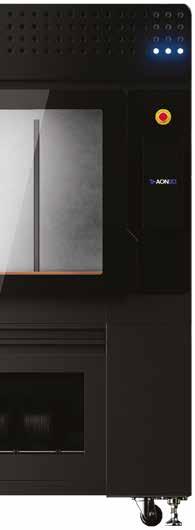

SHOWCASING 7 PRODUCT ZONES
AUSTRALIANMANUFACTURINGWEEK.COM.AU



TAKE ADAVANTAGE OF THE ENORMOUS SUCCESS OF AMW MELBOURNE 2023 AND BE PART OF THE AUSTRALIAN MANUFACTURING WEEK JOURNEY – DON’T MISS OUT!
17–19 APRIL 2024
INTERNATIONAL CONVENTION CENTRE, SYDNEY


AUSTRALIAN MANUFACTURING WEEK
Additive manufacturing transforms meat processing industry

In a high-volume environment like a processing plant, parts such as bolts and rollers can wear or break. Time is money, if parts fail productivity slows until they can be sourced and replaced.
It’s why the Australian Meat Processor Corporation (AMPC) took part in a world-first trial of a 3D printing service mode. The aim was to help red meat processors benefit from printing equipment parts and revolutionising equipment maintenance.
“Staff can create functional prototypes for assessment as well as produce industrial composite parts for end use”
The AMPC is the research and development corporation for the nation’s red meat processing industry. Its mission is to drive world-class innovation, adoption and strategic policy development through genuine partnerships built on trust.
The challenge
The trail is a collaboration between the AMPC, Markforged and Konica Minolta Australia. It involves a threeyear, multi-faceted program, which involves two Markforged X7 carbon
than 1,000 people.
Three areas needed to be addressed within The Casino Food Co-op facility. The first was the hinges on the hundreds of label printers used to produce thousands of labels a day.
The Casino Food Co-op Draftsperson and Project Support Officer, Brian Armstrong, said it was a challenge.
“The plastic hinge deforms and breaks after many years of use. Because the part was discontinued by the manufacturer, the only option would be to replace all the label machines, which would be extremely costly,” he said.
The next area was the leather tannery drum, which removes hair and fat before the leather is dyed. A gear in the tannery failed, which resulted in leather production stopping until a replacement part could be manufactured.
“The impact of stalled production was significant, costing tens of thousands of dollars of product output on the tannery a day,” Armstrong said.
for the label printers as needed, The Casino Food Co-op can now prevent downtime on the machines and ensure that labels can continue to be printed. In addition, the longevity of the label printers has been extended, saving thousands of dollars in replacement costs.
For the tannery, it meant that a temporary replacement could be 3D printed and used to keep the machine running until a new gear could be manufactured. Processing could continue as usual, avoiding significant losses.
“The Casino Food Co-op produces tens of thousands of dollars of product in the tannery each day. The two gears required to keep the machine operational were printed and fitted within 18 hours so there was no loss in productivity,” Armstrong said.
Being able to quickly print a fan
fibre 3D printers being shipped to the processing plants in an innovative ‘try before you buy’ arrangement. Processing staff are trained to use the printers to assess whether they would be a good investment. The units remain on-site for up to eight weeks before rotating to another plant. Staff can create functional prototypes for assessment as well as produce industrial composite parts for end use.
The final area was the fan blades on the evaporators that optimise the temperature in the cooling rooms. If one blade becomes unstable, the whole evaporator breaks apart and the cool room can’t perform at optimal levels. Because the original equipment manufacturer for the evaporators is no longer in operation, the cost of manufacturing new blades was significant.
“Without all cool rooms at full use, The Casino Food Co-op was poten-
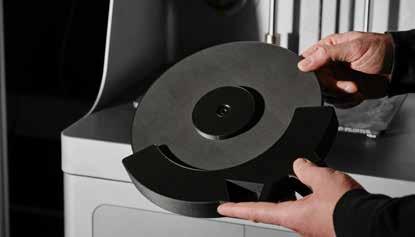
The Casino Food Co-op was identified as a facility that could benefit from 3D printing and trialled the Markforged X7 3D printer.
Since 1933, The Casino Food Co-op has been Australia’s largest farmer-owned, meat processing co-operative. Its paddock-to-plate meat processing plant, in Casino NSW, uses state-of-the-art facilities. The company processes 1,200 head of cattle per day and employs more
tially at risk of not being able to deliver product at full capacity, which would impact our commitment to our partners,” Armstrong said. The solution
The 3D printing solution allowed The Casino Food Co-op to solve these challenges with relative ease and prevent costly downtime across its operation.
With the ability to print new hinges
“The 3D printing solution allowed The Casino Food Co-op to solve these challenges with relative ease”
blade for the cool room evaporators delivered significant cost savings and risk mitigation. to the business.
Previously, the co-op would have commissioned a steel manufacturer to make a replacement blade, costing up to $10,000 each. Meanwhile, meat would need to be moved to where the cooling was working. Now, 3D printing a replacement blade takes days and is a fraction of the price.
The future
“Finding a solution for these challenges was essential. All of the applications we have used the 3D printer for are pivotal to The Casino Food Co-op for equipment maintenance and operation, helping us prevent unplanned downtime and meet our supply contracts,” Armstrong said.
“We couldn’t have achieved this without the support from the Markforged X7, which helped us create solutions that met our needs. The possibilities for 3D printing in meat processing are endless and we look forward to seeing how we can continue to transform with 3D printing into the future.”
The FX10™ Arrived in Australia
FX10™ is Markforged’s next generation industrial composite 3D printer — the result of years of engineering innovation. Its sole purpose is to deliver strong, accurate parts every print.
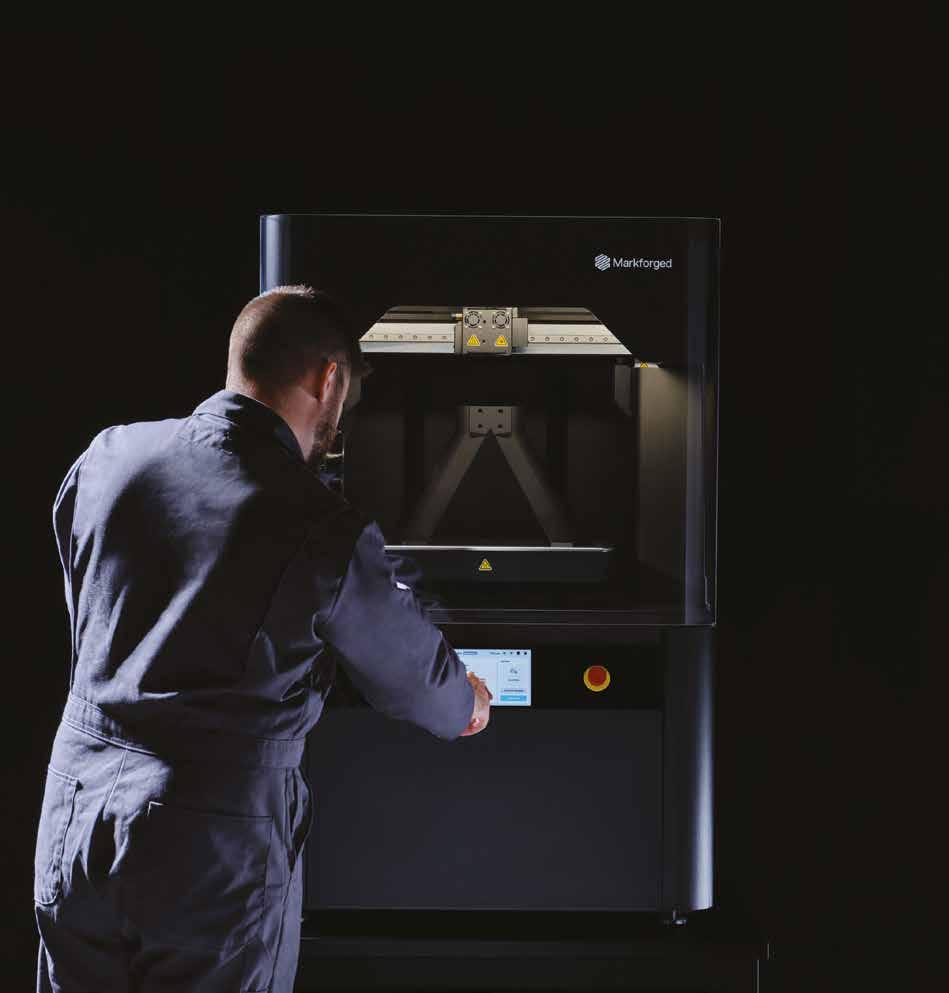
AUSTRALIAN MANUFACTURING WEEK
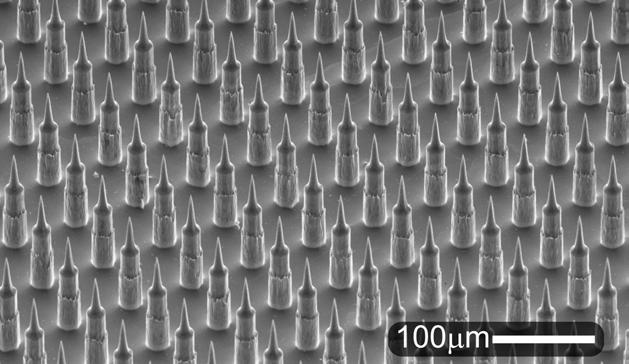
Dive into the detail to solve manufacturing problems
Understanding a problem at a microscopic level can often shed light on the bigger picture so Microscopy Australia can help solve manufacturers’ technical problems whether they’re related to R&D, quality control or failure analysis.
Microscopy Australia facilities
are based in universities around Australia, surrounded by a dynamic multi-disciplinary research ecosystem. This creates opportunities for industry-university research partnerships that take advantage of the academic knowledge and longer-term access to Microscopy
Australia’s instruments and expertise for product development.
A packaging company was having a problem on its production line with metal sheeting from one supplier behaving inconsistently during processing. Microscopic analysis demonstrated the grain structure of the metal was not at specification, which accounted for its inconsistent behaviour. This gave the company the ammunition it needed to go back to the supplier who admitted its shortcomings, which saved the customer significant time and money.

teamed up with the University of South Australia to develop a robust mirror for Ford. The technology has matured and is now appearing as decorative trim in cars across North America and Europe.
Microscopy Australia is also involved in enabling purely academic research projects, many of which are directly aimed at creating new materials and solutions for solving global problems. This pipeline of development provides a steady stream of new manufacturing business opportunities for industry.
One example is the green ceramic process developed at UNSW by Professor Veena Sahajwalla and her team. It uses glass and textile waste to make products for the built environment, such as kitchen benchtops, floor and wall tiles, splashbacks and tabletops. Independent commercial operators, including Kandui Technologies, have now established MICROfactoriesTM under licence to UNSW’s Sustainable Materials Research & Technology (SMaRT) Centre to produce the green ceramic products commercially.

Microscopy Australia’s expertise can also be applied to solving technical problems. This expertise goes hand-in-hand with its wide range of instruments to create a package of services to tackle anything from long-term R&D to quick turnaround fee-for-service jobs. It is on a mission to support emerging and established companies access the resources to address these problems.
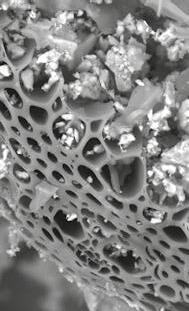

Imaging and analysis at the micro- and nano-scale can also be used to provide evidence of structure and functionality needed to promote a client’s products and, more importantly, attract investment. A number of clients have reported the evidence provided by Microscopy Australia’s analysis has been the decisive factor in attracting substantial new investment, gaining the required approvals for entering export markets or having critical
An example is an industry-university collaboration that led to the commercialisation of the world’s first OEM-supplied shatterproof plastic car mirror. SMR Automotive

Another example is green concrete developed at the University of Sydney’s Waste Transformation Research Hub, which incorporates fly ash and waste materials including ground glass and gaseous carbon dioxide. Developed by Professor Ali Abbas and his team, the technology has now been licensed to Circrete, a producer of environmental concrete.
The Microscopy Australia team aims to provide a bespoke imaging and analytical service to match industry needs and help solve a company’s unique problems, all at competitive rates.
Blickle is reinventing the wheel — and castors
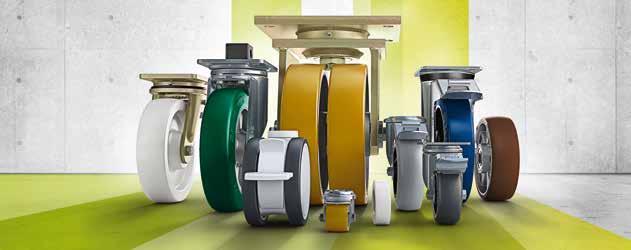
It’s more than 5,000 years old yet the wheel hasn’t advanced much: it’s round and it works well.
As Blickle Australia General Manager Matthias Dorsch says, the wheel’s functionality is indisputable. Yet he believes it can be made to perform much better by designing the wheel or castor that’s ideal for each application.
“As Mr Blickle once told me, our core competence is transferable
because the wheel hasn’t changed, which makes the wheels and castor industry different to most,” he says.
“We reinvent the wheel by applying our core competence by introducing new technologies to design, to materials and manufacture.”
Dorsch says the depth in Blickle’s fully German-manufactured range, plus its customisation and in-house R&D capacity gives the company an edge.
Blickle has been making
high-quality wheels and castors since 1953 in Rosenfeld and now exports to 120 countries. There’s over 30,000 wheel and castor solutions in its standard range, with load capacities from 25-50,000kg.
Blickle has a track record of developing customised solutions capable of handling up to 170 tonnes.
“The 30,000 products in our range represents only 40% of business. The other part is special designs for
applications that can’t be done with standard products. We service clients across almost all industries — often with very special requirements.”
“We customise products daily; there’s no limitation. It can be anything from a different combination of an existing wheel and frame or a completely new design of a wheel, frame, break or mounting solution.”
In 2024 Blickle will focus on its ErgoMove® series which offers electronically powered drive systems for castors that can be added to all kinds of equipment and transport units to reduce physical strain on operators.
Blickle has had an eventful few years. In 2023 it opened a new building and extended facilities in Germany. In 2022, Blickle Australia became the latest addition to the company’s 20 sales subsidiaries worldwide.
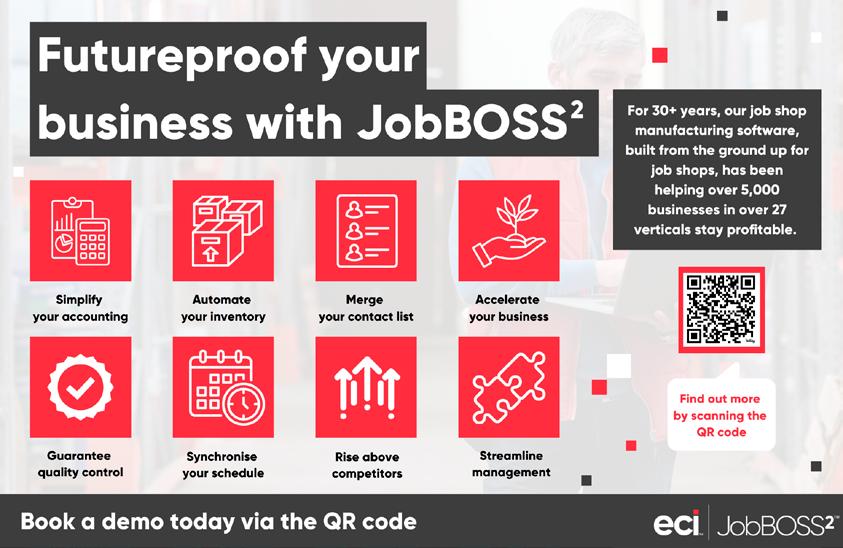

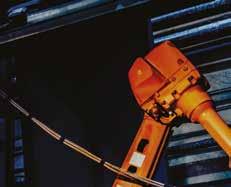


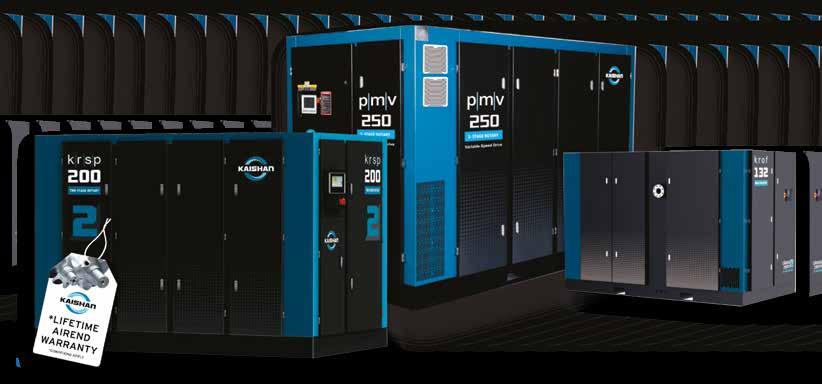


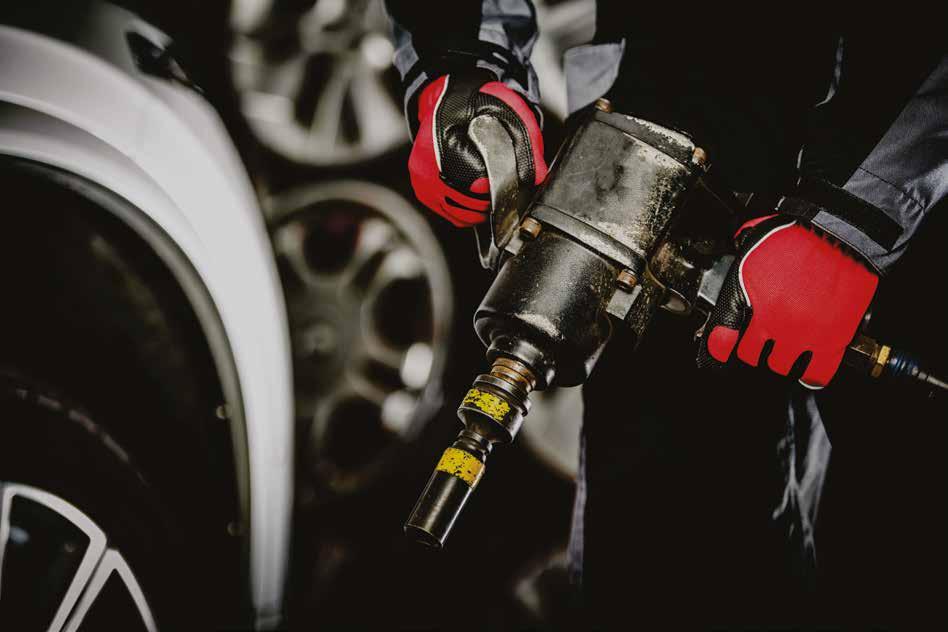
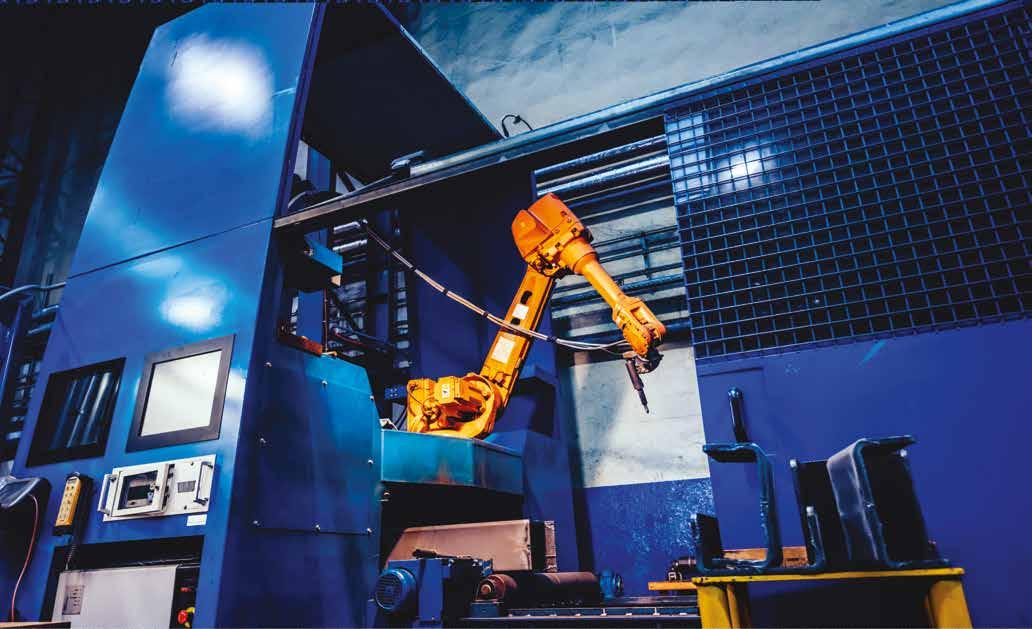









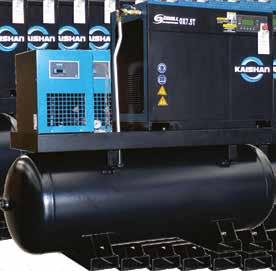


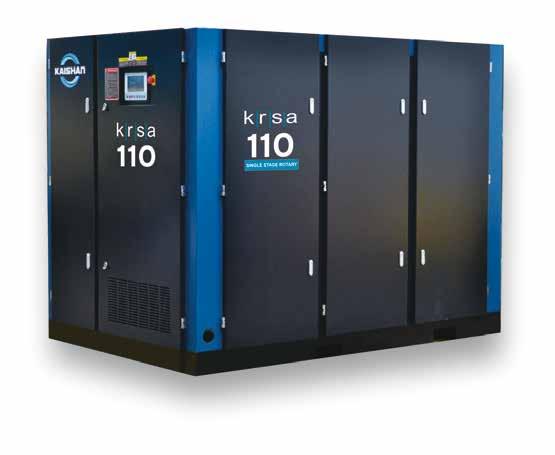
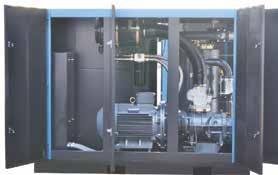

Low-pressure rotary screw compressors set new benchmark in performance and efficiency
Kaishan has launched KRSA, an advanced tech series of industrial, low-pressure rotary screw air compressors, which are fully packaged and can be plugged into any system or operate independently.
These compressor packages are equipped with Kaishan’s patented ‘SKYv’ airend, enabling them to perform in a wide range of applications, ranging from 25 psig to 45 psig.
The worldwide manufacturer of industrial air compressors has created the KRSA to maximise the compressor’s efficiency by delivering compressed air at different flow rates and pressures - even in the face of demand fluctuations - to meet the changing needs of the user’s application.
This design marks a new era in efficient and reliable low-pressure compressed air systems, providing businesses with a powerful and cost-effective solution to their compressed air needs.
Kaishan 3 bar, low pressure rotary screw air compressors are specifically designed for low pressure applications such as textile, cement, glass, flue gas, desulfurisation and pneumatic conveyance applications. The KRSA series boasts a versatile lineup, offering power capacities ranging from 22kW to 160kW. It
can also deliver pressure between 2bar and 5bar.g, all within a single, compact package.
With advanced variable discharge port technology, it offers a new level of efficiency and versatility, delivering the right amount of air pressure exactly when it’s needed. This ensures the compressor always operates at its most efficient point, minimising energy consumption and costs.
Compared to conventional blower solutions within this pressure range, the KRSA offers several unique benefits. In addition to its innovative SKYv airend, a robust premium bearing design and variable discharge port results in improved efficiency, consistent airflow, reduced noise levels, a smaller footprint and a lower total cost of ownership throughout its lifespan.
When a 7 bar standard air compressor is run for a 2-5 bar pressure requirement it uses far more power than a Kaishan KRSA low pressure unit. With its patented low compression ratio, the Kaishan KRSA series can achieve the same output flow (cfm) while using between 20-50% less power. The capacity of a rotary screw air compressor with a 132kW motor at 7 bar will be 24m3/min.
A Kaishan low pressure compressor with a 132kW motor at 3 bar

achieves a flow rate of 43m3/min. KRSA series up to 250kW are also available with Permanent Magnet Variable frequency (PMV) drive option for best in class part load efficiency,
KRSA Variable Speed Air Compressors provide maximum efficiency with consistent operation.
Unlike conventional ‘Auto-dual’ and ‘Load/No load’ control modes, KRSA VFD modulates the speed of the drive motor in response to system demand. This results in
greater energy saving compared to a fixed speed compressor. The VFD feature greatly reduces the starting power surge of the motor. A constant pressure delivery extends the life of valves. The power saving achieved enables recovery of investment in a relatively short operating time.
Combi-CS saves space and lives
The Australian food and beverage (F&B) industry has begun to realise the benefits of Combilift’s battery-powered, electric Combi-CS Pedestrian Stacker. The Combi-CS has been embraced for its combination of safety for both food and workers with productivity and quality.
And almost anyone can use it because it’s not classified as a forklift, so it does not require a licence.
Its patented, award-winning, multi-position tiller arm navigates very narrow aisles whilst managing loads of up to 2,000kg.
The tiller arm enables push-button rotation of the rear wheel which allows an operator to stand beside the truck — where there’s better visibility and is safest when picking and placing in narrow aisles.
Plus ease of manoeuvring speeds up the work and dispatching.
Features include:
• Power steering
• Electric, using AC motor technology
• Rear-wheel drive
• Patented multi-position tiller arm
• Load capacities from 1000-2000kg
• Lift height up to 2500mm
Combilift Country Manager Chris Littlewood says he’s proud to satisfy multiple customer concerns in one simple product.
“Once we recognised the industry’s need for a stacker that not only improved safety but was simple enough for any amateur operator, we knew it was our gap to fill,” he says.
“It also enables a business to cope easily with seasonal demand by employing extra operators for busy periods such as Easter or Christmas,” adds Littlewood, adding that there is a shortage of drivers including forklift drivers.
The compact design of Combilift’s pedestrian stacker range means that businesses can redesign their floorplans for greater capacity – the trade-off being that forklift drivers must work in increasingly narrow aisles. Of course, any difficulty is removed by the rotating tiller arm, making navigation and control a breeze even for beginners.
“The operator’s position allows a greater level of control over the

products when moving them around, with up to four-way reach in even the narrowest aisles,” says Littlewood.
“The forward visibility of the pedestrian reach vehicles greatly reduces the risk of incident in tight confines and ensures the vehicle is stress-free to operate.”

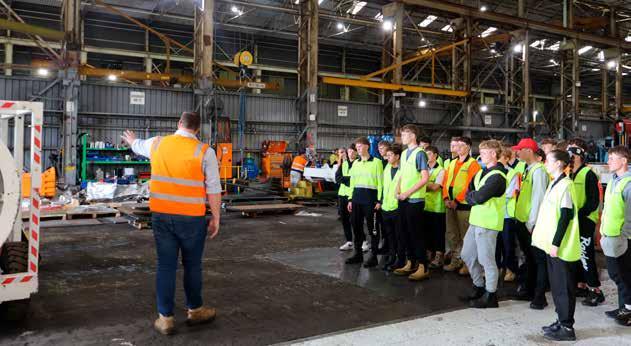
HunterNet: driving sustainable growth and innovation
In the early 1990s, the Hunter region of New South Wales faced a critical juncture in its economic history.
The decline of traditional industries like shipbuilding and the impending crisis in the steel sector prompted a wave of uncertainty among local businesses. Faced with the prospect of economic stagnation, a group of leaders came together to chart a new future course. Their solution: HunterNet—a cooperative venture aimed at fostering collaboration, driving innovation, and diversifying the local economy.
HunterNet has emerged as a beacon of hope in the midst of economic uncertainty. Its founding principles emphasised the power of collective action and the importance of leveraging shared resources for the greater good. With a mission to support businesses, build a skilled workforce, and ensure the region’s long-term success, the cooperative quickly gained traction among local businesses and industry leaders.
At the heart of HunterNet’s success lies its commitment to member engagement and collaboration.
In its 32 years, HunterNet has evolved into a dynamic force driving economic growth and innovation. Today, the cooperative represents more than 152 members with a combined annual turnover of $182 billion, encompassing diverse industries from manufacturing and mining to clean energy and medical science.
HunterNet’s strategic priorities reflect its commitment to driving
sustainable growth and innovation in key sectors to position the region as a hub for innovation and economic development.
Renewables and low-emission technologies, defence capability, transport infrastructure, training capabilities, value-added resources, enabling capabilities, and medical science are among the cooperative’s foci.
With its focus on commercial opportunities in wind turbines, batteries, solar panels, and hydrogen electrolysis, the cooperative is driving innovation in the clean energy sector while modernising traditional industries like steel and aluminum production.
Defence capability is another area of strategic importance for HunterNet. By maximising sourcing opportunities from Australian suppliers and employing Australian workers, the cooperative aims to strengthen the region’s defence industry while supporting local businesses. Initiatives such as the Hunter Defence Task Force attract key defence primes and small and medium-sized enterprises to the region.
Through a wide range of initiatives and programs, members are given opportunities to connect, collaborate, and grow. With a robust calendar of events, forums, and meetings, HunterNet Co-Operative members are kept informed and empowered to participate in the decision-making process. By fostering a culture of openness, collaboration, and innovation, HunterNet
with educational institutions and industry stakeholders, the cooperative is working to develop a flexible training framework that meets the needs of businesses and prepares workers for tomorrow.
In addition to its focus on talent development, HunterNet has forged strong partnerships with government agencies, academic institutions, and industry associations. These partnerships have been instrumental in driving innovation and fostering collaboration across sectors. For example, HunterNet’s collaboration with the University of Newcastle led to the creation of the Hunter Future Leaders Program—a seven-month leadership development training program designed to enhance business and leadership skills among young professionals in the region.
strengthens its position as a trusted advisor and advocate for businesses in the region.
One value-add for Co-Operative members is HunterNet Career Connections. Established in 1996 to assist businesses in sourcing, managing, and developing early-career talent, what began as a service for members has become a sought-after solution for organisations across the
Transport infrastructure is also a priority for HunterNet, with a focus on developing local manufacturing capabilities and supply chains. Projects like the Port of Newcastle Container Terminal offer opportunities for economic growth and job creation in the region. By supporting initiatives that enhance the region’s transport infrastructure, HunterNet is laying the foundation for continued prosperity and competitiveness in the global marketplace.
Value-added resources, enabling capabilities, and medical science are also in Hunternet’s focus. By expanding Australia’s mining science technology, developing key enabling
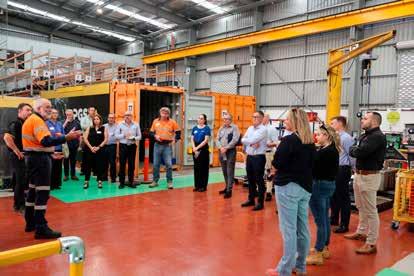
eastern seaboard, further enhancing HunterNet’s reputation as a leader in workforce development. Training capabilities are essential for ensuring the region’s long-term success. HunterNet is committed to providing clear pathways for degree, apprentice, and trainee programs that address current and future skills requirements. By partnering
capabilities, and investing in medical research and innovation, HunterNet is driving economic growth and diversification in the Hunter region.
By leveraging its network of industry partners, government agencies, and academic institutions, HunterNet will continue to play a central role in shaping the economic landscape of the Hunter region.

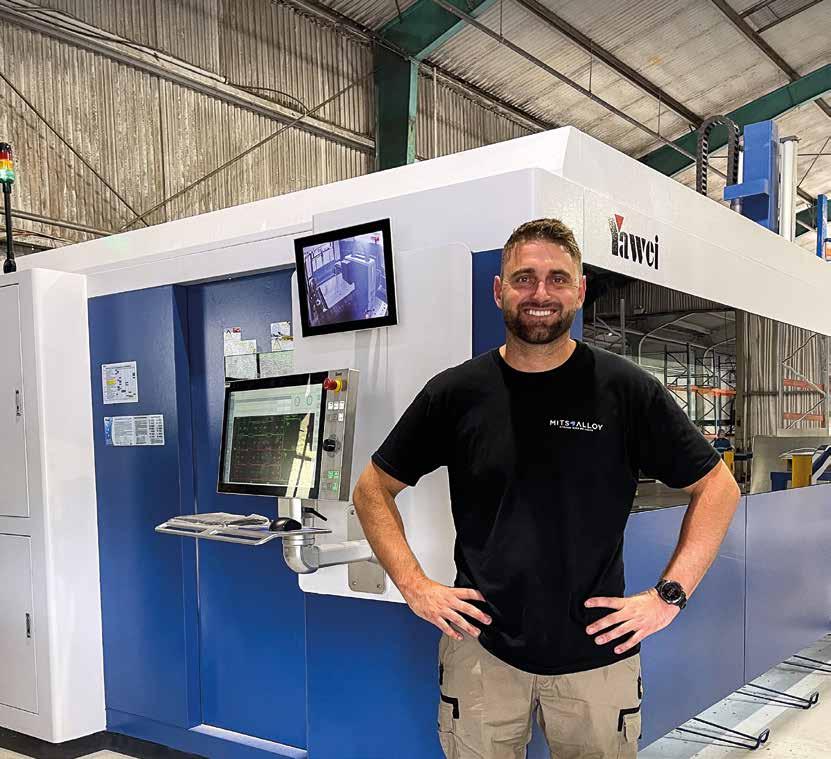
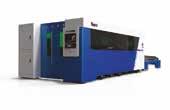
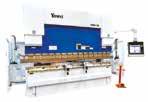


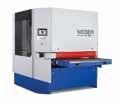
“ANY ISSUE IS FIXED STRAIGHT AWAY. THAT’S THE BENEFIT OF A LOCAL SUPPLIER WITH FULL TECHNICAL SUPPORT AND BACK-UP.”
STEVE MORRISS, CLOSE THE LOOP, SOMERTON, VIC
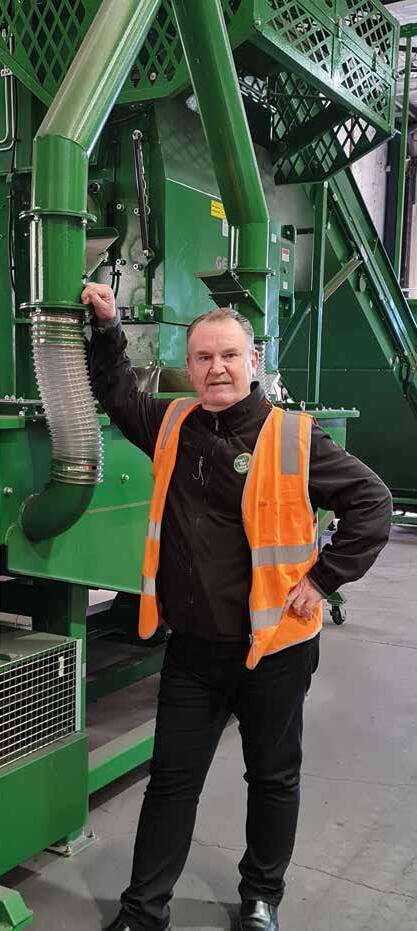

Electric excavator hits one million tonnes
Now at full speed, Fortescue’s new electric excavator has dug a million tonnes at Fortescue’s Chichester operations in the Pilbara, WA, and the mining company says it’s a massive milestone in its decarbonisation plan.
For the past three months, it had been running at partial capacity while the site team got to know the new piece of equipment. At times it has performed better than an equivalent diesel excavator.
“This is such an exciting milestone for Fortescue and our decarbonisation journey. Importantly, we’ve been able to achieve this while maintaining our high safety standards,” said Fortescue Metals CEO, Dino Otranto.
“We will have two additional electric excavators commissioned by the end of April. Once we decarbonise our entire fleet, around 95 million litres of diesel will be removed from our operations every year, or more than a quarter of a million tonnes of carbon dioxide equivalent.”
The excavator is operating partially on solar and is powered by a 6.6kV substation and more than two kilometres of high-voltage trailing cable.
In line with the miner’s commitment to eliminate emissions across its mining operations, the plan is for all electrified mining equipment to eventually be totally powered by renewable electricity.
The milestone comes just days after Fortescue’s 240-tonne battery electric haul truck prototype, Roadrunner, reached its own milestone during its onsite testing.
“Roadrunner recently completed its first phase of testing which exceeded the performance expectations of the battery power system. This included laps around our testing track and ramp tests with hill starts, all while carrying 231 tonnes of iron ore,” Mr Otranto said.
“It’s milestones such as these that are bridging the gap between zero emissions power systems and diesel fleets, and proving to the world that decarbonisation is possible.”
At Applied, our number one priority is ensuring that our customers across the country get the machinery they need, with the support they expect. With nearly 30 years’ experience, and thousands of satisfied customers across the country we’re here for the long term. We’re a true machinery partner – just ask Steve Morriss. Real Service. Real Support. Real People. That’s Applied Thinking.
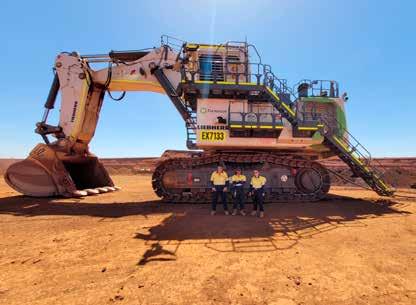
Manufacturing to quickly build NSW public schools
More sustainable schools, built in a shorter timeframe and at a fraction of the cost — that’s the premise behind a bold government plan.
Using cutting-edge construction techniques, including digital technologies, off-site manufacturing and on-site assembly of prefabricated elements, dozens of new and upgraded public schools and preschool facilities will be built across the state.
The Manufacturing for Schools program is expected to deliver cost savings of up to 20 percent and slash construction time by up to 30 percent.
At Oran Park Public School, a Stage 2 upgrade that opened for students to use on Day 1, Term 1, 2024, was installed on site in eight weeks. From design to completion, the project took 13 months.
The program is delivered by a manufacturing partner, who is responsible for connecting the supply chain to deliver the ‘kit of parts’ for new and upgraded schools across the state’s growth areas. The APP Group has been awarded the contract.
Growing school communities, such as North-Western and South-Western Sydney, will be given priority. The program plans to deliver more than 30 new and upgraded schools, including new primary schools at Sydney Olympic Park and Box Hill/The Gables, and high schools at Jordan Springs, Gregory Hills/Gledswood Hills, Schofields/Tallawong, Leppington and Medowie.
It is also being used to rebuild schools on the North Coast that were devastated by floods, and deliver the majority of 100 public preschools across NSW.
In addition to faster build times and reduced costs, the new program will minimise carbon emissions, material waste and water waste on sites in comparison with traditional construction methods.
Manufacturing in a controlled factory environment, combined with the shorter build times, also ensures less noise and overall disruption to student learning for projects on existing school sites.
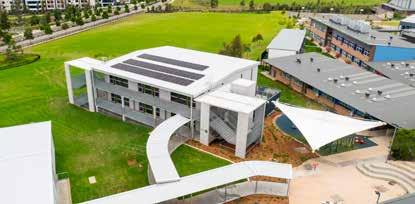
Deputy Premier and Minister for Education and Early Learning, Prue Car believes the Manufacturing for Schools program represents the future.
“It’s a major shift in our approach to designing, building, and delivering new schools and facilities for students and families in NSW,” she says.
“This is an economical, sustainable, and speedy solution that will deliver school facilities meeting the needs of our growing population, while getting better bang for taxpayers’ buck.
“In challenging times like natural
disasters, the program’s speed and efficiency will ensure a swift rebuilding process, allowing us to reinstate the schooling routine for affected students and families promptly.
“I am proud we are leading the way with industry partners to deliver a new era of school building through this innovative program.
“This future-focused strategy for sustainable and modern school building will ensure we can support teachers and students to achieve outstanding learning outcomes.”
An Altrac jib crane will


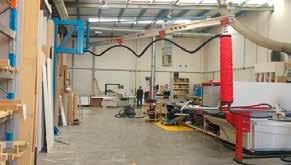








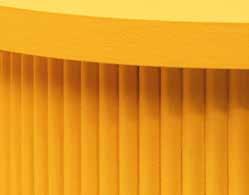



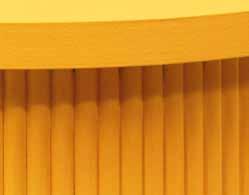






Registrations open for the Workplace Health & Safety Show
The Workplace Health & Safety Show is returning to the Melbourne Convention & Exhibition Centre, May 22-23.
The 2023 event was a success and this promises to be bigger and better.
The WHSS has a fresh look and feel. It was recently acquired by Australian events and exhibitions specialist, National Media, which has revamped the offering. It now consists of a highly pertinent education program and an exhibition – both of which can be accessed for
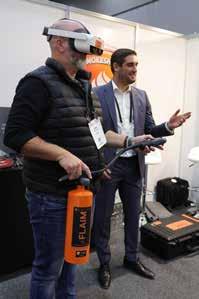
free via online registration.
National Media Commercial Director, Stephen Blackie believes the WHSS is a must for anyone interested in workplace safety.
“Our goal is to showcase Australia as a leading force in health and safety on an international level. With this in mind, our objective is to make the Show the preeminent safety event globally,” he said.
“Registration for the Show is free, making it a no-brainer for any professional who’s responsible for occupational health and safety, or workforce wellbeing.”
The Show aims to help Australian businesses navigate the complex legal requirements and new tech offerings available. It boasts a strong line-up of speakers to unpack the latest regulations, technological advances, psychosocial programs and more.
Key speakers on the Melbourne Show agenda include Simon Brown-Greaves (Chief Mental health Officer, Australia Post); the Victorian Chamber of Commerce & Industry CEO, Paul Guerra and Acting General Manager: Workplace Relations and Wellbeing, Lisa Davidson; and Carli Phillips (CEO, Corporate Wellbeing Hub); as well as Laura Sowden and Anna Ly (Mills Oakley Lawyers).
legislation expected to be introduced in July, industry stakeholders must be better equipped to navigate and adapt to the new guidelines.”
At the Spotlight Stage, professionals will showcase the vast array of health and safety products and services available to the local market.
In addition, the Knowledge
“Registration … is free, making it a no-brainer for any professional responsible for OH&S”
Centre will feature a line-up of interactive seminars covering a range of topics such as injury prevention and the measurement of safety performance, safety technology, worker wellbeing, psychosocial hazards and more.
Over 130 exhibitors will also showcase the latest technology innovations and products, giving visitors a glimpse of what’s new in Work Health and Safety solutions.
Blackie believes these experts exemplify the strength of the Show’s offering.
“That we have attracted speakers of such high calibre and experience is a testament to the quality and value of the Show,” he said.
Getting across the latest regulations, innovations and best practices
Melbourne WHSS attendees will gain the tools, knowledge, best practices, technology and equipment they need to create a healthy and safe workplace.
The revamped Show features three theatre conference stages, including a new, content-packed Summit Stage, offering a variety of engaging sessions. These include half-day summits on Worker Wellbeing and Health and Safety in Construction.
“Staying up to date with the requirements of the psychosocial laws, and understanding how to support employees, are key concerns for our audiences. We are also focused on helping construction companies - which typically grapple with a high number of accidents and injuries - better understand the risks they face in order to improve their safety and compliance,” Blackie said.
“In the face of constant changes, such as the new industrial manslaughter
Connect with industry thought leaders
“In addition to this comprehensive education program and exhibition, the Show will offer visitors the opportunity to network with leading industry professionals, colleagues and peers. A central lounge will be available, for those who need to take a break or catch up on calls or emails,” Blackie said.
The Melbourne WHSS runs alongside the annual AIHS National Health and Safety Conference. Show partners and sponsors include the Victoria Chamber of Commerce and Industry, WorkSafe Victoria, SkyTrust and the Working at Height Association (WAHA) – all coming together for this must-attend OHS event.
The Show will also be held in Sydney from October 23-24, giving safety professionals another opportunity to be part of this exciting event.
“Register today for your free ticket and be part of the movement towards healthier, safer workspaces,” Blackie said.
The Show agenda, speaker information and registration details are available at https://whsshow.com.au/.
Workplace Health & Safety Show whsshow.com.au
World’s first exclusion zone for mobile plant
In a world where safety is paramount, Incident Zero has pioneered a groundbreaking innovation, setting a new precedent for workplace safety. The ethos is simple: a safe return home for every worker, every single day. And with the advent of the Safety Halo™, that vision takes an unprecedented leap forward.
At the heart of this evolution lies an unexpected collaboration—a synergy between an Australian truck driver and a luminary laser engineer from the United States. What began as a chance encounter after a speculative email blossomed into an extraordinary partnership, driven by a shared passion for safety innovation.
The Safety Halo, a testament to this partnership, employs a revolutionary concept: harnessing low-powered red laser light to delineate a distinct exclusion zone around mobile machinery. Developed over a rigorous seven-year research and development phase, this system redefines
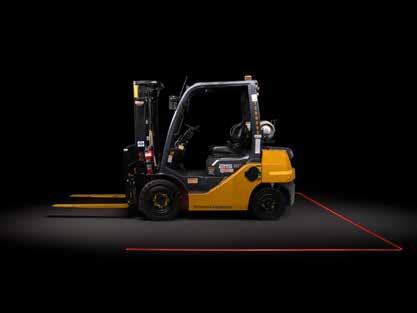
safety standards within mining environments.
Behind its brilliance lies a profound understanding of human-eye
biophysics, intricate laser engineering, and an unwavering commitment to meeting global safety standards. The result? A laser system that
defies convention—resilient, bright, long-reaching, and impervious to the harshest rigours of mining sites while maintaining an impeccable safety classification.
What sets the Safety Halo apart isn’t just its technological finesse; it’s the intuitive design that speaks a universal language to all.
The stark red zone signals danger in a way that transcends language barriers or educational levels. It triggers an innate response, compelling individuals to instinctively steer clear of potential hazards, making it arguably the most effective mobile plant exclusion zone system availble today.
Unlike conventional systems reliant on driver input, the Safety Halo stands as an autonomous guardian, a beacon of safety ensuring that the riskiest human-machine interactions become a thing of the past.
Incident Zero incident-zero.com
WORLD’S FIRST EXCLUSION ZONE FOR MOBILE PLANT.
Because everyone deserves to go home safely.
Safety Halo™ by Incident Zero is the world’s first exclusion zone for mobile plant that leverages neuroscience to positively affect human behaviour and induce safety.
Projecting large distances, and built to withstand the rigours of heavy machinery, the Safety Halo is the most effective exclusion zone system for mobile plant in the manufacturing industry. Scan the QR code to see the Safety Halo in action.


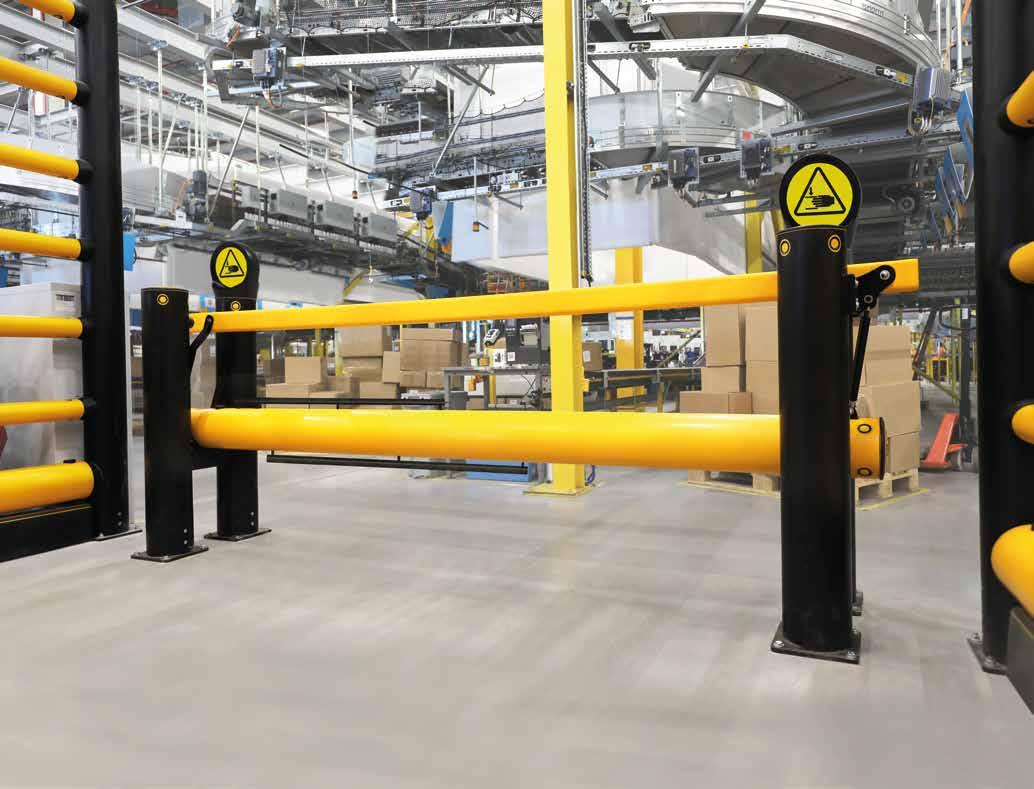
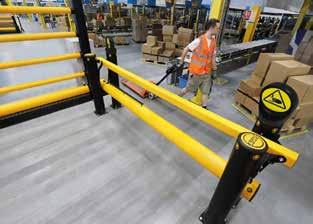
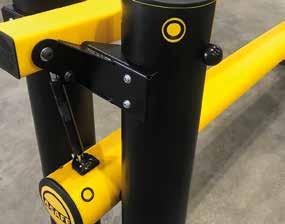
TRAFFIC GATE COMING SOON
PROTECTION THAT KEEPS YOUR BUSINESS RUNNING SMOOTHLY



Protects dock doors from impact damage

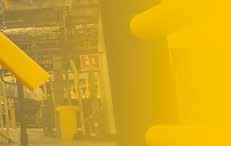
We understand that keeping your loading docks, access points and doorways in working order is vital to your company’s success. Loading bay closures result in your operation slowing down, the quantity of dispatched orders are reduced and your operational reputation is at risk. That is why we have engineered the Tra ic Gate to provide high quality protection to these areas, reducing the need keeping your business running smoothly.


Prevents vehicles from encroaching pit areas
Simple to operate with gas-assisted lift
Rigorously tested to industry standards
asafe.com
Email : sales@asafeau.com
Tel : +61 (0)2962 58927

Mark Collins had breast cancer, he wants more men to be aware it could happen to them
Breast cancer is seen as a woman’s disease, which is why it’s a shock when a man is diagnosed with it.
A-Safe Director Mark Collins was one of them.
According to the Breast Cancer Research Foundation, one in 833 men will develop breast cancer. While it accounts for less than 1% of all breast cancer diagnoses, its rareness makes it difficult to detect.
Common symptoms include a lump, thickening in breast tissue, changes to skin such as dimpling, puckering or redness and nipple changes including redness, scaling, inversion or discharge.
Collins noticed an inverted nipple, but thought it had been bumped while playing soccer. It wasn’t until he went to the GP for another matter that he mentioned it.
The 55-year-old was diagnosed last April, a few days before his birthday.
“The doctor actually said, ‘Look, I don’t think it’s anything to worry about’ but he sent me for an ultrasound. The results found there was blood supply to the lump and then I
went on to have a mammogram and a biopsy,” Collins said.
“The results came back positive and it had hotspots in there. So even though it was only a little lump it was quite aggressive. So that was on the Saturday, I got a phone call Sunday morning from the breast surgeon.”
Treatment
Things moved quickly for Collins. He was booked in for a mastectomy two weeks later, he delayed it a week for his daughter’s 21st birthday, and followed that up with chemotherapy.
The surgery confirmed the hotspots in the lump and although his lymph nodes were clear, there was a 5% chance the cancer had spread to his bloodstream so he had chemo.
Collins’s cancer was only stage one and hadn’t spread to the lymph nodes, so chemotherapy was optional.
“It was just precautionary. I didn’t have to have it, but you got to,” he said.
He had four rounds of chemo, three weeks apart.
Collins was grateful everything happened quickly.
“You haven’t got time to ponder, that would be the worst,” he said.
“It’s a roller coaster ride but I’ll tell you what, it’s what I prefer to be on. Everything happened bang-bang-bang.”
Going through chemotherapy
While he had the usual symptoms, such as hair loss and loss of appetite, he still worked throughout his treatment.
He’d have chemo on Thursday, was given steroids to counteract its effects so he was good until Friday, then he’d crash.
“It just feels like you’re full of energy and everything’s good, then Saturday you just go downhill but it’s enough that gets you through that little initial hit,” he said.
“So we’d go in on Thursday morning, at lunchtime. I would come home and work. I’d work Friday and then go to bed Friday night and wake up Monday morning.
“I’d never been so tired in my life. My wife would come up and poke me because she thought I was
dead, she’d never seen me sleep so much. Then I had Sunday like that and it was kind of good on Monday. By Tuesday you can’t sleep because your body’s slept that much.
“One life is all it’s gotta save…I’m hoping some good will come out of it.”
“But I was going good because I went back to work Monday, worked the week and played soccer on Saturday. I was a bit tired Sunday.”
He chose to work because he needed a reason to get up in the morning.
“I enjoy work at the moment. It’s killing me but I’m enjoying it,” he said.
“What are you gonna do? Just watch TV? I can’t do that. In 10 years time I’ll be able to watch TV when I’m retired but not now.
“You’ve gotta have a reason to get up and do something, you’ve gotta keep going. If not, what’s the point?”
On the Wednesday before each chemo session, he’d meet with his oncologist, Dr John Park.
“You go and have blood tests to make sure your levels are back up and he would ask how I coped. I think I got off pretty lightly,” he said.
“I’d go in to see him with my wife and he’d say, ‘How did you go at soccer?’ and she’d go, ‘Aren’t we talking cancer’ and he’d say, ‘No we talk soccer first’ because he was playing soccer as well. I was the only patient he knew that played soccer between treatments.
“In the doctor’s surgery it was all ladies, I was sitting there and they probably thought I was such a good, supportive husband. When the doctor walked out and called my name they all looked up, because you wouldn’t expect a guy’s name to be called out.”
Collins didn’t have a problem moving around, but he lost his appetite because the medication made everything taste metallic.
“I just worked normally. I just didn’t eat. I would come home, dinner would be sitting there and I’d just push it away and I was just having soup was soup for lunch and that was it,” he said.
“I’d had a beer after soccer and it would sit there in my chest, for what felt like days so I didn’t drink. Even water tasted funny, somebody told me to add cordial and that took the metallic taste away.”
The after effects of breast cancer
Collins’s cancer was estrogen positive, which means he now takes an estrogen suppression drug called Tamoxifen to prevent a recurrence. In women, it creates a medically-induced menopause. Luckily for Collins, his symptoms are less severe.
“They said I could get hot flushes, I could become more emotional and a whole list of things but the only thing that’s changed is my skin feels soapy,” he said.
“It feels different, like you’ve got a layer of soap on after a shower.”
What surprised Collins is that the fatigue from chemo is still going a year on.
“I can have days where I can just be flat. It passes the next day or the day after. Sometimes I can be sitting there on a Saturday and have to go down for an afternoon snooze,” he said.
“My body’s still trying to get over it.”
There is no history of breast cancer in Collins’ family. But the 55 year old is waiting on results of genetic testing to see if he carries the BRCA gene, which increases the
Surviving and thriving after male breast cancer. Mark
Collins Director - A-Safe Australia
risk of breast cancer.
“If I’m a carrier, I can get my kids Pat and Sarah checked to see if they’ve got the gene. And my brothers too, because Mum and Dad didn’t die from breast cancer,” he said.
“If I haven’t got the BRCA gene, this is just bad luck.”
Sharing his story to raise awareness of male breast cancer
Collins is remarkably matter-of-fact about what he went through.
“My wife actually took it harder than me, she said it should have been her because she’s female,” he said.
“It is what it is, I just said let’s go and get it cut out and get on with it.”
“My kids were sad. It still rattles my daughter, she wants to know why it happened. Especially when you live a
half-decent lifestyle, you think what did you do wrong? But it is what it is, you can’t do anything about it.”
The mastectomy means Collins has a scar across his right chest, but he isn’t bothered about the lost nipple because the hair has grown back.
“It was just a bit of meat. If it was a testicle or something I’d probably be more emotional than that. But they just had to cut something out, that’s the way I looked at it,” he said.
Collins’s diagnoses is so rare that when he went to get a new Tamoxifen prescription, the GP wanted to discuss it with him,
“She gave me a strange look and asked me why I was on it. She looked at my file and wanted to ask me some questions, because she’d never met a male with breast cancer,” he said.
He is sharing his story because he
wants other men to be aware that it could also happen to them.
“There’d be a lot of men that read this magazine,” he said.
“I told the guys from soccer as soon as I was diagnosed and they said, ‘Oh, we don’t even check.’ They were thankful I told them what happened.
“One life is all it’s gotta save. If you woke up and your nipple was inverted you wouldn’t think anything of it, but now you know to check it out.
“I’m hoping some good will come out of it.”
Lessons From the Postman: How Employers Can Adjust for Better Mental Health
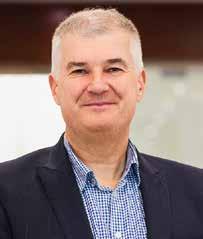
Depression and anxiety are significant health risks among Australian adults. The Australian Institute of Health reports that 12% of the population has experienced psychological distress, and one in five Australians already suffers from a mental health condition. The Australian Bureau of Statistics
reports that over 17% of Australians suffered an anxiety-related disorder between 2022 and 2023.
This has serious implications in the workplace, especially with the introduction of new regulations that seek to protect the mental wellbeing of employees.
As Simon Brown-Greaves, Chief Mental Health Officer, Australia Post (and a presenter at the upcoming Workplace Health and Safety Show) says: “We are now operating in a social context where the mental health landscape is far more complex. The endless pursuit of better returns along with many of the Post Covid workplace changes is impacting mental health in our community and employers need to adjust”.
Three key actions for enhanced management of worker wellbeing
In addressing mental health, Simon outlines three key steps that organisations should take:
1.Develop a culture and a strategy that support good mental health
Make sure the strategy is fit for purpose, and facilitates partnership at all levels of leadership. “Company-wide, mental health needs to be embedded in routine practices across the business and should be the responsibility of company leadership and team members alike,” notes Simon.
Companies of any size can implement an effective strategy, almost for free – there are sufficient resources in the community which can be accessed to pull together a program that is specific and relevant to a work environment and scale. “It’s about looking at things like effective job design, effective collaboration, leadership and workload management,” adds Simon.
For Australia Post, with a 60, 000-strong workforce, it was important to develop a strategy that would be relevant to its diverse team (which includes first language
speakers, varied cultural and ethnic groups, as well as differently abled team members). Instrumental to the company’s vision for mental wellbeing was the appointment of a Mental Health Officer in the extended executive team. Simon is the inaugural appointee – responsible for fine tuning mental health strategy and managing its execution.
In creating a caring and supportive company culture, Australia Post has fostered a sense of connection and job pride, with positive outcomes. “The longevity of employee tenure is extraordinary – I met a postie in country Victoria, who has been on the same round for 50 years and he loves the job. He is an intrinsic part of the make-up of that community and this gives him an enormous sense of purpose and satisfaction,” says Simon.
2. Be clear on who’s responsible for mental health
Organisations should differentiate

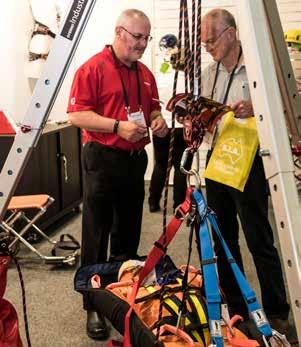
between what responsibility they hold in terms of supporting worker mental health, and what is the responsibility of team members themselves. “There is a subtle, but important difference between what we own, and what we support for,” says Simon. The focus should be on identifying
how to reduce the negative impact of specific actions or activities within the workplace that are the responsibility of the employer.
“For example, we need to keep our posties safe from dogs Not doing this would mean additional anxiety and risk for the employee”.
He cautions against wellbeing initiatives that inadvertently place an added burden on the employer.
“A lot of time and money is spent on activities that are not the responsibility of an organisation, such as subsidised gym memberships or yoga classes,” he says. “These don’t give the organisation the best value as the activities don’t appeal to the broad population, and put the company in charge of organising the recreational activities of employees.
We’re not in the pursuit of happiness – it’s about developing strategies that are sustainable and scalable,” says Simon.
3. Empower teams with effective mental health leadership and support resources
Leadership development shouldn’t be solely focused on managing the mental health of staff, but rather on effective communication skills, to facilitate regular wellbeing checks so leaders can proactively identify the signals of possible mental health issues and know who these issues should be referred to. “Supervisors need to be mindful of the mental health of the team but should know what the mechanisms are to support them in helping their team,” adds Simon.
Employee assistance programs (EAPs) are one means to provide mental health support to personnel when needed. “The Australia Post EAP has eight streams of support - from financial advisory support, family violence, special support for Aboriginal Torres Strait Islanders (more than 1,000 of our employees identify as ATSI), and we also have a manager coaching/assistance
program where managers can get support in working with their staff,” explains Simon.
Helping you get started
Simon will be sharing his insights at the upcoming Workplace Health and Safety Show, taking place in Melbourne from 22 to 23 May 2024. His Summit Stage seminar, entitled Workplace Wellbeing: A Strategic Imperative for Businesses Success, will be around designing and delivering a mental health strategy in the workplace. “This is a recipe of the key considerations to take into account if you are serious about putting together a strategy,” concludes Simon.
The Workplace Health & Safety Melbourne Show runs alongside the AIHS National Health and Safety Conference 2024, at the Melbourne Convention & Exhibition Centre from 22 – 23 May 2024. Registration is free, at whsshow.com.au/register-melbourne. Register




SENSORS & ELECTRONICS
Magnetic field condition monitoring

Magnetic field sensors have been around for a long time. They have mostly been simple devices with single axis sensing and basic digital outputs. Turck’s new Condition Monitoring Magnetic Temperature (CMMT) is a cut above.
Traditionally, the most common applications for this technology have been detecting embedded magnets inside air cylinders in positioning applications, known as cylinder sensors. They also detect a permanent magnet and enable much greater sensing distances than inductive proximity switches can achieve, known as magnetic proximity switches. They’re also used as embedded sensors to detect vehicles in parking and other traffic
applications.
Turck’s CMMT offers a much more versatile suite of applications for magnetic field and/or temperature measurement.
It is an IO-Link device that measures magnetic fields over three axes and, when combined with Turck’s Turck Automation Suite (TAS) software or the webserver 2 included with Turck IO-Link masters, it provides clear and intuitive visualisation of the magnetic fields in an application. This provides visibility of any changing parameters, which can be used to generate alerts to advise that maintenance is needed before any failures occur.
The CMMT can detect moving metal through stationary metal. For example, where there is an auger
moving product, it can be used at the far end from the drive to detect lack of internal movement which indicates the auger could be jammed or broken. Another similar application is detecting the presence of metal ‘pigs’ inside metal pipes during pipeline maintenance and cleaning processes.
In warehousing applications, magnetic field sensors are regularly used to detect magnetic items inside packages to prevent jam ups created by magnets in parcels sticking to conveyor side rails or walls. The CMMT can be used to reject items with high magnetism and allow par cels with low levels of magnetism that do not cause issues to continue, reducing the volume of rejected parcels which need to be processed manually.
During certain manufac turing processes some metal components will be magnetised. This needs to be reversed afterwards for the end product to work correctly. The CMMT can measure what the level of residual magnetism is and this can be used to divert items where residual mag netism is above a minimum set level so they can be corrected. Many metal handling and
lifting systems use permanent magnets or electro-magnets to ensure the processes are accurate and safe. The CMMT can be used to confirm the correct magnetic force is still available to ensure correct operation. This application can also be scaled down to detect the level of magnetism in individual magnetised tools in CNC machines and similar machinery.
The CMMT can also be used to detect the presence of large metal objects, such as vehicles in parking, access gates or traffic control applications.
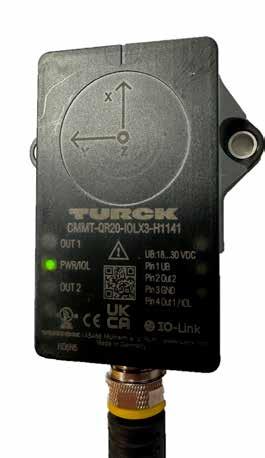

Magnetism is easily ‘conducted’ through metal, so the CMMT can be used at the end of a metal part to detect the presence (and polarity if desired) of a magnet inside a severely aggressive or hazardous environment at the other end of the metal
Measuring between 10 µT and µT the CMMT comes in an IP68 housing and is suitable for ambient of -25°C to +70°C. It can be configured using IO-Link and then used with two transistor outputs or, for full functionality, used as a part of an IO-Link
The CMMT is the only industrial three axis magnetic field sensor available with an IO-Link interface, making it the ideal solution in applications where you need to know individual axis measurements (and possibly tie them to individual output signals.) It allows for changes to parameters during operation, offers access to diagnostics such as operating hours, allows you to measure the field value(s) and is ideal for when a robust, industrial quality device for detecting magnetic fields is required.
For more information, talk to your Turck expert.
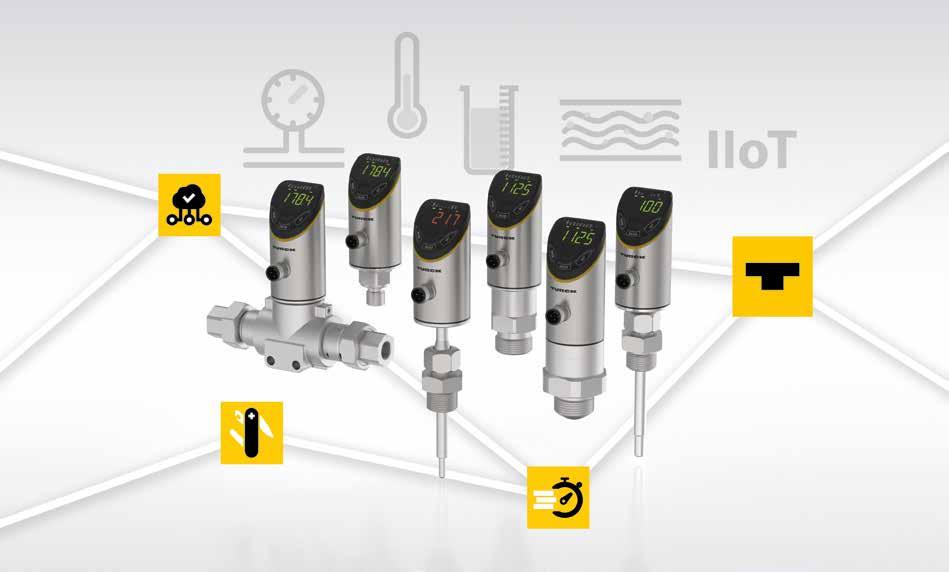
Fluid sensors with added value GENERATION
Flexible installation, intuitive operation, maximum robustness and a uniform look & feel - this is what Turck‘s innovative Fluid+ platform offers. The IO-Link-capable sensors combine functionality, convenience and usabilityfor the simple detection of pressure, temperature, flow or level.

Mouser Electronics takes new technology to market

There’s something to be said for doing things your way and ignoring the herd.
While most distributors want to be in the high volume market, Mouser Electronics is looking elsewhere. Founded in 1964, the company is an authorised distributor of semiconductors and electronic components for over 1,200 industry-leading manufacturer brands.
Senior Vice President of Global Service & EMEA and APAC Business, Mark Burr-Lonnon said Mouser is focussing on design and High Mix, low to medium volume production rather than supply chain
to the volume market.
“In the old days, we’d have been called a catalogue company. The world is changing, we no longer have a catalogue so where we fit is primarily for engineering small quantity, small to medium sized production and it’s a great space to be in ,” he said.
“We sort of play everywhere, apart from high volume which, interestingly, is where everybody else wants to play. So we’re kind of unique in that the one area everyone else wants to be in is the one that we don’t.
“For us, our focus has always been on design, engineering and taking new technology to market. And once it gets into high volume, you’re really just talking about supply chain. We can do supply chain, but for us, our focus is ensuring we have the widest portfolio of product not the deepest so our strengths are very different from our competition although naturally we get involved in volume on some parts where it makes sense.
Burr-Lonnon said the area in which Mouser thrives is in the low to medium volume, high mix category - lots of boards with lots of technology on it and this is essentially the Australian Electronics Industry make up.
“Part of the reason is that lots of people have chosen not to thrive there, they’ve just gone chasing the dollars and the supply chain and the
“We’re building a new warehouse, it’s just about finished, which will double our capacity. We have over $2 billion USD of inventory sitting on the shelf and we have around 850,000 customers worldwide,” he said.
Mouser has one global warehouse, situated in Texas, USA.
“We ship small to medium sized quantities. The best way to describe it is that most of our product goes out in a pizza box, that sort of size, whether it’s a normal sized pizza box or double, treble in terms of height, so shipping around the world is easy and fast ,” he said.
“Now, if you’re doing high volume, you can’t do that. You need to be a lot closer to the customer because you’re shipping pallets.”
Burr-Lonnon believes the timing of the new warehouse , 1 million square ft and more than doubling our current capacity is fortuitous.
“That should come on stream mid year, which is good because I think the market’s going to change in quarters three and four,” he said.
high numbers,” he said.
Mouser has 28 offices around the globe and just opened its first in Australia.
“We’ve been shipping to Australia for a number of years, so Australia is not new to us but our local focus for sure is a huge change,” BurrLonnon said.
“I think you’re going to find more semiconductors, moving back to longer lead times and potentially allocation on some parts . I’m not quite sure whether this is an inflection point or not, but we’ve just seen all the lead times for connectors, passives and semiconductors start to go up again.
“As we move back into longer lead times, we move back into shortages. All we can do is buffer that with inventory.”
Burr-Lonnon said Mouser has just over 20,000 customers in Australia and believes there’s room for growth.
“We grew globally with regards to having a good internet presence, but everybody always wants to make sure they have local people talking to local people. Sometimes it’s language, of course, but mostly it’s to make sure that from a customer support standpoint, it’s always nice to talk to someone who’s local. I mean, you can talk about the footy. Or cricket, I remember speaking to someone in the US about cricket and he thought I’d gone crazy.”
“Australia has been on the map for ages for us to do something and we are very glad to open this office in Melbourne. “
“Our focus is ensuring we have the widest portfolio of product not the deepest.” Mouser
Burr-Lonnon believes that one of Mouser’s strengths is its inventory.
“We’ve been here for a while. I mean, we’ve already done over $40 million of business, so we’re not an unknown entity in Australia,” he said.
“We believe that when you have local people doing local things in the market, it just all comes together because we also start to talk more to the local suppliers to make sure we have the right profile and inventory for the Australian market.
“We need to work out whether we have the right parts in the portfolio for Australia, because we’re shipping it all out of the US. If we get the portfolio based on talking to people in the US, we may miss out on the parts in Australia, so we start to have more supplier discussions with people in the local market, which always helps.”
The key to unrestricted access
Explore millions of components for your next design
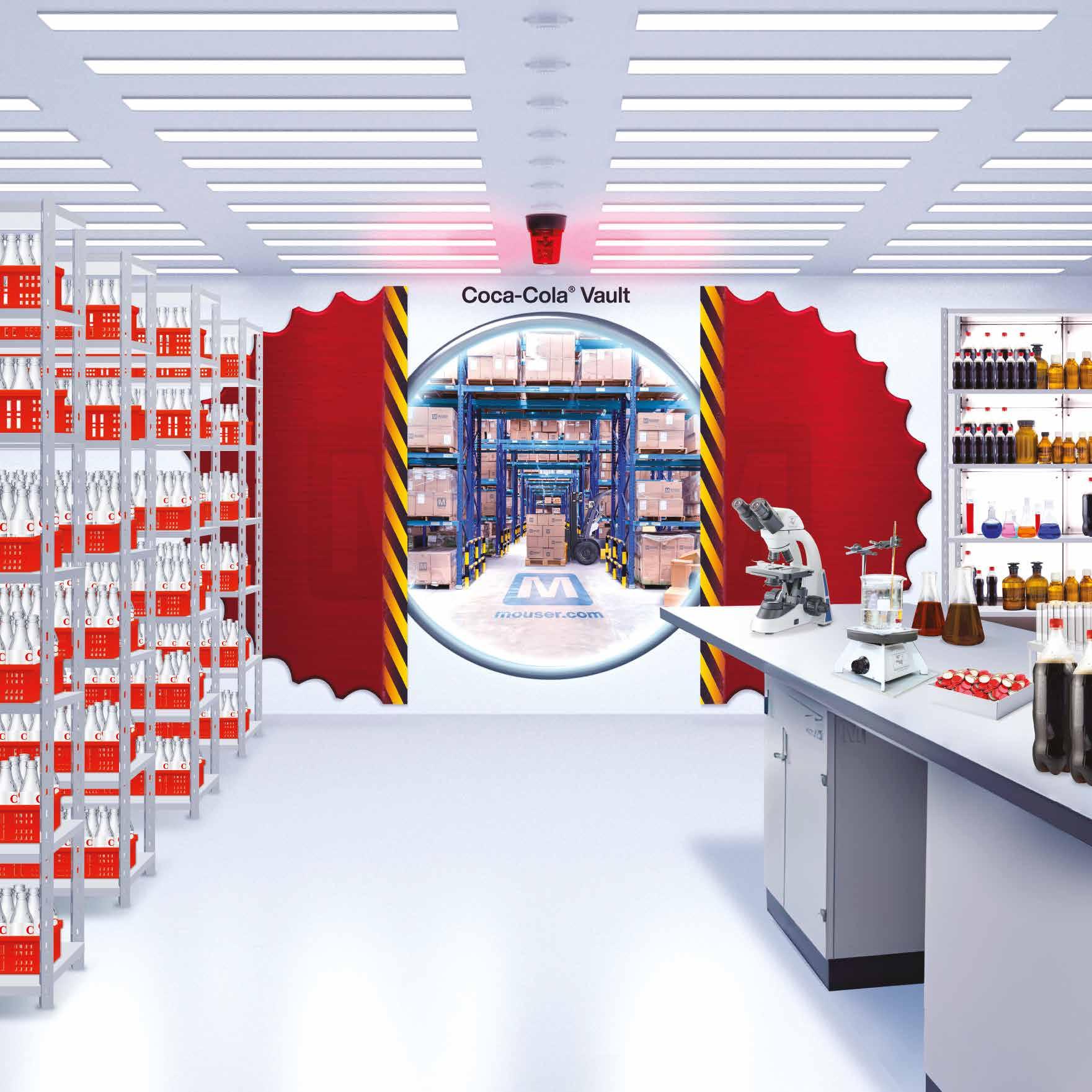
Although the Coca-Cola® secret formula remains locked safe behind vault doors, we can give you access to millions of electronic components, from well over a thousand leading brands engineers know and trust – your secret ingredient for engineering success.
mouser.com


Tech ‘Matters’: the new standard in smart homes
By Josh Mickolio, Supplier Business Development Manager, wireless and IoT, DigiKey
Josh Mickolio, Supplier Business Development Manager, wireless and IoT, DigiKey
The cloud of confusion around smart home development was greatly reduced with the introduction of Matter, a new technology standard introduced by
the Connectivity Standards Alliance (CSA). Those that have shopped for devices to make their home a little smarter, would appreciate the impact Matter is having on the smart home industry.
Everyone has a preferred smart home ecosystem, whether it’s from Apple, Amazon, Google, Samsung or others. A variety of choices is usually a great thing, except for employees for a company developing for, and maintaining, all those options. Matter now allows these companies to design one product, i.e. a wireless light bulb that will now be compatible with all the popular smart home platforms.
Searching for Matter keywords online is hit and miss. A search on popular search engines for ‘Matter starter kit’ returned results for role-playing games. So DigiKey thought it would be useful to put together a brief introduction to
Matter-compatible devices and development kits.
Matter is an open-source standard managed by the CSA, and as with most standards organisations, like the Wi-Fi Alliance, Bluetooth SIG and others, the CSA does a great job highlighting devices that are certified for use with Matter. The CSA website has a host of resources, FAQs, documentation and more at https://csa-iot.org/ all-solutions/matter/.
The CSA also has a certified products search on its website, https:// csa-iot.org/csa-iot_products/. This page allows a user to search for end products and compliant platforms.
In addition, the ‘Program Type’ filter on the left of the certified products search page lists all of the technologies supported by the CSA, one of which is Matter. A few Matter-compliant suppliers and products are listed below.
Australia has seen a consistent interest in Matter-compatible products from companies like Texas Instruments, Microchip, STMicro and others, reflecting the desire of local engineers and designers to build and create using certified Matter products.
“When Matter was developed, three key factors were reliability, security and seamless integration.”
Another extremely useful reference is the Project CHIP (Matter) github, https://github.com/project-chip/connectedhomeip. There are a lot of examples here for when it comes to coding.
When developing a Mattercompliant project, a lot of things remain the same including needing the coding for connectivity and sensors. Where this will vary is that users now need to include Matter as well. Using one of the many examples referenced above is a timesaver. There are a multitude of different language examples available including, but not limited to, C++, Java, and Python, making this a great option for any developer.
“The goal of the Matter technology standard is to unify and simplify smart home devices.”
When Matter was developed, three key factors were reliability, security and seamless integration. These factors continually improve as new versions are released. Some of the key security factors include device-unique joining authentication, secure over-the-air updates and network-wide privacy and integrity. By using the resources listed above, a developer can ensure these security measures, and many more, are incorporated into their project. To see more on security in Matter, please visit https://csa-iot. org/resources/security/.
The goal of the Matter technology standard is to unify and simplify smart home devices. It was a highly collaborative effort between a standards alliance and industry giants, three years in the making. However, looking deeper into Matter allows for a deeper appreciation for the technology — 20-plus years of tremendous effort and an evolution of many different technologies that are radically changing the face of today’s smart home.
To learn more and get started with Matter, visit digikey.com/ matter.
Josh Mickolio is the Supplier Business Development Manager, Wireless and IoT at DigiKey.
DigiKey is an innovator in the high service distribution of electronic components and automation products worldwide, providing more than 15.3 million components from over 2,900 name-brand manufacturers.
Please note that this is not a complete listing, as there are other variants of these devices available, not to mention other companies that used these chips in their modules, devices, etc.


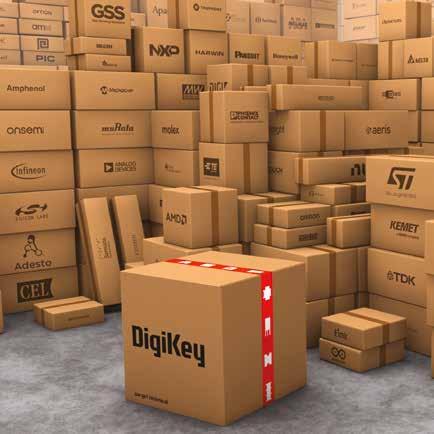





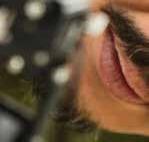


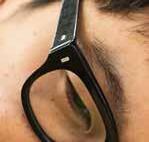


DEFENCE INDUSTRY DEFENCE INDUSTRY

Australia to grow its defence capabilities
By Tim Owen, retired Air Commodore and Chairman of Hunter DefenceAfter the last decade and the defence strategy defined in Defence White Paper 2016, Australia now finds itself in a much less certain world, in part because of the military build-up and regional assertiveness of the People’s Republic of China plus other conflicts including Ukraine and the Middle East.
This less certain world has focused the nation on a more forward-leaning strategy of ‘Deterrence, Denial and Response’ (outlined in last year’s Defence Strategic Review), and an industrial base capable of supporting that strategy.
The Defence Department released its long-awaited Defence Industry Development Strategy (DIDS) on February 29, 2024, with significant changes to Australia’s defence industrial base.
Defence Industry Minister Pat Conroy said this strategy represents a major shift in Australian industry policy.
“For the first time, it is articulating the defence industrial base the nation needs in the face of the strategic circumstances outlined in the Defence Strategic Review,” he said.
“Australia needs to grow its Defence capability, and therefore sovereign defence industrial base in areas of strategic priority, particularly when considering Australia’s diminishing geographic advantage.”
Let’s look at it in simple terms for sovereign industry.
Australia’s policies throughout the last decade, in terms of support for sovereign Defence industry as a key national capability, did not meet with much success in terms of material outcomes for the Australian Defence Force or development of the supporting industrial base in Australia.
The Government has detailed the need to “grow, support and engage with Australian defence industry” with an emphasis on ensuring the Australian defence industry must be:
1. Capable of delivering the capacity, size, and scale to meet Defence’s needs, as well as the agility to rapidly scale
2. Resilient to disruptions beyond our control by strengthening our
network of supply chains
3. Competitive by providing the systems, technologies, materials, services, and products Defence needs to support its mission
4. Innovative by maintaining a technological edge and developing the asymmetric technologies needed by Defence
In addition, DIDS has identified the three tiers of Australia’s defence industrial base.
Tier 1 businesses are the prime system integrators that provide Defence with a platform, system or product. Tier 2 businesses deliver major equipment, systems, assemblies and services. Tier 3 businesses provide parts, consumables and services.
The Government is also seeking to emphasise and expand on the broader economic impacts and opportunities provided by a viable, competitive and resilient Australian defence industrial base.
As has been articulated by many commentators, Australia’s defence industry will never be self-reliant outside of a major conflict that involves the country directly, but we should be expanding its scale and its competitiveness, particularly off the back of the mounting tensions characterising global and regional affairs.
Government has rightly defined within the DIDS a ‘prioritisation’ of the nation’s industrial capacity, which is critical to supporting the development of an industrial capability required to meet the challenges of our strategic circumstances and secure our sovereignty. That said, the Australian defence industry is constrained by three factors – absolute scale, the rate at which it can adapt or grow and the acknowledgment Australia will never be completely self-reliant.
Defence has therefore considered the immediate needs of the services, including the delivery of new material into service and support to raise, train and sustain the force in being, the needs of the future force and industry’s contribution to the prosperity of Australia, including value to trusted allies and partners. These industrial capabilities must be able to scale rapidly in times of

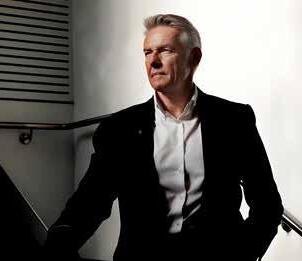
need and enable the creation and integration of emerging innovative capabilities to maintain our capability edge and deliver warfighting advantage. In that context, Defence has developed the following Sovereign Defence Industrial Priorities (SDIPs), which have been refined, and in the author’s view, are more realistic in terms of the nation’s needs compared to the previous 14 SICPs:
1. Maintenance, repair, overhaul, and upgrade of Australian Defence Force aircraft
2. Continuous naval shipbuilding and sustainment
3. Sustainment and enhancement of the combined arms land system
4. Domestic manufacture of guided weapons, explosive ordnance and munitions
5. Development and integration of autonomous systems
6. Integration and enhancement of battlespace awareness and management systems
7. Test and evaluation, certification and systems assurance
The above priorities will be driven in a ‘Pull Sense’ from Defence rather than ‘Push from Industry’, which is a significant change in the way industry interacted with the Department of Defence previously.
To ensure the SDIPs ongoing continued relevance, Defence will continue to refine, including through consultation with industry, to ensure alignment with the National Defence Strategy delivered biennially. Defence has been tasked
to work closely with Tier 2 and Tier 3 companies in this context, though engagement with Tier 1 Primes will also be critical so that the nation has the mechanisms for delivering scale, competitiveness and export opportunities. Value for money, as well as sustainment and growth for the nation’s defence industrial base, will be key drivers.
This feeds into important industry development opportunities, particularly where Defence identifies current national industrial capability and capacity cannot deliver an SDIP. Defence, supported by Tier 1 prime contractors where necessary, will identify options to uplift existing providers, or support the entry of new suppliers through targeted support such as grants through the Office of Defence Industry Support (ODIS) to help develop the workforce or purchase plant and equipment. Other finance options will also be explored through commercial means. ODIS is currently going through a major structural change to help industry access to a broader range of market opportunities in Defence, access to specialist support and services and accelerated upskilling to be more competitive and capable in priority areas.
There will no doubt be significant commentary on the pros and cons of this new industry approach by Government and we will watch closely how this evolves in the short to medium term to meet the needs of the nation’s war fighters.
Local satellite manufacturing set for takeoff in South Australia

South Australian satellite, Kanyini, successfully completed a critical testing milestone and is another step closer to launch in mid-2024.
It passed its critical Environmental Stress Screening (ESS) which verifies the satellite’s ability to withstand the rigours of space by exposing it to the harsh physical and environmental conditions it will encounter in its operational life.
Kanyini was manufactured in Adelaide’s Lot Fourteen. It underwent two weeks of challenging trials including exposing the satellite to extreme temperature variations,
intense vibrations, and crushing vacuum conditions. The satellite remained fully operational throughout the extensive testing, passing the screening with flying colours.
These results means the South Australian-based mission team is embarking on the final manufacturing phase in readiness for launch.
The launch of Kanyini marks a pivotal step for the South Australian space sector, set to build space heritage for local satellite manufacturing, Internet of Things (IoT) and mission lead capabilities – a fundamental requirement for success in the global space sector.
Once in orbit, Kanyini’s dual IoT and imager payloads will deliver critical space data to be used by government and research institutions to expand their knowledge, particularly in relation to sustainability and climate impacts.
The enhanced onboard processing capability of the Hyperscout 2 imager, together with advanced Artificial Intelligence algorithms, enables smart processing of data directly in orbit, supporting rapid decision-making for time-critical applications such as smoke detection for bushfires and a range of other services.

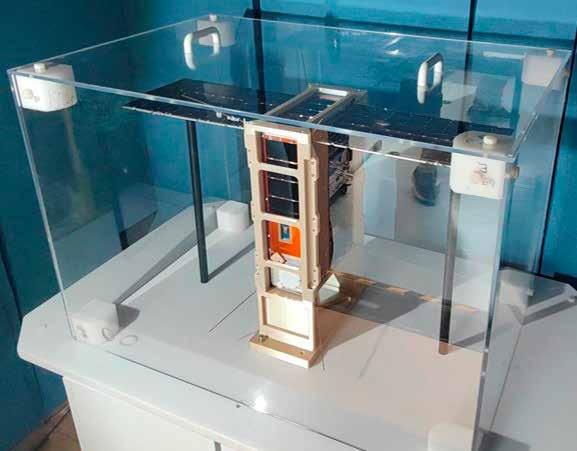
Deputy Premier of SA Susan Close said the Kanyini build is a remarkable example of South Australia’s space industry and local capability.
“The successful completion of this critical milestone brings us one step closer to realising our mission of seeing home-grown South Australian space technologies launched into low Earth orbit,” she said.
“We are excited about the possibilities that Kanyini holds both in terms of building space heritage for South Australian space companies and the information it will provide to benefit our communities and services here in South Australia.”
Kanyini Mission Director Peter Nikoloff said the milestone helped achieve one of the key goals for the mission, which was to build the capacity of the Australian space industry and advance local expertise.
“Once launched, Kanyini will unlock even more opportunities for research and development of innovative, sovereign Australian technologies,” he said.
“The collaborative effort from the whole mission team, including SmartSat CRC and our partners Myriota and Inovor Technologies, as well as the support from the South Australian Government, has been outstanding up until now. With all the payloads integrated and having passed this rigorous testing phase, Kanyini is on track for a successful mission.”
The Kanyini mission is a collaboration between the South Australian Government, the SmartSat Cooperative Research Centre as mission lead, Adelaide-based commercial satellite manufacturer Inovor Technologies, and global IoT provider Myriota.
The ESS testing was conducted at the National Space Test Facility at the Australian National University in Canberra.
Inovor founder and CEO Dr Matt Tetlow said the stellar test results validate the meticulous testing processes.
“They also exemplify the steady commitment of our team in producing world class technology,” he said.
“Our satellite bus technology is robust, resilient and ready to pioneer the next frontier of space-based applications. Our team has worked very hard over the past few years and is excited about the impact our technology will make in advancing Earth observation capabilities.”
Myriota CTO and co-founder Dr David Haley believes this milestone positions South Australia at the forefront of the national space industry.
“Collaboration with partners SmartSat CRC and Inovor Technologies has been key in leveraging home-grown expertise. Once launched, Kanyini will enhance the Myriota Network and facilitate critical IoT sensing worldwide, addressing issues such as water quality, crop health and bushfire resilience,” he said.
“Myriota is deeply rooted in South Australia and our dedicated 70-person team eagerly looks forward to Kanyini’s launch.”
Kanyini will be launched onboard SpaceX’s Transporter-11 mission from Vandenberg Space Force Base in California, USA. Follow
DEFENCE INDUSTRY
Project DFNDR awarded $6.4m federal funding
Anew initiative to streamline cyber threat detection, network defence, response and recovery for small to medium enterprises (SME) has been awarded federal funding.
Project DFNDR: Adaptive Cyber Security for Defence and Critical Infrastructure SMEs will provide a quantifiable uplift to participating SMEs, through an integrated, managed cyber security service and threat intelligence-sharing platform.
Canberra-based cyber security company, Ionize, is the recipient of the Federal Government Grant through the Cooperative Research Centres Projects (CRC-P) Round 15.
Project DFNDR will be delivered in partnership between Ionize, Cybermerc and the University of Canberra.
Ionize CEO Andrew Mulle sees Project DFNDR as tangible evidence

of a partnership and solution approach within the cyber security industry.
“Technological advancement and innovation cannot occur without strong partnerships across private enterprise, research institutions and government,” he said.
“For Australia to continue to be at the forefront of global innovation in cyber security, we need to collaborate across our industry and with academia. Advancing technological solutions is driven by data, analysis and lessons learned”.
A key element of Project DFNDR is an integrated managed security service with cyber threat intelligence sharing, delivering proactive and adaptive cyber defences. This creates a simple and effective measure to understand the cyber threat environment for an organisation.
Cybermerc CEO Matthew Nevin understands the numerous security
challenges faced by organisations.
“Project DFNDR aims to simplify and strengthen SMEs cyber security by providing a complete service across threat hunting, monitoring and intelligence to mitigate cyber attacks and share information on Advanced Persistent Threats,” he said.
The rapid adoption of technology and its increasing use across all levels of personal and professional domains has undoubtedly expanded the surface for attacks.
University of Canberra Associate Professor Information Technology and Systems, Dr Abu Barkat Ullah believes in the power of academia combined with research.
“The ability to predict, prevent and identify cyber threats attempting to exploit networks is a valuable resource, and academia and research have crucial roles to play in attaining this,” he said.
“Through our analysis and research of the telemetry provided by companies participating in Project DFNDR, researchers will have access to a significant data lake to support the development of an adaptive cyber security solution.”
Prioritisation for participation in the project will be given to companies operating within or delivering services to defence and critical infrastructure industries. There will be no costs to them during proof of concept, which is expected to take 12-15 months. The objective of the CRC-P program is to:
• Improve the competitiveness, productivity and sustainability of Australian industries, especially where Australia has a competitive strength, and in alignment with government priorities
• Foster high quality research to solve industry-identified problems through an industry-led and outcome-focused collaborative research partnerships, especially involving research organisations
• Encourage and facilitate SME participation in collaborative research
Biggest ever defence deal to make us safer and richer
 By
By
Labor has just landed the single largest defence export agreement in Australia’s history – and the deal means jobs and economic opportunity for Queensland.
Queenslanders will be building more than 100 new Boxer heavy weapon carrier vehicles at Rheinmetall Defence Australia’s Military Vehicle Centre of Excellence at Redbank in Ipswich. This new agreement will secure 600 direct jobs in Queensland, with economic opportunity flowing right through the supply chain. These armoured vehicles will be exported for use by the German Army.
The landmark export agreement,
initiated by my government last year and now endorsed by the German parliament, is worth more than $1 billion for the Australian economy.
It puts Queensland-based manufacturing at the forefront of delivering world-leading defence capability not only to the Australian Defence Force but now also to our security partner, Germany.
Supplying Australian-made armoured vehicles to Germany is an important milestone for the Australian defence industry.
This agreement represents a significant boost to our sovereign capability and it will highlight Australia’s world-leading skills.
The Boxers are highly advanced military vehicles, made in Redbank using state-of-the-art technology and manufacturing processes.
Winning this landmark export deal is a tribute to the skills and abilities of the Rheinmetall workforce at the Redbank facility. Supporting Germany’s strategic needs is a jobs opportunity for Queensland.
Labor pursues export deals like this to support Australian jobs. We want a future made in Australia.
We want a future made in Queensland – by Queenslanders.
We want a strong Australian
defence industry.
We want to support Australian technology and talent, because nurturing that capability creates opportunity and underwrites prosperity for Queensland and for the rest of the country.
Export opportunities like this are a win-win.
Hardworking Australians have secure and stable jobs while producing advanced capability for our allies and partners around the world.
A future made in Australia is about highly skilled workers, making high-value products, while getting the good pay and conditions that successive Labor governments have fought for and delivered.
Growing Australia’s defence industry is a key priority of the government, and this strategy has measurable economic benefits.
Just last week, Australian Bureau of Statistics data showed more than 100,000 jobs nationwide are supported directly and indirectly by Australia’s defence manufacturing industry. The number of defence manufacturing jobs has also risen over the past 12 months, with 3800 new jobs created in 2022-23.
But expanding the footprint of local defence manufacturing is
about more than seizing economic opportunity for Queensland and the rest of the country.
We want Australians to be safe at home, and secure in the world.
Sovereignty and safety at home and security abroad is a core priority of my government.
Growing Australia’s defence industrial base is central to that objective.
A strong local defence industry is a key pillar of Australia’s national security because it ensures we can build the equipment and platforms our ADF soldiers, sailors and air crews need to defend the country.
An innovative, resilient, internationally competitive Australian defence industrial base creates a stronger, more secure Australia.
Our actions are anchored in a strategic framework – and shaped by an overarching vision for Australia’s future and our place in the world.
When our government invests in Australia’s capability, when we invest in our international partnerships, we are investing in Australia’s ability to shape the future – and to share in the benefits of change.
This opinion piece was first published in the Courier Mail on Tuesday, 2 April 2024.
Militaries converge for tech tests
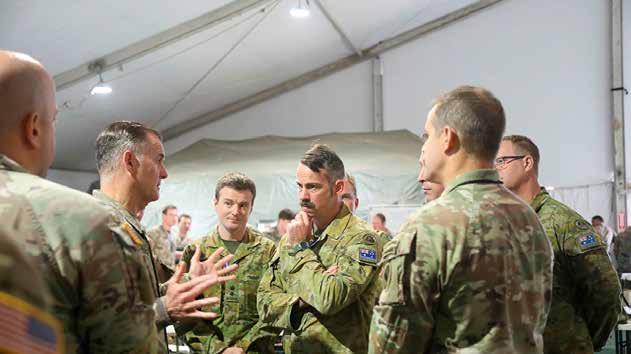
For the past month, the Australian Army has been part of Project Convergence, a US-led campaign of learning through persistent experimentation testing. Its mission is to develop networks, robotic and autonomous systems, air defence and strike-related systems.
Project Convergence was designed to aggressively advance and integrate technology across all war-fighting domains, to defeat an adversary in competition and conflict.
Run between 23 February and 20 March 2024 in California as a
two-phase ‘in the dirt’ experiment, the project was hosted by the US army, Air Force, Marine Corps and Space Force. Participants included the United Kingdom, Australia, Canada, New Zealand, France and Japan.
Colonel Casey Guidolin, Director
Australian Defence Force MultiDomain Strike, said being part of Project Convergence meant the ADF could test more new and emerging technologies as a part of a coalition force.
“The ADF continues to test and invest in new and emerging technologies through multinational activities such as Project Convergence.
“In a time of heightened competition and conflict, working with the militaries of our allies and partners ensures we can work together as an integrated force in all warfighting domains on national defence.”
“Project Convergence Capstone Four provided Australia with the opportunity to work closely with allies and partners to promote a stable and prosperous Indo-Pacific region,” Colonel Guidolin said.
This year’s event provided the Australian Army the opportunity to test capability modernisation as an integrated force for Australia’s national defence across all warfighting domains – land, air, sea, space, cyber.
Approximately 120 Australian soldiers were involved, building skills and relationships with international partners and allies.
‘Moon to Mars’ supports local space innovators
Australia’s space industry is getting a $9m injection from the federal government under the latest funding round of the Moon to Mars Supply Chain Capability Improvement program.
A dozen projects which align with NASA’s Artemis mission will share in more than $9 million which aims to help drive Australian science and innovation and help local companies get into global space supply chains. The supported projects include:
• Valiant Space (Qld) will receive $934,500 to develop a new nontoxic propulsion system that will support more sustainable and responsible use of space.
• NextAero (VIC) will receive $1,000,000 to design, manufacture and validate cutting-edge cryogenic rocket propellants, which are predicted to be central to next-generation sustainable spacecraft and rocket systems.
• HEO (NSW) will receive $742,164 to develop advanced cameras for imaging satellites to better track space debris and objects, ensuring safe and sustainable use of space.
• Neumann Space (SA) will receive $1,000,000 to locally develop a
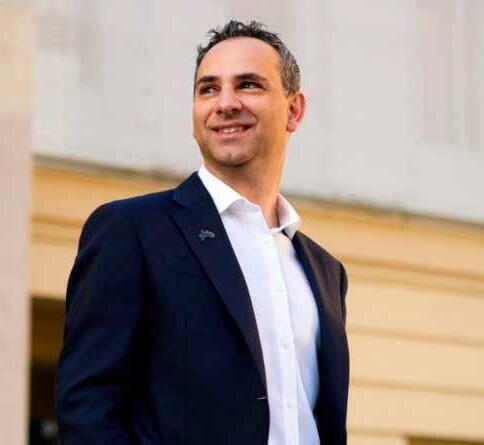
world-class spacecraft electric propulsion manufacturing and test facility, to support national and international space missions.
Head of the Australian Space
Agency Enrico Palermo said projects winning Moon to Mars grants show the agility and innovative nature of Australia’s space companies, and how Australia can carve its niche in
big international missions.
“Space is a global endeavour and by working with partners like NASA we can create outcomes that benefit Australia, while also contributing to solutions to global challenges.”
Minister for Industry and Science Ed Husic said the projects show that exceptional research and innovation is happening in Australia’s space sector and how local companies can contribute on the global stage.
“Excitingly, the technologies and products being developed also have applications that can see us respond to [other] important challenges and opportunities – from addressing climate change to driving growth in government priority areas like robotics, quantum and advanced manufacturing,” Minister Husic said.
More Australian manufacturers in solar supply chain
Australian manufacturer of tube and pipe Orrcon Steel has agreed to manufacture and deliver critical Australian-made components for California-based Nextracker’s solar trackers which are used on distributed generation and utility-scale solar farms.
Orrcon is a subsidiary of BlueScope Steel and the first of its Australianmade steel components will be delivered to ACCIONA Energia’s 480MWp Aldoga Solar Farm which will be built near Gladstone.
Critical steel components will be produced from BlueScope’s steel coil at Orrcon Steel’s Salisbury Tube mill in Brisbane and finished at its Northgate site by Nextracker’s Malaysian-based OEM partner, Baojia New Energy Manufacturing.
Baojia’s new production line at Orrcon’s facility was officially opened on March 14 by Queensland Minister for Energy and Clean Economy Jobs, Mick de Brenni MP, Chief Executive BlueScope Australian Steel Products Tania Archibald, Chair of the Australian Steel Institute and also General Manager of Orrcon Steel Tony Schreiber, and General Manager of Nextracker Australia, Southeast Asia, New Zealand, Peter Wheale.
Tony Schreiber said Orrcon Steel is one step closer to its goal of a significant role in Australia’s
renewable energy supply chain.
“Our investment also includes a large tubular mill at Unanderra, NSW, tooling to produce solar torque tubes and increased warehouse capacity — positioning our business as a key supplier of products for the rapidly expanding renewable energy sector.
“The collaboration with Nextracker and Baojia is another example of how we’re making a difference in the utility-scale solar industry with an Australian-made, high-quality product.”
Tania Archibald Chief Executive of BlueScope Australian Steel Products said BlueScope has more than $2 billion committed to its future as a sustainable manufacturer for Australia’s energy transition.
Peter Wheale, Nextracker GM for Australia, Southeast Asia, and New Zealand said the agreement strengthens Nextracker’s commitment to local supply chains for delivering energy security to Australians.
“The manufacturing facility in Queensland will accelerate Nextracker’s ability to deliver faster to our customers in Australia and support large solar farms with quality, high-performing solar tracker systems.”
Minister for Energy and Clean Economy Jobs Mick de Brenni said the investment is proof that
Incat named one of Australia’s best managed companies
Deloitte Private’s Best Managed Companies Program celebrates private company excellence worldwide, recognising companies that demonstrate outstanding business performance, sustained growth and organisational prowess.
The prestigious program named Incat Tasmania as one of Australia’s Best Managed Companies for 2023. Incat, an industry leader in aluminium shipbuilding, was one of nine winners.
The program’s independent judges evaluated companies based on the four key pillars of strategy, culture and commitment, capabilities and innovation, and governance and financials.
Incat Managing Director Craig Clifford received the award on behalf of Incat and attributes it to

Queensland’s renewable energy and emissions reduction policies are attracting some of the world’s largest manufacturers.
“Orrcon’s decision to invest in Queensland sends the message to other global companies – Queensland is ready, and open for business. We’re making the materials needed to transition not only Queensland, but the rest of the world to a renewable energy future.”
Orrcon’s facility has been commissioned to produce up to 50,000 tonnes of torque tubes, the equivalent of over 2.5GW of utility-scale solar farms. Orrcon’s steel tubular products are used by steel fabricators, furniture and trailer body
manufacturers, housing, construction and renewables companies, as well as pipeline and infrastructure engineering firms.
According to industry analyst Rystad, Nextracker is the market leader for solar tracker systems in Australia with 7.45 GWdc installed or under fulfilment in 13.5 GWdc of utility-scale PV assets. Nextracker’s award-winning technology has also been used on some of the country’s largest projects: New England Solar Farm (521 MWd), Stubbo Solar Farm (520 MWd) and Western Downs (460 MWd). Nextracker has plants operating in more than thirty countries worldwide.
the efforts of the entire workforce.
“This award belongs to every single worker at Incat and reaffirms our commitment to innovation, quality, customer satisfaction, and environmental sustainability,” he said.
“At our core, we’re a family company with family values and our dedication to workforce development and employee well-being is paramount to our success as a business. Incat has always worked hard to provide the best in training and development opportunities and foster a culture of learning and improvement. This award will only strengthen that commitment further.”
Deloitte Private Lead Partner, and Best Managed Companies Asia Pacific Leader, Natalie Faull said the award is about recognising organisations that go above and beyond.

“Our Best Managed Companies Program is about celebrating the passion, dynamism, resilience and focus on sustainable growth that typify Australia’s best managed private businesses,” she said.
“Just like Incat Tasmania, they are purpose-driven, disciplined organisations, industry leaders and significant employers. They are navigating the future with confidence,
and setting a very high bar for what success can look like for a private business in Australia.”
The Best Managed Company award adds to Incat’s list of accolades, including eight Exporter Awards at the Tasmanian Export Awards and the 2022 Large Employer of the Year at the Tasmanian Training Awards.
$275m in grants for NSW’s clean energy revolution
Under the Net Zero Manufacturing Initiative, the NSW government will allocate $275 million in grants to help ensure NSW has a big part in the clean energy revolution and create new jobs.
The Net Zero Manufacturing Initiative will support SMEs, manufacturers and innovators to take advantage of the transformation of the energy grid.
It will focus on already labproven technologies and the manufacturing of market-ready products that are ready to be scaled up and rolled out across NSW.
NSW Premier Chris Minns said the funding is for small and medium-sized businesses wanting to pilot new technology within their premises.
“This is all about supporting and backing NSW businesses, manufacturers and innovators to develop home-grown technology and products right here in the state, and securing the jobs and skills we need for a renewable energy future.”
Minister for Climate Change and Energy Penny Sharpe said the transformation of NSW’s energy grid will transform the economy.
“These grants are all about ensuring NSW manufacturing is part of this revolution. They will lead to new secure, long-term jobs that are good for the planet but also build wealth in local communities and give NSW security and sovereignty of the renewable energy supply chain.”
The investment areas are aligned to opportunities identified through the NSW Decarbonisation Innovation 2023 Study, released by the Office of Chief Scientist and

Engineer. This includes future energy systems and storage, transportation, built environment, biomanufacturing, power-fuels including hydrogen and agricultural technologies.
The initiative offers these grants: Renewable Manufacturing – increasing capacity to make components for renewable energy projects, which will alleviate supply chain constraints and increase local content capability. For example, projects could include constructing a new facility for the manufacture of solar cells, or supply chain parts for renewable energy transmission.
Clean Technology Innovation
– helping businesses get scalable low-emission technologies commercialised and ready to be marketed. For example, prototypes of next generation residential batteries, or new laboratory equipment that can test a material’s ability to store hydrogen atoms.
Low Carbon Product Manufacturing – establishing industrial facilities and manufacturing capabilities that can take advantage of investment in new and emerging low carbon industries.
For example, building a new facility for the manufacture of low-carbon laminate timber, or
implementing a new production line within an existing biomass facility for manufacturing bio-diesel.
This will support NSW’s five Renewable Energy Zones and hydrogen hubs, giving them access to more materials produced in NSW. The initiative will deliver more local, secure jobs across the state, and support the diversification of our regional economies.
To check your eligibility and apply
What’s poor lubrication costing you?
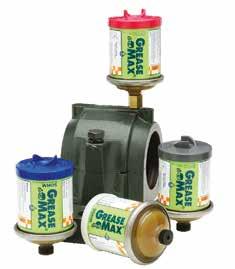
FROM THE
OEd Husic Government grants $51m to local innovators
ur government’s aim to make more things in Australia, with the best Aussie know-how, is about much more than helping new job-creating industries thrive. It’s also about applying our world-renowned practical thinking to solve some of the biggest problems facing our society.
Take bushfires, for example, which are getting bigger and more unpredictable with the onset of a warming climate. In western Sydney exciting aeronautical start-up AMSL Aero has been turning its attention to how its technology can be used to more effectively combat the threat bushfires pose to Australian communities.
This Bankstown Airport-based firm has developed an electric vertical take-off and landing (eVTOL) aircraft called Vertiia, which can carry payloads of up to 500kg.
The helicopter-like aircraft can use hydrogen as a fuel source, giving it a range of 1000km, about four times greater than comparable battery-reliant autonomous aircraft. This means
Vertiia could potentially operate in regional areas fighting fires or carrying out aeromedical missions.
This is where the Australian government is stepping up.
In February, I announced $51 million in Cooperative Research Centres Projects (CRC-P) grants supporting collaboration between industry and researchers on important and transformative projects.
One such grant, for $3 million, has been awarded to a consortium comprising AMSL Aero, the University of Sydney, Pay’s Air Service and Mission Systems. It will help progress development of the Vertiia as an autonomous firefighting drone, as well as enabling further flight testing and work to secure regulatory approvals.
Another CRC-P grant of $3 million was awarded to a consortium working on large-scale solar panel recycling.
PV panels have a 25-30 year lifespan and it’s anticipated that from 2035 around 80 million panels across Australia will need to be dismantled. With a typical 20kg
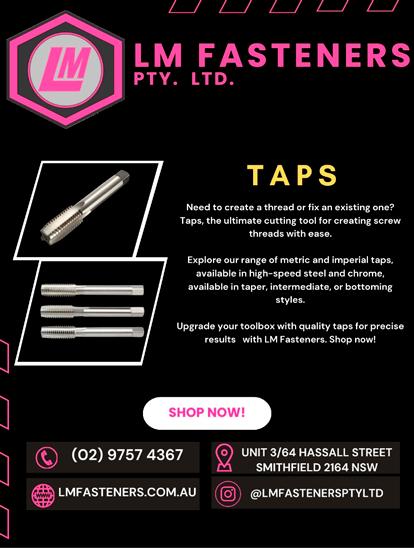
Minister for Industry and Science



panel having recoverable materials of around $22, there is enormous potential for glass, aluminium, silicon, copper and silver to be reclaimed and fed back into the PV supply chain or diverted to other industries.
“Cooperative Research Centres Projects grants support collaboration between industry and researchers on important and transformative projects.”
The $3 million grant to PV Industries, the University of NSW, ReSource, and Spark Renewables will support further development of processes for testing and recycling solar panels using machine learning.
The CRC Program is a proven model for delivering real outcomes across industries – from manufacturing to agriculture, health, artificial
intelligence, energy, mining, and of course aerospace and waste recycling.
Since 1991, the Australian government has awarded $5.8 billion in CRC Program funding.
This funding has helped leverage $17.4 billion in cash and in-kind contributions from industry, research and other organisations.
To further underline the value of CRC Program, more than 35,400 commercialisation agreements have eventuated from the work that was generated – and 140 spinoff companies created.
There will be further CRC-P funding rounds and grants in coming months – and I urge companies looking to commercialise Australian innovation to check their eligibility to apply.
I’d also urge people in small and medium enterprises grappling with the challenge of adopting artificial intelligence to consider new AI scholarships being provided by the National AI Centre.
Coordinated by the CSIRO and the Institute of Applied Technology Digital, the course will provide a non-technical introduction to AI fundamentals for people at the beginning of their AI literacy journey.
This makes it ideal for individuals starting their career in AI, workers seeking to upskill – as well as owners of SMEs.
Lubrication can be critical
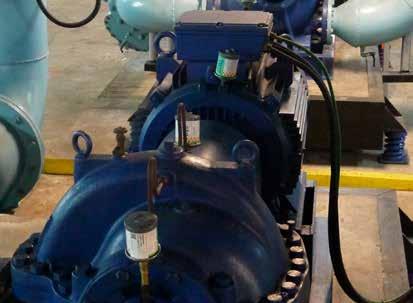
All large buildings — offices, hotels, shopping malls, hospitals, sports venues — have heating, ventilation and air conditioning [HVAC] plant and equipment.
Lubrication is a critical factor for reliability of HVAC plant and equipment. In many instances greasing is done by hand which is costly and the ensuing re-lubrication intervals are not ideal for optimum plant reliability.
GreaseMax lubricators are not affected by humid or wet conditions and provide an effective solution for HVAC applications:
• Continuous lubrication eliminates grease degradation issues that arise in difficult operating conditions, for example, where heat and humidity are factors
• Reduces physical access issues
• GreaseMax lubrication minimises or eliminates lubrication-related failures
• GreaseMax has the capacity to pump through feed lines which are often needed
GreaseMax’s efficient operation :
• provides continuous lubrication at a constant rate, for a set period
• is self-regulating and operates without maintenance or adjustment. Its discharge rate is not affected by bearing condition, seal condition or grease-way resistance.
• has no electrics or mechanical items and so is completely reliable. At the end of its operating period, GreaseMax is quickly and simply changed over.
• can be used on moving and vibrating applications, long feed lines and underwater.
• is intrinsically safe – including for static discharge.
GreaseMax lubricators, made in Germany, have been used in every type of industry for over 30 years.
Greasemax
greasemax.au
Choosing the right springs: torsion, compression or extension

In the world of mechanical engineering, springs play a pivotal role in a wide array of applications, from automotive systems to industrial machinery. Among the various types of springs, three distinct players take centre stage: torsion, compression and extension springs.
Selecting the right spring can significantly enhance the performance and efficiency of diverse systems. Understanding their unique characteristics is crucial for engineers seeking optimal solutions for a multitude of tasks.
Compression springs
Ideal for applications requiring high load-bearing capacity, compression springs generate linear forces during compression. While they offer predictable behaviour, they provide less precise control over angular displacement compared to torsion springs.
Common applications include cylinders, valves, and vibration dampening systems.
Extension springs
Suited for linear force and
straight-line motion needs, extension springs offer stable behaviour with predictable linear compression and extension characteristics. They allow for tension adjustment by altering extension, making them suitable for applications like trampolines and screen doors.
Torsion springs
Known for their torque transmission capabilities, torsion springs excel in rotary motion applications. While they offer precise control over angular deflection, their behaviour can be nonlinear. Examples of use include garage doors, automotive trunks and mechanical clocks. Choosing the right spring type is crucial for enhancing system performance. For expert advice and assistance tailored to your project needs, get in touch with Marsh Alliance, Australia’s leading cold coil spring manufacturer with over 70 years of experience.
Marsh Alliance marshalliance.com.au
What’s poor lubrication costing you?
www.greasemax.au

Upcoming Events
AMW 2024
17-19 April 2024 | ICC, Sydney
Australia’s premier manufacturing technology trade show, Australian Manufacturing Week (AMW 2024), promises to be a dynamic event that brings together professionals, companies and experts from many industries related to manufacturing, engineering and technology. Organiser AMTIL’s goal is that AMW 2024 is more than an exhibition. Rather, it is to be the centrepiece of a week-long celebration of manufacturing in Australia.
australianmanufacturingweek.com.au
Sydney Build Expo
1-2 May 2024 | ICC, Sydney
Now in its 8th year, Sydney Build is the best-attended Construction & Design Event in the whole of Australia. The two-day event showcases all the latest opportunities in NSW and Australia. The event connects all key players in the industry and attracts attendees from: contractors, architects, engineers, house builders, developers, government and construction professionals.
sydneybuildexpo.com
Foodservice Australia
19-21 May 2024 | ICC, Sydney
Don’t miss this chance to see the latest equipment, taste the food trends and find out what’s new in the industry. Discover over 450 exhibitors plus chef competitions, three conferences and plenty of free workshops and demonstrations.
foodserviceaustralia.com.au
ARBS 2024
28-30 May 2024 | ICC, Sydney
ARBS 2024, the Air Conditioning, Refrigeration & Building Services Exhibition, is Australia’s only international HVAC&R and building services trade show. ARBS provides the most comprehensive range of HVAC&R and building services products and solutions in one location, allowing the entire industry to connect across three days. arbs.com.au

Electronex
19-20 June 2024 | Rosehill Gardens, Sydney
Australia’s major dedicated expo and conference for the electronics industry, Electronex, returns to Sydney at Rosehill Gardens Event Centre in 2024. At Electronex designers, managers, engineers, technicians, manufacturers and system integrators can discuss their specific requirements with industry experts and see, test and compare the latest products and solutions to future proof their business.
electronex.com.au
CeMAT
23-25 July 2024 | MCEC, Melbourne
The CeMAT exhibition will be a onestop-shop of the leading technology and service providers in intralogistics, robotics and automation, warehousing, supply chain management and materials handling. CeMAT will showcase innovation and best practices in a wide variety of settings and sectors – from e-commerce to manufacturing, from the food industry to resources.
cemat.com.au
Australian Waste & Recycling Expo
24- 25 July 2024 | ICC, Sydney
Discover an exciting showcase of full circle innovative products and sustainable solutions to collect, process and recycle waste more smartly. Future critical areas include Machinery & Equipment, Software & Services, Bins, Vehicles, Food & Organics and more.
awre.com.au
LAND FORCES 2024
11-13 September 2024 | MCEC, Melbourne
A variety of exhibition and participation options are available and, as a centrepiece regional exhibition, the opportunities for business engagement at Land Forces will be considerable. In addition to hosting senior international military, defence, government, scientific and industry delegations from around the world, Land Forces will attract a comprehensive array of defence professionals and trade visitors at all levels.
landforces.com.au
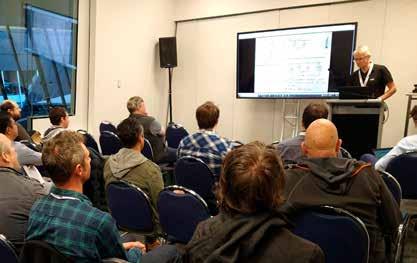
Learn from the best at the SMCBA Conference
Those involved in designing or manufacturing electronics will be marking their calendar for one of the most innovative knowledge opportunities of the year.
The 2024 SMCBA Electronics Design and Manufacture Conference is scheduled for June 18-20. Attendees will learn things they can execute immediately, literally allowing them to do their job better the next day.
Global leaders in their field will deliver presentations on topics ranging from the implementation of Industry 4.0 in electronics manufacturing to key aspects of printed circuit board design, as well as the evolution of the solder alloys and soldering processes that are used to assemble the final product.
The conference is organised by the Surface Mount and Circuit Board Association (SMCBA) as part of its commitment to ensuring local industry is kept up to date on the continuously evolving electronics design and manufacturing processes. The SMCBA was established more than three decades ago to help the local electronics manufacturing industry transition to surface mount technologies.
With the electronics manufacturing industry in Australia focussing on export markets and the local manufacture and support of defence material, it is critical that design and manufacture is compliant with internationally recognised standards.
The SMCBA recognised early on the importance of compliance with standards and entered into a licensing agreement with the US-headquartered IPC to provide training and certification to the latter’s internationally recognised
standards. Which is why it’s excited to announce IPC’s Vice-President, Standards and Technology, David Bergman, will be a keynote speaker at the conference, his talk is titled; “Digitalisation of Electronics Manufacturing- Towards Smart Factory Enabling Industry 4.0”.
Bergman’s high level view will be complemented by a series of presentations by specialists in their field including US-based PCB design experts, Mike Creeden and Rick Hartley and Australian Design for Test expert, Chris Turner. Returning to Australia for the third time, Dave Hillman will share what he has learned in a lifetime on the front line of manufacturing and testing defence and aerospace electronics.
There will also be some lighthearted fun at the 2024 IPC Global Hand Soldering Competition for anyone who wants to put their techniques to the test.
IPC and SMCBA will be running the Australasian Round of the competition at the concurrent ElectroneX Expo June 19-20. The winner has the opportunity to represent Australasia at the international finals in Munich.
A hand soldering competition was held in Australia for the first time as a local event during the 2023 SMCBA Conference in Melbourne and attracted a lot of interest. With its status now elevated to a round in the global context, the competition is expected to be fierce.
Security seals offer more than just safety
It makes sense that manufacturing and packaging businesses need to keep their inventory safe. Which is where tamper evident security seals come in. They’re highly visible, which acts as a deterrent against theft, unauthorised access and contamination.
The benefits of fast identification of potential breaches are obvious, but security seals offer businesses other valuable advantages.
They play a critical role in maintaining the integrity of goods, assets, and confidential information through tracking and inventory management and assist with regulatory compliance.
Harcor’s range of security seals reveal tamper evidence during manufacture, warehousing and commercial packaging while also protecting products from spoiling and unnecessary shrinkage.
Unique serial numbers on security seal products makes them easy to track and ensures accountability throughout the supply chain. Serial numbers help with faster identification of compromised goods and




process improvement opportunities.
Tamper evident seals help with compliance and regulatory requirements.
Industries that operate under strict regulations and safety standards, such as pharmaceutical, transportation and foodstuffs, can rest easy that these seals help protect their business, employees and consumers.
The best physical key management systems
Part of a robust risk management strategy is understanding how to protect a company’s assets, facilities and sensitive information. One component of an effective security system is key management.
A key management system allows businesses to maintain control over their keys. The advantages of key tracking include increased productivity, streamlined operations and better security.
Not all key management systems are created equal. Depending on the size of an organisation, it may not need all the latest features, however, it’s important to consider what it



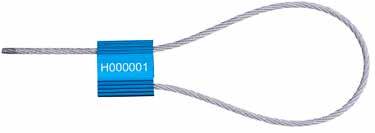

might need now and in the future. Harcor can assist organisations in selecting key management systems to suit their business.













